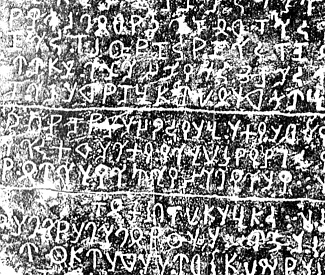

Zitierweise / cite as:
Payer, Alois <1944 - >: Quellenkunde zur indischen Geschichte bis 1858. -- 5. Unbewegliche Hinterlassenschaften. -- 1. Zum Beispiel: Taxila (ٹیکسلا, तक्षशिला, Takkasilā). -- Fassung vom 2008-04-20. -- http://www.payer.de/quellenkunde/quellen051.htm
Erstmals publiziert: 2008-04-17
Überarbeitungen: 2008-04-20 [Ergänzungen]
Anlass: Lehrveranstaltung FS 2008
©opyright: Dieser Text steht der Allgemeinheit zur Verfügung. Eine Verwertung in Publikationen, die über übliche Zitate hinausgeht, bedarf der ausdrücklichen Genehmigung des Verfassers
Dieser Text ist Teil der Abteilung Sanskrit von Tüpfli's Global Village Library
Falls Sie die diakritischen Zeichen nicht dargestellt bekommen, installieren Sie eine Schrift mit Diakritika wie z.B. Tahoma.
Taxila (ٹیکسلا, तक्षशिला, Takṣaśila, Takkasilā) liegt im Sind Sāgar Doāb ("Zweistromland") zwischen den Flüssen Jhelam (Jhelum) (دریاۓ جہلم, ਜੇਹਲਮ, झेलम) und Indus (Sindhu) (سندھ , ਸਿੰਧੂ, सिन्धु , حندو , ّآباسن , 印度 ,Ινδός) am Fuße der Murree (مری) Hills.
"Taxila (Urdu: ٹیکسلا, Sanskrit: तक्षशिला Takṣaśilā, Pali:Takkasilā) is an important archaeological site in Pakistan containing the ruins of the Gandhāran city of Takshashila (also Takkasila or Taxila) an important Vedic/Hindu and Buddhist centre of learning from the 6th century BCE to the 5th century CE. In 1980, Taxila was declared a UNESCO World Heritage Site with multiple locations. Historically, Taxila lay at the crossroads of three major trade routes: the royal highway from Pāṭaliputra; the north-western route through Bactria, Kāpiśa, and Puṣkalāvatī (Peshawar); and the route from Kashmir and Central Asia, via Śrinagar, Mānsehrā, and the Haripur valley across the Khunjerab pass to the Silk Road.
Taxila is situated 35 km to the west of Islamabad Capital Territory—and to the northwest of Rawalpindi in Punjab—just off the Grand Trunk Road."
[Quelle: http://en.wikipedia.org/wiki/Taxila. -- Zugriff am 2008-04-17]
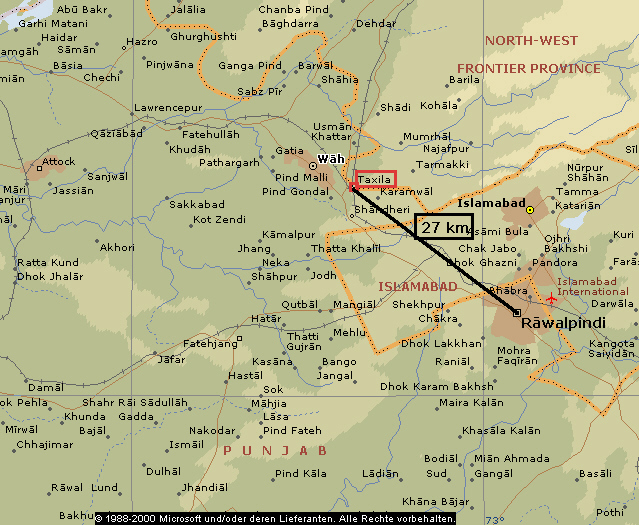
Abb.: Lage von Taxila
[©MS Encarta]
Panoramabilder: http://www.world-heritage-tour.org/asia/south-asia/pakistan/taxila/map.html. -- Zugriff am 2008-03-20. -- Sehenswert!
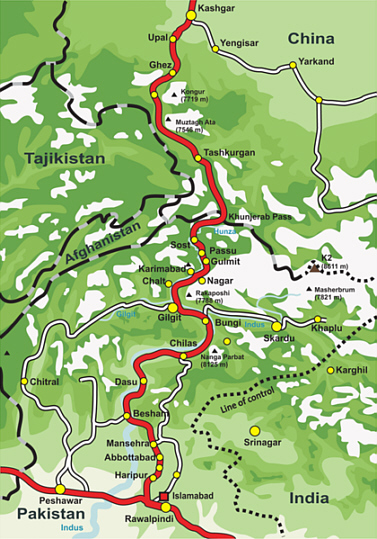
Abb.: Der Karakorum Highway nach Kashgar (Kaxgar; Uigurisch:
قەشقەر; 喀什)
folgt ungefähr der alten Handelsroute von Taxila nach Norden
[Bildquelle: Wikipedia, GNU FDLicense]
Hauptvorlage:
Marshall, John <1876 - 1958>: A guide to Taxila / by Sir John Marshall. - 4. ed.. - Karachi : Sani Communications, 1983. - V, 195 S. : Ill. ; 23 cm. -- Cambridge : University Press, for the Dept. of Archaeology in Pakistan, 1960. -- S. 40 - 46.
Viele Jahreszahlen sind nur Anhaltspunkte ohne gesicherte Grundlage!
538 - 530 v. Chr.
Kyros II. von Persien (کوروش, Kūruš, Kuraš, כורש, Cyrus) (590/580 - 530 v. Chr.) aus der Achämeniden-Dynastie erobert Baktrien (538), dann Gandhāra und dringt in den Panjāb bis zum Indus vor.
Abb.: Das Perserreich unter Kyros II.
[Bildquelle: Wikipedia, GNU FDLicense]
522 - 486 v. Chr.
Vermutliches Datum der ersten Stadt auf dem Bhiṛ Mound.
Die Perser führen Aramäisch (ܐܪܡܝܐ) als Amtssprache ein.
ca. 518 v. Chr.
Dareios I. (داریوش, Darayavahuš, Dariamuš, Dariyamauiš, Dryhwš, Ahasveros, Darius) (549 - 486 v. Chr.) gliedert Nordwestindien samt Taxila dem Perserreich ein.
Abb.: Das Perserrreich unter Dareios I. (um 500 v. Chr.)
[Bildquelle: Wikipedia, Public domain]
ca. 515 v. Chr.
Skylax von Karyanda (Σκύλαξ ο Καρυανδεύς) erforscht im Auftrag von Dareios I u.a. den Unterlauf des Indus
326 v. Chr.
Abb.: Alexander der Große als Zeus Ammon (Ζεύς Ἄμμων), zeitgenössische Kamee (um 325 v. Chr.)
[Bildquelle: Wikipedia, GNU FDLicense]
Abb.: Tatradrachme Alexanders des Großen. Solche Münzen wurden auch in Taxila gefunden.
[Bildquelle: Wikipedia, GNU FDLicense]Ambhi, König von Taxila, unterwirft sich Alexander dem Großen (Ἀλέξανδρος ὁ Μέγας) von Makedonien (356 - 323 v. Chr.). Alexander besiegt den indischen König Puru (Poros/Πόρος) in der Schlacht am Hydaspes = Jhelam (झेलम, دریاۓ جہلم, ਜੇਹਲਮ). Philipp (Φιλιππoς), Sohn des Machatas wird Satrap von Taxila.
Abb.: Alexanders Feldzüge im Osten
[Bildquelle: Wikipedia, GNU FDLicense]
326 v. Chr.
Philipp (Φιλιππoς), Sohn des Machatas wird ermordet. An seine Stelle treten Eudemos (Eύδημoς) (gest. 316 v. Chr.) und Taxiles/Taxilas (Tαξίλης/Ταξίλας)
Abb.: Östliche Satrapen
[Bildquelle. Wikipedia, Public domain]
323 v. Chr.
Tod Alexanders des Großen (Ἀλέξανδρος ὁ Μέγας) von Makedonien (356 - 323 v. Chr.) in Babylon.
ca. 317 v. Chr.
Eudemos (Eύδημoς) (gest. 316 v. Chr.) zieht sich aus dem Nordwesten Indiens zurück. Candragupta Maurya (चन्द्रगुप्त मौर्य, Σανδρόκυπτος / Σανδρόκοττος) (ca. 340 - 298 v. Chr.) nimmt den Panjāb in Besitz.
312 v. Chr.
Beginn der Seleukidenära.
305 v. Chr.
Abb.: Münze von Seleukos I. Nikator (Σέλευκος Α’ Νικάτωρ)
[Bildquelle: Wikipedia, GNU FDLicense]Seleukos I. Nikator (Σέλευκος Α’ Νικάτωρ) (358 - 281 v. Chr.) marschiert in Nordostindien ein, wird von Candragupta Maurya geschlagen und schließt mit diesem einen Friedensvertrag.
ca. 300 v. Chr.
Megasthenes (Μεγασθενής) wird Gesandter von Seleukos I. Nikator am Hof Candragupta Mauryas in Pāṭaliputra (heute Patna/पटना).
298 v. Chr.
Tod Candraguptas. Sein Nachfolger wird sein Sohn Bindusāra (बिन्दुसार). Bindusāras Sohn Aśoka wird Vizekönig in Taxila. Deimachus (Δηιμάχος) wird Gesandter von Seleukos I. Nikator am Hof Bindusāras in Pāṭaliputra (heute Patna/पटना).
ca. 268
Aśoka (अशोक) Maurya, der Sohn Bindusāras wird dessen Nachfolger.
ca. 250
Abb.: Goldmünze von Diodotos I. Solche Münzen wurden auch in Taxila gefunden.
[Bildquelle: Wikipedia, GNU FDLicense]Diodotos I. spaltet Baktrien vom Seleukidenreich ab und begründet das Griechisch-Baktrische Königreich. Arsakes I. (ارشک) spaltet das Partherreich vom Seleukidenreich ab.
Abb.: Partherreich und Griechisch-Baktrisches Reich um 250 v. Chr.
[Bildquelle: Wikipedia, GNU FDLicense]
ca. 233 v. Chr.
Tod Aśokas. Allmählicher Zerfall des Maurya-Reichs.
206 v. Chr.
Der Seleukidenkönig Antiochos III. der Große (242 - 187 v. Chr.) schließt mit Euthydemos I. von Baktrien (Ευθύδημος Α΄ της Βακτρίας) Frieden und marschiert im Tal von Kabul (کابل) ein, dort unterwirft sich ihm der Maurya-Gouverneur Subhāgasena (Sophagasenus)
ca. 189 v. Chr.
Abb.: Demetrios I. ANIKETOS ("Der Unbesiegbare), unter Agathocles geprägt. Solche Münzen wurden auch in Taxila gefunden.
[Bildquelle: Wikipedia, GNU FDLicense]Demetrios I. (Δημήτριος) wird in Nachfolge seines Vaters Euthydemos I. König von Baktrien und erobert Gandhāra, den Panjāb und das Industal. Er erbaut seine Hauptstadt in Taxila.
Die darauf folgenden Könige des Griechisch-Baktrischen bzw. Indo-Baktrischen Reiches sind (Angaben ohne Gewähr!):
Unterkönige in Gandhāra waren ab Menander:
- Antimachus II (Αντιμαχος
- Polyxenus (Πολύξενος)
- Epander (Επανδρος)
- Philoxenus Φιλοξενος
- Diomedes (Διομήδης)
- Artemidorus (Ἀρτεμίδωρος)
"List of the Indo-Greek kings and their territories Today 36 Indo-Greek kings are known. Several of them are also recorded in Western and Indian historical sources, but the majority are known through numismatic evidence only. The exact chronology and sequencing of their rule is still a matter of scholarly inquiry, with adjustments regular being made with new analysis and coin finds (overstrikes of one king over another's coins being the most critical element in establishing chronological sequences). The system used here is adapted from Osmund Bopearachchi, supplemented by the views of R C Senior and occasionally other authorities.
INDO-GREEK KINGS AND THEIR TERRITORIES
Based on Bopearachchi (1991)Territories/
DatesPAROPAMISADAE
ARACHOSIA GANDHARA WESTERN PUNJAB EASTERN PUNJAB 200-190 BCE Demetrius I 190-180 BCE Agathocles Pantaleon 185-170 BCE Antimachus I 180-160 BCE Apollodotus I 175-170 BCE Demetrius II 160-155 BCE Antimachus II 170-145 BCE Eucratides 155-130 BCE Menander I 130-120 BCE Zoilos I Agathokleia 120-110 BCE Lysias Strato I 110-100 BCE Antialcidas Heliokles II 100 BCE Polyxenios Demetrius III 100-95 BCE Philoxenus 95-90 BCE Diomedes Amyntas Epander 90 BCE Theophilos Peukolaos Thraso 90-85 BCE Nicias Menander II Artemidoros 90-70 BCE Hermaeus Archebios Yuezhi tribes Maues (Indo-Scythian) 75-70 BCE Telephos Apollodotus II 65-55 BCE Hippostratos Dionysios 55-35 BCE Azes I (Indo-Scythian) Zoilos II 55-35 BCE Apollophanes 25 BCE- 10 CE Strato II Rajuvula (Indo-Scythian) [Quelle: http://en.wikipedia.org/wiki/Indo-Greek. -- Zugriff am 2008-04-06]
ca. 184 v. Chr.
Puṣyamitra (regiert ca. 184 - 150 v. Chr.) ermordet den letzten Maurya und begründet die Śuṅga-Dynastie.
ca. 180 - 169 v. Chr.
Eine griechische Armee vertreibt Puṣyamitra aus Sagala (heute Sialkot سیالکوٹ) und dringt bis Pāṭaliputra (heute Patna) vor.
ca. 175 v. Chr.
Apollodotus I (Απολλόδωτος Α΄) wird Nachfolger von Agathokles (Αγαθοκλής) (ca. 182) in Taxila und anderen griechischen Territorien westlich des Jhelām
ca. 165-163 v. Chr.
Abb.: Silbertetradrachme Eukratides' I. Solche Münzen wurden auch in Taxila gefunden.
[Bildquelle: Wikipedia, Public domain]
"Obv: Bust of Eucratides, helmet decorated with a bull's horn and ear, within bead and reel border.
Rev: Depiction of the Dioscuri, each holding palm in left hand, spear in righthand. Greek legend: ΒΑΣΙΛΕΩΣ ΜΕΓΑΛΟΥ ΕΥΚΡΑΤΙΔΟΥ (BASILEŌS MEGALOU EUKRATIDOU) "Of Great King Eucratides". Mint monogram below.
Characteristics: Diameter 32 mm. Weight 15.9 g. Attic standard. One of the largest Hellenic coins ever minted."[Quelle: http://en.wikipedia.org/wiki/Eucratides_I. -- Zugriff am 2008-04-07]
Eucratides I (ca. 170 - 145) beseitigt die Dynastie der Nachfolger von Euthydemos I. von Baktrien (Ευθύδημος Α΄ της Βακτρίας) und begründet seine eigene Dynastie. Er stoßt bis in den Hindukush und Gandhāra vor. Ob er den Indus überschritt und Taxila erreichte, ist unklar.
ca. 165/155
Abb.: Münze Menanders (Rückseite Athene). Solche Münzen wurden auch in Taxila gefunden.
[Bildquelle: Wikipedia, GNU FDLicense]
Abb.: Silberdrachme von Menander
[Bildquelle: Wikipedia, Public domain]
"Obv: Greek legend, ΒΑΣΙΛΕΩΣ ΣΩΤΗΡΟΣ ΜΕΝΑΝΔΡΟΥ (BASILEOS SOTEROS MENANDROU) lit. "Of Saviour King Menander".
Rev: Kharosthi legend: MAHARAJA TRATASA MENADRASA "Saviour King Menander". Athena advancing right, with thunderbolt and shield. Taxila mint mark."[Quelle: http://en.wikipedia.org/wiki/Menander_I. -- Zugriff am 2008-04-07]
Menander (Μένανδρος) wird König Baktriens. Er vereinigt Gebiete östlich und westlich des Jhelām. Seine Hauptstadt ist Sagala (heute: Sialkot: سیالکوٹ).
Menander ist Gegenstand des buddhistischen Milindapañha (siehe: Payer, Alois: Materialien zur buddhistischen Psychologie. -- 2. Milindapañha: Die Frage nach dem Ich. -- 1. Einführung. -- URL: http://www.payer.de/buddhpsych/psych021.htm)
ca. 140 v. Chr.
Die Griechen weichen in Baktrien den iranischen Śaka (Saka, Σάκαι), einem skythischen (Σκύθης) Volk.
Abb.: Gebiet der Skythen um ca. 100 v. Chr.
[Bildquelle. Wikipedia, GNU FDLicense]
ca. 125 v. Chr.
Abb.: Silberdrachme von Antialcidas (Αντιαλκίδας). Solche Münzen wurden auch in Taxila gefunden.
[Bildquelle: Wikipedia, GNU FDLicense]
"Obv: Bust of Antialcidas wearing a helmet, with Greek legend BASILEOS NIKEPHOROU ANTIALKIDOU "(Coin) of victorious King Antialcidas".
Rev: Seated Zeus with lotus-tipped sceptre, with Nike on his extended arm, holding out a wreath to a baby elephant with bell. Kharoshti legend: MAHARAJASA JAYADHARASA ANTIALIKITASA "Victorious King Antialcidas"."[Quelle: http://en.wikipedia.org/wiki/Antialcidas. -- Zugriff am 2008-04-07]
Antialcidas (Αντιαλκίδας) wird König von Taxila. Er sendet im 14. Jahr seiner Herrschaft eine Gesandtschaft unter Heliodorus, Sohn des Dion, zum Śuṅga-König Kaśīputra Bhāgabhadra nach Vidiśā. Heliodorus lässt in Vidiśā eine Säule zu Ehren Viṣṇus errichten:
"Devadevasa Va [sude]vasa Garudadhvajo ayam karito i[a] Heliodorena bhagavatena Diyasa putrena Takhasilakena Yonadatena agatena maharajasa Amtalikitasa upa[m]ta samkasam-rano Kasiput[r]asa [Bh]agabhadrasa tratarasa vasena [chatu]dasena rajena vadhamanasa" "This Garuda-standard of Vasudeva (Krishna or Vishnu), the God of Gods was erected here by the devotee Heliodoros, the son of Dion, a man of Taxila, sent by the Great Greek (Yona) King Antialkidas, as ambassador to King Kasiputra Bhagabhadra, the Savior son of the princess from Benares, in the fourteenth year of his reign." "Trini amutapadani‹[su] anuthitani nayamti svaga damo chago apramado" "Three immortal precepts (footsteps)... when practiced lead to heaven: self-restraint, charity, consciousness." Übersetzung: Archaeological Survey of India, Annual Report (1908-1909)
ca. 100 v. Chr.
Die Śakas werden aus Baktrien durch die zentralasiatischen Yuezhi (Yüeh-Chih) (月氏 / 月支) vertrieben.
Abb.: Der Vorstoß der Yuezhi (Yüeh-Chih) (月氏 / 月支)
[Bildquelel: Wikipedia, Public domain]
ca. 90 v. Chr.
Abb.: Silbertetradrachme von Maues. Solche Münzen wurden auch in Taxila gefunden.
[Bildquelle: Wikipedia, GNU FDLicense]
"The obverse shows Zeus standing with a sceptre. The Greek legend reads ΒΑΣΙΛΕΩΣ ΒΑΣΙΛΕΩΝ ΜΕΓΑΛΟΥ ΜΑΥΟΥ ((of the) Great King of Kings Maues). The reverse shows Nike standing, holding a wreath. Kharoshthi legend. Taxila mint." [Quelle: http://en.wikipedia.org/wiki/Maues. -- Zugriff am 2008-04-07]
Archebius, der letzte griechische König Taxilas, wird vom Śaka Maues entmachtet. Mit ihm beginnen die indo-skythischen Dynastien (Śaka und parthische) in Taxila (Daten ohne Gewähr!):
- Vonones (ca. 75). Śpalahores, danach Śpalagadames sind seine Beauftragten in Taxila.
- (?) Hermaeus
Abb.: Silberdrachme des Hermaeus. Solche Münzen wurden auch in Taxila gefunden.
[Bildquelle: Wikipedia]
"Obv: Helmetted bust of Hermaeus " with Greek legend: BASILEOS SOTĒROS ERMAIOU "Of The Saviour King Hermaeus.
Rev: Zeus-Mithra seated on throne, with scepter, and making a benediction gesture with the right hand. Monogram. Kharoshti legend MAHARAJA TRATARASA HERMAYASA "Of The Saviour King Hermaeus"."[Quelle: http://en.wikipedia.org/wiki/Hermaeus
- Azes I (c. 38 b.c.), Rājuvula ist sein Beauftragter in Taxila.
Abb.: Münze von Azes I. Solche Münzen wurden auch in Taxila gefunden.
[Bildquelle: Wikipedia]
"Obv: Azes I in military dress, on a horse, with couched spear. Greek legend: BASILEOS BASILEON MEGALOU AZOU "of the Great King of Kings Azes".
Rev: Zeus with long scepter and thunderbolt. Kharoshti legend: MAHARAJASA RAJARAJASA MAHATASA AYASA "of the Great King of Kings Azes"2[Quelle: http://en.wikipedia.org/wiki/Azes. -- Zugriff am 2008-04-07]
- Azilises (c. 10 b.c.).
- Azes II (c. a.d. 5), Aśpavarma, der strategos, ist sein Beauftragter in Taxila.
- Gondophares, with Aśpavarma, Sasan, (Abdagases?) sind nacheinander seine Beauftragten in Taxila
- Pacores (c. a.d. 50), Sasan ist sein Beauftragter in Taxila
Eine andere Chronologie:
Nordwestindien:
- Maues, ca. 90–60 v. Chr.
- Vonones, ca. 75–65 v. Chr.
- Śpalahores, ca. 75–65 v. Chr.
- Śpalirises, ca. 60–57 v. Chr.
- Azes I., ca. 57–35 v. Chr.
- Azilises, ca. 57–35 v. Chr.
- Azes II., ca. 35–12 v. Chr.
- Zeionises, ca. 10 v. Chr.–10 n. Chr.
- Kharahostes, ca. 10 v. Chr.–10 n. Chr.
- Hajatria
- Liaka Kusuluka, Satrap von Chuksa
- Kusulaka Patika, Satrap von Chuksa und Sohn von Liaka Kusulaka
[Quelle der zweiten Chronologie: http://de.wikipedia.org/wiki/Indo-skythische_Dynastie. -- Zugriff am 2008-04-07]
ca. 53 v. Chr.
"Vonones, Suren of Eastern Iran, assumes imperial title left vacant by death of Maues. The suzerainty of Vonones is acknowledged by Spalahores (Spalyris), contemporary ruler of Arachosia, and by his successors, Spalagadames and Spalirises. It is also acknowledged at Taxila, where Spalahores and Spalagadames probably acted as Vonones' legates."
[Quelle: Marshall, John <1876 - 1958>: A guide to Taxila / by Sir John Marshall. - 4. ed.. - Karachi : Sani Communications, 1983. - V, 195 S. : Ill. ; 23 cm. -- Cambridge : University Press, for the Dept. of Archaeology in Pakistan, 1960. -- S. 43.]
ca. 38 v. Chr.
Rajuvula errichtet im östlichen Panjāb eine Satrapie, später weitet er seine Satrapie auf Mathurā und Taxila aus und nennt sich mahākṣatrapa.
ca. 25 v. Chr.
Der Parther Gondophares (ΥΝΔΟΦΕΡΡΗΣ, Vindafarna) besiegt den Skythen Azes II. und errichtet seine Hauptstadt in Taxila.
ca. 40 n. Chr.
Der Apostel Thomas besucht den Hof von Gondophares. (Siehe unten!)
nach. 40 n. Chr.
Der griechische Philosoph, Heilslehrer und Mirakelmann Apollonios von Tyana (Ἀπολλώνιος ὁ Τυανεύς) besucht Taxila.
nach 90 n. Chr.
Abb.: Doppel-Stater von V'ima Kadphises. Solche Münzen wurden auch in Taxila gefunden.
[Bildquelle: Wikipedia, Public domain]
"Obv: King wearing a crested helmet, with a long and heavy coat and holding a club. Flames issuing from shoulders. Seated on a low couch. Greek legend: BASILEUS OOIMO KADPHISIS "King Vima Kadphises".
Rev: Shiva, radiate, wearing a necklace, with a long trident in right hand, in front of a bull. Kharoshthi legend MAHARAJASA RAJADIRAJASA SARVALOGA ISVARASA MAHISVARASA VIMA KATHPHISASA TRADARA "The Great king, the king of kings, lord of the World, the Mahisvara (a name of Shiva), Vima Kathphisa, the defender".From "Indo-Greek Coins" Whitehead, 1914 edition. Public Domain."
[Quelle: http://en.wikipedia.org/wiki/Image:Plate_XX_Vima_Kadphises.jpg. -- Zugriff am 2008-04-07]
Der Kuṣāṇa-Herrscher V'ima Kadphises (Οοημο Καδφισης, 阎膏珍) erobert Gandhara und West-Panjāb. Er führt eine Goldwährung ein. Der Standard entspricht den römischen aurei.
78 n. Chr.
Beginn der Śaka-Ära
Abb.: Das Kuṣāṇa-Reich
[Bildquelle: Wikipedia, GNU FDLicense]
ca. 80 n. Chr.
Gründung von Sirsukh.
ca. 230 n. Chr.
Ardaschir I. (Ardašir; اردشیر) (regierte 224 – 239/40), der Begründer des persischen Sassanidenreichs (پادشاهی ساسانیان) besiegt die Kuṣānas von Baktrien und dringt in den Hindukush, Gandhara und den westlichen Panjāb vor. Von da ab zerfallt die Macht der Kuṣāna südlich des Hindukush.
ca. 350 - 358
Der Sassaniden-Großkönig Schapur II. (شاپور) (309 - 379) Besetzt das Kabul-Tal, Gandhāra und Panjāb und bringt Taxila unter persische Herrschaft. In Taxila sieht man den Einfluss des persischen Kupfergeldes.
nach 350
Beginn der Herrschaft der Kidariten, eine Nachfolgedynastie der Kuṣāna, in Taxila
ca. 400
Der chinesische buddhistische Mönch Fǎxiǎn (Fa-hsien) (法顯) (377 - 422) besucht Taxila (siehe unten!)
ca. 460 - 470
Abb.: Münze des Hephthaliten König Lakhana von Oḍḍiyāna. Inschrift: "Raja Lakhana (udaya)ditya". Solche Münzen wurden auch in Taxila gefunden.
[Bildquelle: Wikipedia, GNU FDLicense]Invasion der Hephthaliten (Weißen Hunnen). Sie zerstören in Taxila alle buddhistischen Klöster und Stūpa. Damit Ende der Blütezeiten Taxilas.
630 - 643
Der chinesische buddhistische Mönch Xuánzàng (Hsüan-tsan) (玄奘) (603 - 664) bereist Indien und besucht Taxila (siehe unten)
Die Aussagen über Takkasilā in der buddhistischen Pāli-Literatur fasst G. P. Malalasekera zusammen:
"Takkasilā The capital of Gandhāra. It is frequently mentioned as a centre of education, especially in the Jātakas. It is significant that it is never mentioned in the suttas, though, according to numerous Jātaka stories, it was a great centre of learning from pre-Buddhistic times. The Commentaries mention that in the Buddha's day, also, princes and other eminent men received their training at Takkasilā. Pasenadi, king of Kosala, Mahāli, chief of the Licchavis, and Bandhula, prince of the Mallas, were classmates in the university of Takkasilā (DhA.i.337). Among others described as being students of Takkasilā are Jīvaka, Angulimāla, Dhammapāla of Avanti, Kanhadinna, Bhāradvāja and Yasadatta (q.v.).
From Benares to Takkasilā was a distance of two thousand yojanas (J.i.395), though we are told that sometimes the journey was accomplished in one day (J.ii.47). The road passed through thick jungle infested by robbers (DhA.iv.66). Takkasilā was, however, a great centre of trade; people flocked to it from various parts of the country (MNid.i.154), not only from Benares, but also from Sāvatthi, from which city the road lay through Soreyya (DhA.i.326). In ancient times students came to the university from Lāla (J.i.447), from the Kuru country (DhA.iv.88), from Magadha (J.v.161), and from the Sivi country (J.v.210).
The students in the university studied the three Vedas and the eighteen sciences (vijjā) (J.i.159), which evidently included the science of archery (J.i.356; DhA.iv.66; also medicine and surgery, Vin.i.269f), the art of swordmanship (J.v.128), and elephant-craft (hatthi-sutta) (J.ii.47). Mention is also made of the study of magic, such as the ālambanamanta, for charming snakes (J.iv.457), and the Nidhiuddharanamanta, for recovering buried treasure (J.iii.116). The students were also taught the science of ritual (manta) (J.ii.200); but in this branch of learning Benares seems to have had a greater reputation, for we find students being sent there from Takkasilā in order to learn the mantas (DhA.iii.445).
The students generally paid a fee to the teacher on admission, the usual amount being one thousand gold pieces. They waited on the teacher by day and were taught by him at night. The paying students were entitled to various privileges, and lived with the teacher as members of his family, enjoying his constant company. The students seem mostly to have done their own domestic work, leading a co-operate life, gathering their own firewood and cooking their meals, though mention is made of servants, both male and female, helping in the various tasks (J.i.319).
Only brāhmanas and khattiyas appear to have been eligible for admission to Takkasilā (J.iv.391).
Discipline was evidently very rigorous, a breach of the rules being severely punished, irrespective of the status of the pupil, who was sometimes flogged on the back with a bamboo stick (J.ii.277f). Often the most promising students were given the daughters of the teachers in marriage as a mark of very special favour. (E.g., DhA.iv.66. Elsewhere (J.vi.347) it is stated that the teacher's daughter was given to the eldest pupil).
Sometimes the teacher and his pupils were invited to a meal at the house of a chief man of the city (J.iv.391). The principal teacher was called Disāpāmokkhācariya; under him were assistants, usually chosen from among his students, who were called pitthiācariyā (E.g., J.ii.100).
Takkasilā, being the capital of Gandhāra, was probably also the seat of government. Bimbisāra's contemporary in Gandhāra was Pukkusāti (J.i.399; ii.218). Mention is made in the Jātakas of a Takkasilā-rājā (AA.i.153; MA.i.335; ii.979, 987f). According to the Kumbhakāra Jātaka (q.v.), Takkasilā was the capital of Naggaji. The Dīpavamsa (iii.31) records that twelve kings, descendants of Dīpankara, ruled in succession at Takkasilā.
It is said in the Divyāvadāna (p.371) that Bindusāra's empire included Takkasilā. There was once a rebellion there and Aśoka was sent to quell it. From the minor Rock Edict II. of Aśoka it would appear that Takkasilā was the headquarters of a provincial government at Gandhāra, placed under a Kumāra or Viceroy. A rebellion broke out there again in the time of Aśoka, who sent his son Kunāla to settle it.
Takkasilā is identified with the Greek Taxila, in Rawalpindi in the Punjab."
[Quelle: Malalasekera, G. P. <1899 - 1973>: Dictionary of Pāli proper names. -- Nachdruck der Ausgabe 1938. -- London : Pali Text Society, 1974. -- 2 vol. -- 1163, 1370 S. -- ISBN 0860132692. -- s. v.]
In den Thomasakten (Acta Thomae) aus dem 3. Jhdt. wird eine Begegnung des Apostels Thomas mit dem König Gondaphores berichtet. Dieser Text berichtet zwar nichts Nennenswertes über die Stadt, in der die Begegnung stattgefunden haben soll, und es ist auch nicht klar, ob es sich um Taxila oder eine andere Residenzstadt handelt; ich gebe diesen Text hier aber trotzdem wieder, da auf ihn immer wieder in der Literatur Bezug genommen wird, ohne dass klar ist, ob die Bezugnehmenden den Text überhaupt kennen.
"Thomasakten, das einzige vollständig erhaltene Buch einer Sammlung apokrypher Apostelakten, die unter dem Namen des Leucius Charinus umlief und Akten des Petrus, Johannes, Andreas, Paulus und Thomas umfasste. Im 4. Jh. zu einem Corpus verbunden, waren sie in gnostischen Kreisen, vor allem im Manichäismus in Gebrauch; doch sind sie auch bei den Enkratiten, den Apostolikern sowie bei Priscillian und seinen Anhängern bezeugt. Dass sie auch bei rechtgläubigen Christen beliebt waren, bezeugt die scharfe Verurteilung durch die Kirche. – Die Thomasakten sind in der 2. Hälfte des 3. Jh.s wahrscheinlich in Edessa in syrischer Sprache verfasst. Sie schildern die Mission des Apostels Thomas in Indien. Es ist jedoch fraglich, ob damit das heutige Indien gemeint ist. Eher ist darunter der äußerste Teil des Iran verstanden." [Quelle: H.-W. Bartsch. -- In: Die Religion in Geschichte und Gegenwart. -- 3. Aufl. -- Bd. 6. -- 1963. -- S. 865]
"The Second Act: concerning his coming unto the king Gundaphorus. 17. Now when the apostle was come into the cities of India with Abbanes the merchant, Abbanes went to salute the king Gundaphorus, and reported to him of the carpenter whom he had brought with him. And the king was glad, and commanded him to come in to him. So when he was come in the king said unto him: What craft understandest thou? The apostle said unto him: The craft of carpentering and of building. The king saith unto him: What craftsmanship, then, knowest thou in wood, and what in stone? The apostle saith: In wood: ploughs, yokes, goads, pulleys, and boats and oars and masts; and in stone: plllars, temples, and court-houses for kings. And the king said: Canst thou build me a palace? And he answered: Yea, I can both build and furnish it; for to this end am I come, to build and to do the work of a carpenter.
18. And the king took him and went out of the city gates and began to speak with him on the way concerning the building of the court-house, and of the foundations, how they should be laid, until they came to the place wherein he desired that the building should be; and he said: Here will I that the building should be. And the apostle said: Yea, for this place is suitable for the building. But the place was woody and there was much water there. So the king said: Begin to build. But he said: I cannot begin to build now at this season. And the king said: When canst thou begin? And he said: I will begin in the month Dius and finish in Xanthicus. But the king marvelled and said: Every building is builded in summer, and canst thou in this very winter build and make ready a palace? And the apostle said: Thus it must be, and no otherwise is it possible. And the king said: If, then, this seem good to thee, draw me a plan, how the work shall be, because I shall return hither after some long time. And the apostle took a reed and drew, measuring the place; and the doors he set toward the sunrising to look toward the light, and the windows toward the west to the breezes, and the bakehouse he appointed to be toward the south and the aqueduct for the service toward the north. And the king saw it and said to the apostle: Verily thou art a craftsman and it belitteth thee to be a servant of kings. And he left much money with him and departed from him.
19. And from time to time he sent money and provision, and victual for him and the rest of the workmen. But Thomas receiving it all dispensed it, going about the cities and the villages round about, distributing and giving alms to the poor and afflicted, and relieving them, saying: The king knoweth how to obtain recompense fit for kings, but at this time it is needful that the poor should have refreshment.
After these things the king sent an ambassador unto the apostle, and wrote thus: Signify unto me what thou hast done or what I shall send thee, or of what thou hast need. And the apostle sent unto him, saying: The palace (praetorium) is builded and only the roof remaineth. And the king hearing it sent him again gold and silver (lit. unstamped), and wrote unto him: Let the palace be roofed, if it is done. And the apostle said unto the Lord: I thank thee O Lord in all things, that thou didst die for a little space that I might live for ever in thee, and that thou hast sold me that by me thou mightest set free many. And he ceased not to teach and to refresh the afflicted, saying: This hath the Lord dispensed unto you, and he giveth unto every man his food: for he is the nourisher of orphans and steward of the widows, and unto all that are afflicted he is relief and rest.
20. Now when the king came to the city he inquired of his friends concerning the palace which Judas that is called Thomas was building for him. And they told him: Neither hath he built a palace nor done aught else of that he promised to perform, but he goeth about the cities and countries, and whatsoever he hath he giveth unto the poor, and teacheth of a new God, and healeth the sick, and driveth out devils, and doeth many other wonderful things; and we think him to be a sorcerer. Yet his compassions and his cures which are done of him freely, and moreover the simplicity and kindness of him and his faith, do declare that he is a righteous man or an apostle of the new God whom he preacheth; for he fasteth continually and prayeth, and eateth bread only, with salt, and his drink is water, and he weareth but one garment alike in fair weather and in winter, and receiveth nought of any man, and that he hath he giveth unto others. And when the king heard that, he rubbed his face with his hands, and shook his head for a long space.
21. And he sent for the merchant which had brought him, and for the apostle, and said unto him: Hast thou built me the palace? And he said: Yea. And the king said: When, then, shall we go and see it? but he answered him and said: Thou canst not see it now, but when thou departest this life, then thou shalt see it. And the king was exceeding wroth, and commanded both the merchant and Judas which is called Thomas to be put in bonds and cast into prison until he should inquire and learn unto whom the king's money had been given, and so destroy both him and the merchant.
And the apostle went unto the prison rejoicing, and said to the merchant: Fear thou nothing, only believe in the God that is preached by me, and thou shalt indeed be set free from this world, but from the world to come thou shalt receive life. And the king took thought with what death he should destroy them. And when he had determined to flay them alive and burn them with fire, in the same night Gad the king's brother fell sick, and by reason of his vexation and the deceit which the king had suffered he was greatly oppressed; and sent for the king and said unto him: O king my brother, I commit unto thee mine house and my children; for I am vexed by reason of the provocation that hath befallen thee, and lo, I die; and if thou visit not with vengeance upon the head of that sorcerer, thou wilt give my soul no rest in hell. And the king said to his brother: All this night have I considered how I should put him to death and this hath seemed good to me, to flay him and burn him with fire, both him and the merchant which brought him (Syr. Then the brother of the king said to him: And if there be anything else that is worse than this, do it to him; and I give thee charge of my house and my children).
22. And as they talked together, the soul of his brother Gad departed. And the king mourned sore for Gad, for he loved him much, and commanded that he should be buried in royal and precious apparel (Syr. sepulchre). Now after this angels took the soul of Gad the king's brother and bore it up into heaven, showing unto him the places and dwellings that were there, and inquired of him: In which place wouldest thou dwell? And when they drew near unto the building of Thomas the apostle which he had built for the king, Gad saw it and said unto the angels: I beseech you, my lords, suffer me to dwell in one of the lowest rooms of these. And they said to him: Thou canst not dwell in this building. And he said: Wherefore ? And they say unto him: This is that palace which that Christian builded for thy brother. And he said: I beseech you, my lords, suffer me to go to my brother, that I may buy this palace of him, for my brother knoweth not of what sort it is, and he will sell it unto me.
23. Then the angels let the soul of Gad go. And as they were putting his grave clothes upon him, his soul entered into him and he said to them that stood about him: Call my brother unto me, that I may ask one petition of him. Straightway therefore they told the king, saying: Thy brother is revived. And the king ran forth with a great company and came unto his brother and entered in and stood by his bed as one amazed, not being able to speak to him. And his brother said: I know and am persuaded, my brother, that if any man had asked of thee the half of thy kingdom, thou wouldest have given it him for my sake; therefore I beg of thee to grant me one favour which I ask of thee, that thou wouldest sell me that which I ask of thee. And the king answered and said: And what is it which thou askest me to sell thee? And he said: Convince me by an oath that thou wilt grant it me. And the king sware unto him: One of my possessions, whatsoever thou shalt ask, I will give thee. And he saith to him: Sell me that palace which thou hast in the heavens ? And the king said: Whence should I have a palace in the heavens? And he said: Even that which that Christian built for thee which is now in the prison, whom the merchant brought unto thee, having purchased him of one Jesus: I mean that Hebrew slave whom thou desiredst to punish as having suffered deceit at his hand: whereat I was grieved and died, and am now revived.
24. Then the king considering the matter, understood it of those eternal benefits which should come to him and which concerned him, and said: That palace I cannot sell thee, but I pray to enter into it and dwell therein and to be accounted worthy of the inhabiters of it, but if thou indeed desirest to buy such a palace, lo, the man liveth and shall build thee one better than it. And forthwith he sent and brought out of prison the apostle and the merchant that was shut up with him, saying: I entreat thee, as a man that entreateth the minister of God, that thou wouldest pray for me and beseech him whose minister thou art to forgive me and overlook that which I have done unto thee or thought to do, and that I may become a worthy inhabiter of that dwelling for the which I took no pains, but thou hast builded it for me, labouring alone, the grace of thy God working with thee, and that I also may become a servant and serve this God whom thou preachest. And his brother also fell down before the apostle and said: I entreat and supplicate thee before thy God that I may become worthy of his ministry and service, and that it may fall to me to be worthy of the things that were shown unto me by his angels.
25. And the apostle, filled with joy, said: I praise thee, O Lord Jesu, that thou hast revealed thy truth in these men; for thou only art the God of truth, and none other, and thou art he that knoweth all things that are unknown to the most; thou, Lord, art he that in all things showest compassion and sparest men. For men by reason of the error that is in them have overlooked thee but thou hast not overlooked them. And now at mv supplication and request do thou receive the king and his brother and join them unto thy fold, cleansing them with thy washing and anointing them with thine oil from the error that encompasseth them: and keep them also from the wolves, bearing them into thy meadows. And give them drink out of thine immortal fountain which is neither fouled nor drieth up; for they entreat and supplicate thee and desire to become thy servants and ministers, and for this they are content even to be persecuted of thine enemies, and for thy sake to be hated of them and to be mocked and to die, like as thou for our sake didst suffer all these things, that thou mightest preserve us, thou that art Lord and verily the good shepherd. And do thou grant them to have confidence in thee alone, and the succour that cometh of thee and the hope of their salvation which they look for from thee alone; and that they may be grounded in thy mysteries and receive the perfect good of thy graces and gifts, and flourish in thy ministry and come to perfection in thy Father.
26. Being therefore wholly set upon the apostle, both the king Gundaphorus and Gad his brother followed him and departed not from him at all, and they also relieved them that had need giving unto all and refreshing all. And they besought him that they also might henceforth receive the seal of the word, saying unto him: Seeing that our souls are at leisure and eager toward God, give thou us the seal; for we have heard thee say that the God whom thou preachest knoweth his own sheep by his seal. And the apostle said unto them: I also rejoice and entreat you to receive this seal, and to partake with me in this eucharist and blessing of the Lord, and to be made perfect therein. For this is the Lord and God of all, even Jesus Christ whom I preach, and he is the father of truth, in whom I have taught you to believe. And he commanded them to bring oil, that they might receive the seal by the oil. They brought the oil therefore, and lighted many lamps; for it was night (Syr. whom I preach: and the king gave orders that the bath should be closed for seven days, and that no man should bathe in it: and when the seven days were done, on the eighth day they three entered into the bath by night that Judas might baptize them. And many lamps were lighted in the bath).
27. And the apostle arose and sealed them. And the Lord was revealed unto them by a voice, saying: Peace be unto you brethren. And they heard his voice only, but his likeness they saw not, for they had not yet received the added sealing of the seal (Syr. had not been baptized). And the apostle took the oil and poured it upon their heads and anointed and chrismed them, and began to say (Syr. And Judas went up and stood upon the edge of the cistern and poured oil upon their heads and said):
Come, thou holy name of the Christ that is above every name.
Come, thou power of the Most High, and the compassion that is perfect.
Come, gift (charism) of the Most High.
Come, compassionate mother.
Come, communion of the male.
Come, she that revealeth the hidden mysteries.
Come, mother of the seven houses, that thy rest may be in the eighth house.
Come, elder of the five members, mind, thought, refiection, consideration, reason; communicate with these young men.
Come, holy spirit, and cleanse their reins and their heart, and give them the added seal, in the name of the Father and Son and Holy Ghost.And when they were sealed, there appeared unto them a youth holding a lighted torch, so that their lamps became dim at the approach of the light thereof. And he went forth and was no more seen of them. And the apostle said unto the Lord: Thy light, O Lord, is not to be contained by us, and we are not able to bear it, for it is too great for our sight.
And when the dawn came and it was morning, he brake bread and made them partakers of the eucharist of the Christ. And they were glad and rejoiced.
And many others also, believing, were added to them, and came into the refuge of the Saviour.
28. And the apostle ceased not to preach and to say unto them: Ye men and women, boys and girls, young men and maidens, strong men and aged, whether bond or free, abstain from fornication and covetousness and the service of the belly: for under these three heads all iniquity cometh about. For fornication blindeth the mind and darkeneth the eyes of the soul, and is an impediment to the life (conversation) of the body, turning the whole man unto weakness and casting the whole body into sickness. And greed putteth the soul into fear and shame; being within the body it seizeth upon the goods of others, and is under fear lest if it restore other men's goods to their owner it be put to shame. And the service of the belly casteth the soul into thoughts and cares and vexations, taking thought lest it come to be in want, and have need of those things that are far from it. If, then, ye be rid of these ye become free of care and grief and fear, and that abideth with you which was said by the Saviour: Take no thought for the morrow, for the morrow shall take thought for the things of itself. Remember also that word of him of whom I spake: Look at the ravens and see the fowls of the heaven, that they neither sow nor reap nor gather into barns, and God dispenseth unto them; how much more unto you, O ye of little faith? But look ye for his coming and have your hope in him and believe on his name. For he is the judge of quick and dead, and he giveth to every one according to their deeds, and at his coming and his latter appearing no man hath any word of excuse when he is to be judged by him, as though he had not heard. For his heralds do proclaim in the four quarters (climates) of the world. Repent ye, therefore, and believe the promise and receive the yoke of meekness and the light burden, that ye may live and not die. These things get, these keep. Come forth of the darkness that the light may receive you! Come unto him that is indeed good, that ye may receive grace of him and implant his sign in your souls.
29 And when he had thus spoken, some of them that stood by said: It is time for the creditor to receive the debt. And he said unto them: He that is lord of the debt desireth alway to receive more; but let us give him that which is due. And he blessed them, and took bread and oil and herbs and salt and blessed and gave unto them; but he himself continued his fast, for the Lord's day was coming on (Syr. And he himself ate, because the Sunday was dawning).
And when night fell and he slept, the Lord came and stood at his head, saying: Thomas, rise early, and having blessed them all, after the prayer and the ministry go by the eastern road two miles and there will I show thee my glory: for by thy going shall many take refuge with me, and thou shalt bring to light the nature and power of the enemy. And he rose up from sleep and said unto the brethren that were with him: Children, the Lord would accomplish somewhat by me to-day, but let us pray, and entreat of him that we may have no impediment toward him, but that as at all times, so now also it may be done according to his desire and will by us. And having so said, he laid his hands on them and blessed them, and brake the bread of the eucharist and gave it them, saying: This eucharist shall be unto you for compassion and mercy, and not unto judgement and retribution. And they said Amen."
[Quelle der Übersetzung: The apocryphal New Testament / translated by M. R. (Montague Rhodes) James [1862 - 1936]. -- Oxford : Clarendon, 1924. -- Online: http://www.earlychristianwritings.com/text/actsthomas.html. -- Zugriff am 2008-04-07]
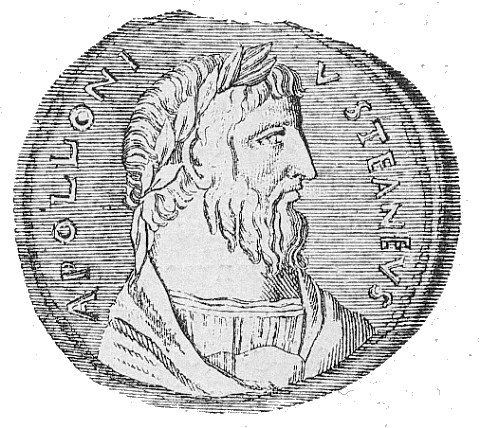
Abb.: Darstellung des Apollonius von Tyana auf römischer Münze
[Bildquelle: Wikipedia, Public domain]
"Apollonios von Tyana (in Kappadokien), neupythagoreischer Philosoph, Theurg und Magier, der, ungefähr gleichalterig mit Christus, durch seine Reisen, Abenteuer, Prophezeiungen, sogenannte Wunder, großes Aufsehen bei seinen Zeitgenossen erregt zu haben scheint und ungefähr 100jährig in Ephesos starb. Von dem höchsten Gott hatte er eine gereinigte Vorstellung: ihm sollen keine Opfer gebracht, er soll nicht einmal mit Worten genannt, vielmehr nur mit dem Verstand erfasst werden. Tempel, Altäre und Bildsäulen wurden dem Apollonios in vielen Städten, besonders Kleinasiens und Griechenlands, errichtet sowie Münzen auf sein noch den Kaisern Caracalla, Aurelian und Alexander Severus heiliges Andenken geschlagen. Gegner des Christentums in alter und neuer Zeit stellten ihn neben Christus oder sogar über ihn, so Hierokles unter Diokletian, Voltaire, Wieland u.a. Eine ausführliche, romanhaft tendenziöse, historisch wertlose Biographie des Apollonios besitzen wir noch von Flavius Philostratos (s. d.), der sie auf Veranlassung der Julia Domna, Gemahlin des Septimius Severus, in acht Büchern niederschrieb. Die Schriften des Apollonios sind verloren bis auf 85 Briefe, die, wahrscheinlich unecht, mit jener Lebensbeschreibung in den Ausgaben der Werke des Philostratos von Westermann (Par. 1849) und Kayser (Bd. 1, Leipz. 1870) abgedruckt worden sind. Vgl. Baur, Apollonios von Tyana und Christus (Tübing. 1832); Jessen, Apollonios von Tyana und sein Biograph Philostratus (Hamb. 1885); Göttsching, Apollonios von Tyana (Berl. 1889)." [Quelle: Meyers großes Konversations-Lexikon. -- DVD-ROM-Ausg. Faksimile und Volltext der 6. Aufl. 1905-1909. -- Berlin : Directmedia Publ. --2003. -- 1 DVD-ROM. -- (Digitale Bibliothek ; 100). -- ISBN 3-89853-200-3. -- s.v.]
Das Folgende ist eine Übersetzung aus dem griechischen "Leben des Apollonius von Tyana" des Flavius Philostratos (Φιλοστράτος) (um 200 n. Chr.):
"§19] And as they were being conveyed across the Indus, they say that they came across many river-horses and many crocodiles; and they say that the vegetation on the Indus resembles that which grows along the Nile, and that the climate of India is sunny in winter, but suffocating in summer; but to conteract this Providence has excellently contrived that it should often rain in their country . And they also say that they learned from the Indians that the king was in the habit of coming to this river when it rose in the appropriate seasons, and would sacrifice to the river black bulls and horses; for white is less esteemed by the Indians than black, because, I imagine, the latter is their own color; and when he has sacrificed, they say that he plunges into the river a measure of gold made to resemble that which is used in measuring wheat.
And why the king does this, the Indians, they say, have no idea; but they themselves conjectured that this measure was sunk in the river, either to secure the plentiful harvest, whose yield the farmers use such a measure to gauge, or to keep the river within its proper bounds and prevent it from rising to such heights as that it would drown the land.
[§20] And after they had crossed the river, they were conducted by the satrap's guide direct to Taxila, where the Indian had his royal palace. And they say that on that side of the Indus the dress of the people consists of native linen, with shoes of byblus and a hat when it rains; but that the upper classes there are appareled in byssus; and that the byssus grows upon a tree of which the stem resembles that of the white poplar, and the leaves those of the willow. And Apollonius says that he was delighted with the byssus, because it resembled his sable philosopher's cloak. And the byssus is imported into Egypt from India for many sacred uses.Taxila, they tell us, is about as big as Nineveh, and was fortified fairly well after the manner of Greek cities; and here was the royal residence of the personage who then ruled the empire of Porus.
And they saw a Temple, they saw, in front of the wall, which was not far short of 100 feet in size, made of porphyry,[3] and there was constructed within it a shrine, somewhat small as compared with the great size of the Temple which is surrounded with columns, but deserving of notice. For bronze tablets were nailed into each of its walls on which were engraved the exploits of Porus and Alexander. But the pattern was wrought with orichalcus and silver and gold and black bronze, of elephants, horses, soldiers, helmets, shields, but spears, and javelins and swords, were all made of iron; and the composition was like the subject of some famous painting by Zeuxis or Polygnotus and Euphranor, who delighted in light and shade; and, they say, here also was an appearance of real life, as well as depth and relief. And the metals were blended in the design, melted in like so many colors; and the character of the picture was also pleasing in itself, for Porus dedicated these designs after the death of the Macedonian, who is depicted in the hour of victory, restoring Porus who is wounded, and presenting him with India which was now his gift.
And it is said that Porus mourned over the death of Alexander, and that he lamented him as generous and a good prince; and as long as Alexander was alive after his departure from India, he never used the royal diction and style, although he had license to do so, nor issued kingly edicts to the Indians, but figured himself as satrap full of moderation, and guided every action by the wish to please Alexander.
§21] My argument does not allow me to pass over the accounts written of this Porus. For when the Macedonian was about to cross the river, and some of Porus' advisers wished him to make an alliance with the kings on the other side of the Hyphasis and the Ganges, urging that the invader would never face a general coalition against him of the whole of India, he replied: "If the temper of my subjects is such that I cannot save myself without allies, then for me it is better not to be king."
And when someone announced to him that Alexander had captured Darius, he remarked, "a king but not a man." And when the mule driver had caparisoned the elephant on which he meant to fight, he replied: "Nay, I shall carry him, if I prove myself the same man I used to be." And when they counseled him to sacrifice to the river, and induce it to reject the rafts of the Macedonians, and make it impassable to Alexander, he said: "It ill befits those who have arms to resort to imprecation."
And after the battle, in which his conduct struck Alexander as divine and superhuman, when one of his relations said to him: "If you had only paid homage to him after he had crossed, O Porus, you would not yourself have been defeated in battle, nor would so many Indians have lost their lives, nor would you yourself have been wounded," he said: "I knew from my report that Alexander was so fond of glory that, if I did homage to him, he would regard me as a slave, but if I fought him, as a king. And I much preferred his admiration to his pity, not was I wrong in my calculation. For by showing myself to be such a man as Alexander found me, I both lost and won everything that day."
Such is the character which historians give to this Indian, and they say that he was the handsomest of his race, and in stature taller than any man since the Trojan heroes, but that he was quite young, when he went to war with Alexander.
[...]
[§23] While the sage was engaged in this conversation, messengers and an interpreter presented themselves from the king, to say that the king would make him his guest for three days, because the laws did not allow of strangers residing in the city for a longer time; and accordingly they conducted him into the palace. I have already described the way in which the city is walled, but they say that it was divided up into narrow streets in the same irregular manner as in Athens, and that the houses were built in such a way that if you look at them from outside they had only one story, while if you went into one of them, you at once found subterranean chambers extending as far below the level of the earth as did the chambers above.
[§24] And they say that they saw a Temple of the Sun in which was kept loose a sacred elephant called Ajax, and there were images of Alexander made of gold, and others of Porus, though the latter were of black bronze. But on the walls of the Temple there were red stones, and gold glittered underneath, and gave off a sheen as bright as sunlight. But the statue was compacted of pearls arranged in the symbolic manner affected by all barbarians in their shrines.
[§25] And in the palace they say that they saw no magnificent chambers, nor any bodyguards or sentinels, but, considering what is usual in the houses of magnates, a few servants, and three or four people who wished, so I suppose, to converse with the king. And they say that they admired this arrangement more than they did the pompous splendor of Babylon, and their esteem was enhanced when they went within. For the men's chambers and the porticoes and the whole of the vestibule were in a very chaste style.
[§26] So the Indian was regarded by Apollonius as a philosopher, and addressing him through an interpreter, he said: "I am delighted, O king, to find you living like a philosopher.""And, I" said the other, "am delighted that you should think of me thus."
"And," said Apollonius, "is this customary among you, or was it you yourself established your government on so modest a scale?"
"Our customs," said the king, "are dictated by moderation, and I am still more moderate in my carrying them out; and though I have more than other men, yet I want little, for I regard most things as belonging to my own friends."
"Blessed are you then in your treasure," said Apollonius, "if you rate your friends more highly than gold and silver, for out of them grows up for you a harvest of blessings."
"Nay more," said the king, "I share my wealth also with my enemies. For the barbarians who live on the border of this country were perpetually quarreling with us and making raids into my territories, but I keep them quiet and control them with money, so that my country is patrolled by them, and instead of their invading my dominions, they themselves keep off the barbarians that are on the other side of the frontier, and are difficult people to deal with."
And when Apollonius asked him, whether Porus also had paid them subsidy, he replied: "Porus was as fond of war as I am of peace."
By expressing such sentiments he quite disarmed Apollonius, who was so captivated by him, that once, when he was rebuking Euphrates for his want of philosophic self-respect, he remarked: "Nay, let us at least reverence Phraotes the Indian," for this was the name of the Indian.
And when a satrap, for the great esteem in which he held the monarch, desired to bind on his brow a golden mitre adorned with various stones, he said: "Even if I were an admirer of such things, I should decline them now, and cast them off my head, because I have met with Apollonius. And how can I now adorn myself with ornaments which I never before deigned to bind upon my head, without ignoring my guest and forgetting myself?"
Apollonius also asked him about his diet, and he replied: "I drink just as much wine as I pour out in libation to the Sun; and whatever I take in the chase I give to others to eat, for I am satisfied with the exercise I get. But my own meal consists of vegetables and of the pith and fruit of date palms, and of all that a well-watered garden yields in the way of fruit. And a great deal of fruit is yielded to me by the trees which I cultivate with these hands."
When Apollonius heard this, he was more than gratified, and kept glancing at Damis.
[§27] And when they had conversed a good deal about which road to take to the Brahmans, the king ordered the guide from Babylon to be well entertained, as it was customary so to treat those who came from Babylon; and the guide from the satrap, to be dismissed after being given provisions for the road.
Then he took Apollonius by the hand, and having bidden the interpreter to depart, he said: "You will then, I hope, choose me for your boon companion."
And he asked question of him in the Greek tongue. But Apollonius was surprised, and remarked: "Why did you not converse with me thus, from the beginning?"
"I was afraid," said the king, "of seeming presumptuous, seeming, that is, not to know myself and not to know that I am a barbarian by decree of fate; but you have won my affection, and as soon as I saw that you take pleasure in my society, I was unable to keep myself concealed. But that I am quite competent in the Greek speech I will show you amply."
"Why then," said Apollonius, "did you not invite me to the banquet, instead of begging me to invite you?"
"Because," he replied, "I regard you as my superior, for wisdom has more of the kingly quality about it."
And with that he led him and his companions to where he was accustomed to bathe. And the bathing-place was a garden, a stade in length, in the middle of which was dug out a pool, which was fed by fountains of water, cold and drinkable; and on each side there were exercising places, in which he was accustomed to practice himself after the manner of the Greeks with javelin and quoit-throwing; for physically he was very robust, both because he was still young, for he was only seven-and-twenty years old, and because he trained himself in this way. And when he had had enough exercise, he would jump into the water and exercised himself in swimming.
But when they had taken their bath, they proceeded into the banqueting chamber with wreaths upon their heads; for this is the custom of the Indians, whenever they drink wine in the palace.
[§28] And I must on no account omit to describe the arrangement of the banquet, since this has been clearly described and recorded by Damis. The king then banquets upon a mattress, and as many as five of his nearest relations with him; but all the rest join in the feast sitting upon chairs.
And the table resembles an altar in that it is built up to the height of a man's knee in the middle of the chamber, and allows rooms for thirty to dispose themselves around it like a choir in a close circle. Upon it laurels are strewn, and other branches which are similar to the myrtle, but yield to the Indians their balm. Upon it are served up fish and birds, and there are also laid upon it whole lions and gazelles and swine and the loins of tigers; for they decline to eat the other parts of this animal, because they say that, as soon as it is born, it lifts up its front paws to the rising Sun.
Next, the master of ceremonies rises and goes to the table, and he selects some of the viands for himself, and cuts off other portions, and then he goes back to his own chair and eats his full, constantly munching bread with it. And when they all have had enough, goblets of silver and gold are brought in, each of which is enough for ten banqueters, and out of these they drink, stooping down like animals that are being watered.
And while they are drinking, they have brought in performers of various dangerous feats, not undeserving of serious study. For a boy, like one employed by dancing-girls, would be tossed lightly aloft, and at the same moment an arrow is aimed at him, up in the air, and when he was a long way from the ground, the boy would, by a tumblers' leap, raise himself above the weapen, and if he missed his leap, he was sure to be hit. For the archer, before he let fly, went round the banqueters and showed them the point of his weapon, and let them try the missile themselves. Shooting through a ring, too, or hitting a hair with an arrow, or for a man to mark the outline of his own son with arrows, as he stands in front of a board, keeps them occupied at their banquets, and they aim straight, even when they are drinking.
[§29] Well, the companions of Damis marveled at the accuracy of their eye, and were surprised at the exactness with which they aimed their weapons; but Apollonius, who ate with the king, since they agreed in diet, was less interested in these feats and said to the king: "Tell me, O King, how you acquired such a command of the Greek tongue, and whence you derived all your philosophical attainments in this place? For I don't imagine that you owe them to teachers, for it is not likely that there are, in India, any who could teach it."The king smiled and said: "In old days they would ask men who arrived by sea whether they were pirates, so common did they consider that way of living, hard though it is; but so far as I can make out, you Greeks ask your visitors whether they are not philosophers, so convinced you are that everyone you meet with must needs possess the divinest of human attainments. And that philosophy and piracy are one and the same thing among you, I am well aware; for they say that a man like yourself is not to be found anywhere; but that most of your philosophers are like people who have despoiled another man of his garment and then have dressed themselves up in it, although it does not fit them, and proceed to strut about trailing another man's garment. Nay, by Zeus, just as robbers live in luxury, well knowing that they lie at the mercy of justice, so are they, it is said, addicted to gluttony and riotous living and to delicate apparel.
And the reason is this: you have laws, I believe, to the effect that if a man is caught forging money, he must die, and the same if anyone illegally enrolls a child upon the register, or there is some penalty, I know not what; but people who utter counterfeit philosophy or corrupt her are not, I believe, restrained among you by any law, nor is there any authority set to suppress them.[§30] Now among us few engage in philosophy, and they are sifted and tried as follows: A young man so soon as he reaches the age of eighteen, and this I think is accounted the time of full age among you also, must pass across the river Hyphasis to the men who you are set upon visiting, after first making a public statement that he will become a philosopher, so that those who wish to may exclude him, if he does not approach the study in a state of purity. And by pure I mean, firstly, in respect of his parentage, that no disgraceful deed can be proved against either his father or his mother; next that their parents in turn, and the third generation upwards, are equally pure, that there was no ruffian among them, no debauchee, nor any unjust usurer.
And when no scar or reproach can be proved against them, nor any other stain whatever, then it is time narrowly to inspect the young man himself and test him, to see firstly, whether he has a good memory, and secondly, whether he is modest and reserved in disposition, and does not merely pretend to be so, whether he is addicted to drink, or greed, or a quack, or a buffoon, or rash, or abusive, to see whether he is obedient to his father, to his mother, to his teachers, to his school-masters, and above all, if he makes no bad use of his personal attractions.The particulars then of his parents and of their progenitors are gathered from witnesses and from the public archives. For whenever an Indian dies, there visits his house a particular authority charged by the law to make a record of him, and of how he lived. And if this officer lies or allows himself to be deceived, he is condemned by the law and forbidden ever to hold another office, on the ground that he has counterfeited a man's life.
But the particulars of the youths themselves are duly learnt by inspection of them. For in many cases a man's eyes reveal the secrets of his character, and in many cases there is material for forming a judgment and appraising his value in his eyebrows and cheeks, for from these features the dispositions of people can be detected by wise and scientific men, as images are seen in a looking-glass. For seeing that philosophy is highly esteemed in this country, and it is held in honor by the Indians, it is absolutely necessary that those who take to it should be tested and subjected to a thousand modes of proof.
Well then, that we study philosophy under direction of teachers, and that admission to philosophy is by examination among us, I have clearly explained; and now I will relate to you my own history.
[§31] [The king of Taxila continued:] "My grandfather was king, and had the same name as myself; but my father was a private person. For he was left quite young and two of his relations were appointed guardians in accordance with the laws of the Indians. But they did not carry on the king's government honestly on his behalf. No, by the Sun, but so unfairly that their subjects found their regime oppressive and the government fell into bad repute. A conspiracy then was formed against them by some of the magnates, who attacked them and slew them when they were sacrificing to the river Indus. The conspirators than seized upon the reins of government and took control of the State.
Now my father's kinsmen entertained apprehensions of him, because he was not yet sixteen years of age, so they sent him across the Hyphasis to the king there. And he has more subjects than I have, and his country is much more fertile than this one. This monarch wished to adopt him, but this my father declined on the ground that he would not struggle with fate that robbed him of his kingdom; but he besought to allow him to take his way to the sages and become a philosopher, for he said that this would make it easier for him to bear the reverses of his house. The king however being anxious to restore him to his father's kingdom, my father said: "If you see that I am become a genuine philosopher, then restore me; but if not, let me remain as I am."
The king accordingly went in person to the sages, and said that he would lie under great obligation to them if they would take care of a youth who had already showed such nobility of character, and they, discerning in him something out of the common run, were delighted to impart to him their wisdom, and were glad to educate him when they saw how addicted he was to learning.
Now seven years afterwards the king fell sick, and at the very moment when he was dying, he sent for my father, and appointed him co-heir in the government with his own son, and promised his daughter in marriage to him as she was already of marriageable age. And my father, since he saw that the king's son was the victim of flatterers and of wine and of such like vices, and was also full of suspicions of himself, said to him: "Do you keep all this and swill down the whole Empire as your own; for it is ridiculous that one who could not even gain the kingdom which belonged to him should presume to meddle with one which does not; but give me your sister, for this is all I want of yours."
So having obtained her in marriage he lived hard by the sage in seven fertile village which the king bestowed upon his sister as her pin-money. I then am the issue of this marriage, and my father after a Greek education brought me to the sages at an age somewhat too early perhaps, for I was only twelve at the time, but they brought me up like their own son; for any that they admit knowing the Greek tongue they are especially fond of, because they consider that in virtue of the similarity of his disposition he already belongs to themselves.
[§32] And when my parents had died, which they did almost together, the sages bade me repair to the villages and look after my own affairs, for I was now nineteen years of age. But, alas, my good uncle had already taken away the villages, and didn't even leave me the few acres my father had acquired; for he said that the whole of them belonged to his kingdom, and that I should get more than I deserved if he spared my life. I accordingly raised a subscription among my mother's freedmen, and kept four retainers.
And one day when I was reading the play The Children of Heracles, a man presented himself from my own country, bringing a letter from a person devoted to my father, who urged me to cross the river Hydraotes and confer with him about my present kingdom; for he said there was a good prospect of recovering it, if I did not dawdle. I cannot but think that some god set me on reading this drama at the moment, and I followed the omen; and having crossed the river I learnt that one of the usurpers of the throne was dead, and that the other was besieged in this very palace.
Accordingly I hurried forward, and proclaimed to the inhabitants of the villages through which I passed that I was the sons of so and so, naming my father, and that I was come to take possession of my own kingdom; but they received me with open arms and escorted me, recognizing my resemblance to my grandfather, and they had daggers and bows, and our numbers increased from day to day. And when I approached the gates the population received me with such enthusiasm that they snatched up torches off the altar of the Sun and came before the gates and escorted me hither with many hymns in praise of my father and grandfather. But the drone that was within they walled up, although I protested against his being put to such death."
[§33] Here Apollonius interrupted and said: "You have exactly played the part of the restored sons of Heracles in the play, and praised be the gods who have helped so noble a man to come by his own and restored you by their noble intervention. But tell me this about these sages: were they not once actually subject to Alexander, and were they not brought before him to philosophize about the heavens?""Those were the Oxydracae," he said, "and a race that has always been independent and well equipped for war; and they assert that they deal in wisdom, though they know nothing of value. But the genuine sages live between the Hyphasis and the Ganges, in a country which Alexander never assailed; not I imagine because he was afraid of what was in it, but, I think, because the omens warned him against it. But if he had crossed the Hyphasis, and had been able to take the surrounding country, he could certainly never have taken possession of their castle in which they live, not even if he had had ten thousand like Achilles, and thirty thousand like Ajax behind him; for they do not do battle with those who approach them, but they repulse them with prodigies and thunderbolts which they send forth, for they are holy men and beloved of the gods.
It is related, anyhow, that Heracles of Egypt and Dionysus after they had overrun the Indian people with their arms, at last attached them in company, and that they constructed engines of war, and tried to take the place by assault; but the sages, instead of taking the field against them, lay quiet and passive, as it seemed to the enemy; but as soon as the latter approached they were driven off by rockets of fire and thunderbolts which were hurled obliquely from above and fell upon their armor.
It was on that occasion, they say, that Hercules lost his golden shield, and the sages dedicated it as an offering, partly out of respect for Hercules' reputation, and partly because of the reliefs upon the shield. For in these Hercules is represented fixing the frontier of the world at Gadira, and turning the mountains into pillars, and confining the ocean within its bounds. Thence it is clear that it was not the Theban Hercules, but the Egyptian one, that came to Gadira, and fixed the limits of the world."
[§34] While they were thus talking, the strain of the hymn sung to the pipe fell upon their ears, and Apollonius asked the king what was the meaning of their cheerful ode. "The Indians," he answered, "sing their admonitions to the king, at the moment of his going to bed; and they pray that he may have good dreams, and rise up propitious and affable towards his subjects."
"And how," said Apollonius, "do you, O king, feel in regard to this matter? For it is yourself I suppose that they honor with their pipes."
"I don't laugh at them," he said, "for I must allow it because of the law, although I do not require any admonition of the kind: for in so far as a king behaves himself with moderation and integrity, he will bestow, I imagine, favors on himself rather than on his subjects."
[§35] After this conversation they laid themselves down to repose; but when a new day had dawned, the king himself went to the chamber in which Apollonius and his companions were sleeping, and gently stroking the bed he addressed the sage, and asked him what he was thinking about. "For," he said, "I don't imagine you are asleep, since you drink water and despise wine."
Said the other: "Then you don't think that those who drink water go to sleep?"
"Yes," said the king, "they sleep, but with a very light sleep, which just sits upon the tips of their eyelids, as we say, but not upon their minds."
"Nay with both do they sleep," said Apollonius, "and perhaps more with the mind than with the eyelids. For unless the mind is thoroughly composed, the eyes will not admit of sleep either. For note how madmen are not able to go to sleep because their mind leaps with excitement, and their thoughts run coursing hither and thither, so that their glances are full of fury and morbid impulse, like those of the dragons who never sleep.
Since then, O king," he went on, "we have clearly intimated the use and function of sleep, and what it signifies for men, let us examine whether the drinker of water need sleep less soundly than the drunkard."
"Do not quibble," said the king, "for if you put forward the case of a drunkard, he, I admit, will not sleep at all, for his mind is in a state of revel, and whirls him about and fills him with uproar. All, I tell you, who try to go to sleep when in drink seem to themselves to be rushed up on the roof, and then to be dashed down to the ground, and to fall into a whirl, as they say happened toIxion. Now I do not put the case of a drunkard, but of a man who has merely drunk wine, but remains sober; I wish to consider whether he will sleep, and how much better he will sleep than a man who drinks no wine."
And when no scar or reproach can be proved against them, nor any other stain whatever, then it is time narrowly to inspect the young man himself and test him, to see firstly, whether he has a good memory, and secondly, whether he is modest and reserved in disposition, and does not merely pretend to be so, whether he is addicted to drink, or greed, or a quack, or a buffoon, or rash, or abusive, to see whether he is obedient to his father, to his mother, to his teachers, to his school-masters, and above all, if he makes no bad use of his personal attractions.
The particulars then of his parents and of their progenitors are gathered from witnesses and from the public archives. For whenever an Indian dies, there visits his house a particular authority charged by the law to make a record of him, and of how he lived. And if this officer lies or allows himself to be deceived, he is condemned by the law and forbidden ever to hold another office, on the ground that he has counterfeited a man's life.
But the particulars of the youths themselves are duly learnt by inspection of them. For in many cases a man's eyes reveal the secrets of his character, and in many cases there is material for forming a judgment and appraising his value in his eyebrows and cheeks, for from these features the dispositions of people can be detected by wise and scientific men, as images are seen in a looking-glass. For seeing that philosophy is highly esteemed in this country, and it is held in honor by the Indians, it is absolutely necessary that those who take to it should be tested and subjected to a thousand modes of proof.
Well then, that we study philosophy under direction of teachers, and that admission to philosophy is by examination among us, I have clearly explained; and now I will relate to you my own history.
[§36] Apollonius then summoned Damis, and said: "'Tis a clever man with whom we are discussing and one thoroughly trained in argument."
"I see it is so, " said Damis, "and perhaps this is what is meant by the phrase 'catching a Tartar'. But the argument excites me very much, of which he has delivered himself; so it is time for you to wake up and finish it."
Apollonius then raised his head slightly and said: "Well I will prove, out of your own lips and following your own argument, how much advantage we who drink water have in that we sleep more sweetly. For you have clearly stated and admitted that the minds of drunkards are disordered and are in a condition of madness; for we see those who are under the spell of drink imagining that they see two moons at once and two suns, while those who have drunk less, even though they are quite sober, while they entertain no such delusions as these, are yet full of exultation and pleasure; and this fit of joy often falls upon them, even though they have not had any good luck, and men in such a condition will plead cases, although they never opened their lips before in a law court, and they will tell you they are rich, although they have not a farthing in their pockets.
Now these, O king, are the affections of a madman. For the mere pleasure of drinking disturbs their judgment, and I have known many of them who were so firmly convinced that they were well off, that they were unable to sleep, but leapt up in their slumbers, and this is the meaning of the saying that 'good fortune itself is a reason for being anxious.'
Men have also devised sleeping draughts, by drinking or anointing themselves with which, people at once stretch themselves out and go to sleep as if they were dead; but when they wake up from such sleep it is with a sort of forgetfulness, and they imagine that they are anywhere rather than where they are. Now these draughts are not exactly drunk, but I would rather say that they drench the soul and body; for they do not induce any sound or proper sleep, but the deep coma of a man half dead, or the light and distracted sleep of men haunted by phantoms, even though they be wholesome ones; and you will, I think, agree with me in this, unless you are disposed to quibble rather than argue seriously.
But those who drink water, as I do see things as they really are, and they do not record in fancy things that are not; and they were never found to be giddy, nor full of drowsiness, or of silliness, nor unduly elated; but they are wide awake and thoroughly rational, and always the same, whether late in the evening or early in the morning when the market is crowded; for these men never nod, even though they pursue their studies far into the night. For sleep does not drive them forth, pressing down like a stadholder upon their necks, that are bowed down by the wine; but you find them free and erect, and they go to bed with a clear, pure soul and welcome sleep, and are neither buoyed up by the bubbles of their own private luck, nor scared out of their wits by any adversity.
For the soul meets both alternatives with equal calm, if it be sober and not overcome by either feeling; and that is why it can sleep a delightful sleep untouched by the sorrows which startle others from their couches.
[§37] And more than this, as a faculty of divination by means of dreams, which is the divines and most godlike of human faculties, the soul detects the truth all the more easily when it is not muddied by wine, but accepts the message unstained and scans it carefully. Anyhow, the explains of dreams and visions, those whom the poets call interpreters of dreams, will never undertake to explain any vision to anyone without having first asked the time when it was seen. For if it was at dawn and in the sleep of morning tide, they calculate its meaning on the assumption that the soul is then in a condition to divine soundly and healthily, because by then it has cleansed itself of the stains of wine. But if the vision was seen in the first sleep or at midnight, when the soul is still immersed in the lees of wine and muddied thereby, they decline to make any suggestions, and they are wise.
And that the gods also are of this opinion, and that they commit the faculty of oracular response to souls which are sober, I will clearly show. There was, O king, a seer among the Greeks called Amphiaros."
"I know," said the other; "for you allude, I imagine, to the son of Oecles, who was swallowed up alive by the earth on his way back from Thebes."
"This man, O king," said Apollonius, "still divines in Attica, inducing dreams in those who consult him, and the priests take a man who wishes to consult him, and they prevent his eating for one day, and from drinking wine for three, in order that he may imbibe the oracles with his soul in a condition of utter transparency. But if wine were a good drug of sleep, then the wise Amphiaros would have bidden his votaries to adopt the opposite regimen, and would have had them carried into his shrine as full of wine as leather flagons.
And I could mention many oracles, held in repute by Greeks and barbarians alike, where the priest utters his responses from the tripod after imbibing water and not wine. So you may consider me also as a fit vehicle of the god, O king, along with all who drink water. For we are rapt by the nymphs and are bacchantic revelers in sobriety."
"Well, then," said the king, "you must make me too, O Apollonius, a member of your religious brotherhood."
"I would do so," said the other, "provided only you will not be esteemed vulgar and held cheap by your subjects. For in the case of a king a philosophy that is at once moderate and indulgent makes a good mixture, as is seen in your own case; but an excess of rigor and severity would seem vulgar, O king, and beneath your august station; and, what is more, it might be construed by the envious as due to pride."
[§38] When they had thus conversed, for by this time it was daylight, they went out into the open. And Apollonius, understanding that the king had to give audience to embassies and such-like said: "You then, O king, must attend to the business of state, but let me go and devote this hour to the Sun, for I must needs offer up to him my accustomed prayer."
"And I pray he may hear your prayer," said the king, "for he will bestow his grace on all who find pleasure in your wisdom; but I will wait for you until you return, for I have to decide some cases in which your presence will very greatly help me."
[§39] Apollonius then returned, when the day was already for advanced and asked him about the cases which he had been judging; but he answered: "Today I have not judged any, for the omens did not allow me."
Apollonius then replied and said: "It is the case then that you consult the omens in such cases as these, just as you do when you are setting out on a journey or a campaign."
"Yes, by Zeus," he said, "for there is a risk in this case, too, of one who is a judge straying from the right line."
Apollonius felt that what he said was true, and asked him again what the suit was which he had to decide; "For I see," he said, "that you have given your attention to it and are perplexed what verdict to give."
"I admit," said the king, "that I am perplexed; and that is why I want your advice; for one man has sold to another land, in which there lay a treasure as yet undiscovered, and some time afterwards the land, being broken up, revealed a certain chest, which the person who sold the land says belongs to him rather than the other, for that he would never have sold the land, if he had known beforehand that he had a fortune thereon; but the purchaser claims that he acquired everything that he found in land, which thenceforth was his. And, both their contentions are just; and I shall seem ridiculous if I order them to share the gold between them, for any old woman could settle the matter in that way."
Apollonius thereupon replied as follows: "The fact that they are quarreling about gold shows that these two men are no philosophers; and you will, in my opinion, give the best verdict if you bear this in mind, that the gods attach the first importance and have most care for those who live a life of philosophy together with moral excellence, and only pay secondary attention to those who have committed no faults and were never found unjust.
Now they entrust to philosophers the task of rightly discerning things divine and human as they should be discerned, but to those who merely re of good character they give enough to live upon, so hat they may never be rendered unjust by actual lack of the necessaries of life. It seems then to me, O king, right to weight these men in the balance, as it were, and to examine their respective lives; for I cannot believe that the gods would deprive the one even of his land, unless he was a bad man, or that they would, on the other hand, bestow on the other even what was under the land, unless he was better than the man who sold it."The two claimants came back the next day, and the seller was convicted of being a ruffian who had neglected the sacrifices, which it was his bounden duty to sacrifice to the gods on that land; but the other was found to be a decent man and a most devout worshipper of the gods. Accordingly, the opinion of Apollonius prevailed, and the better of the two men quitted the court as one on whom the gods had bestowed this boon.
[§40] When the law-suit had been thus disposed of, Apollonius approached the Indian, and said: " This the third day, O king, that you have made me your guest; and at dawn to-morrow I must quit your land in accordance with the law."
"But," said the other, " the law does not yet speak to you thus, for you can remain on the morrow, since you came after midday."
"I am delighted," said Apollonius, "with your hospitality, and indeed you seem to me to be straining the law for my sake."
"Yes indeed, and I would I could break it," said the king, "in your behalf; but tell me this, Apollonius, did not the camels bring you from Babylon which they say you were riding ?"
"They did," he said, "and Vardanes gave them us."
"Will they then be able to carry you on, after they have come already so many stades from Babylon?"
Apollonius made no answer, but Damis said: "O king, our friend here does not understand anything about our journey, nor about the races among which we shall find ourselves in future; but he regards our passage into India as mere child's play, under the impression that he will everywhere have you and Vardanes to help him. I assure you, the true condition of the camels has not been acknowledged to you; for they are in such an evil state that we could carry them rather than they us, and we must have others. For if they collapse anywhere in the wilderness of India, we," he continued, "shall have to sit down and drive off the vultures and wolves from the camels, and as no one will drive them off from us we shall perish too."
The king answered accordingly and said: "I will remedy this, for I will give you other camels, and you need four I think, and the satrap ruling the Indus will send back four others to Babylon. But I have a herd of camels on the Indus, all of them white."
"And," said Damis, "will you not also give us a guide, O king?"
"Yes, of course," he answered, "and I will give a camel to the guide and provisions, and I will write a letter to Iarchas, the oldest of the sages, praying him to welcome Apollonius as warmly as he did myself, and to welcome you also as philosophers and followers of a divine man."
And forthwith the Indian gave them gold and precious stones and linen and a thousand other such things. And Apollonius said that he had enough gold already, because Vardanes had given it to the guide on the sly; but that he would accept the linen robes, because they were like the cloaks worn by the ancient and genuine inhabitants of Attica.
And he took up one of the stones and said: "O rare stone, how opportunely have I found you, and how providentially!" detecting in it, I imagine, some secret and divine virtue. Neither would the companions of Damis accept for themselves the gold; nevertheless they took good handfuls of the gems, in order to dedicate them to the gods, whenever they should regain their own country.
[§41] So they remained the next day as well, for Indian would not let them go, and he gave them a letter for Iarchas, written in the following terms:-
"King Phroates to Iarchas his master and to his companions, all hail! Apollonius, wisest of men, yet accounts you still wiser than himself, and is come to learn your lore. Send him away therefore when he knows all that you know yourselves, assured that nothing of your teachings will perish, for in discourse and memory he excels all men. And let him also see the throne, on which I sat, when you, Father Iarchas, bestowed on me the kingdom. And his followers too deserve commendation for their devotion to such a master. Farewell to yourself and your companions."[§42] And they rode out of Taxila, and after a journey of two days reached the plain, in which Porus is said to have engaged Alexander: and they say they saw gates therein that enclosed nothing, but had been erected to carry trophies. For there was set up on them a statue of Alexander standing in a four-poled chariot, as he looked when at Issus he confronted the satraps of Darius. And at a short distance from one another there are said to have been built two gates, carrying the one a statue of Porus, and the other one of Alexander, of both, as I imagine, reconciled to one another after the battle; for the one is in the attitude of one man greeting another, and the other of one doing homage."[Quelle der Übersetzung: Philostratus: The life of Apollonius of Tyana, the Epistles of Apollonius and the Treatise of Eusebius / translated by F. C. (Frederick Cornwallis) Conybeare [1856 - 1924]. -- London : Heinemann, 1912. -- 2 vol. -- Online: http://www.livius.org/ap-ark/apollonius/life/va_00.html. -- Zugriff am 2008-04-07]
Der chinesische buddhistische Mönch Fǎxiǎn (Fa-hsien) (法顯) (377 - 422) bereiste Indien von 399 bis 411 n. Chr. Er beschreibt seine Reise in Foguo ji (佛囯记/佛國記) "Bericht von den buddhistischen Königreichen."
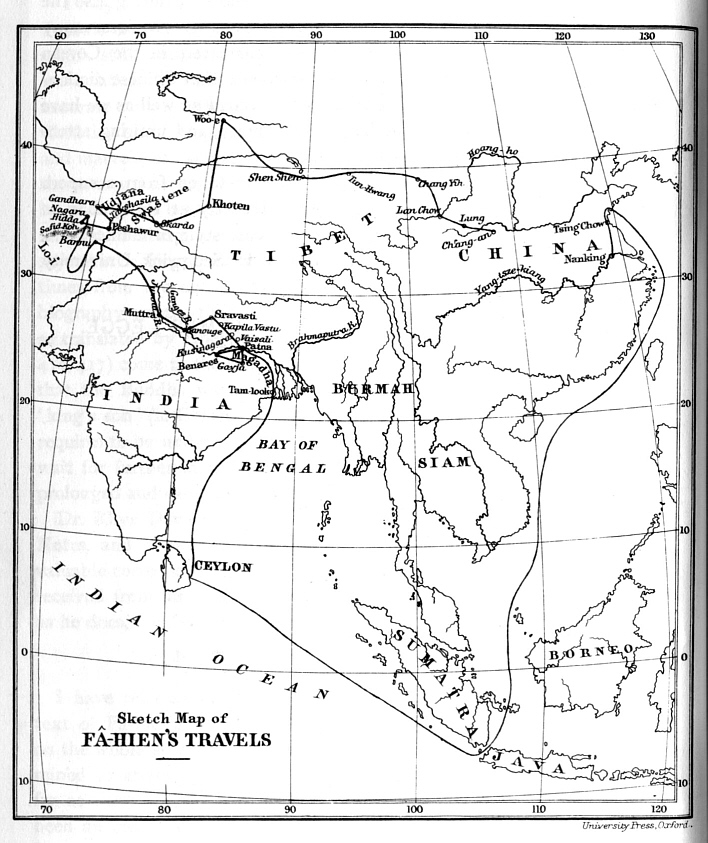
Abb.: Sketch map of Fâ-Hien's Travels
[Bildquelle: Legge's unten zitierte Übersetzung, 1886; Public domain]
CHAPTER XI
TAKSHASILA. LEGENDS. THE FOUR GREAT TOPES.
Seven days’ journey from this to the east brought the travellers to the kingdom of Takshaśilā,1 which means “the severed head” in the language of China. Here, when Buddha was a Bodhisattva, he gave away his head to a man;2 and from this circumstance the kingdom got its name.
Going on further for two days to the east, they came to the place where the Bodhisattva threw down his body to feed a starving tigress. In these two places also large topes have been built, both adorned with layers of all the precious substances. The kings, ministers, and peoples of the kingdoms around vie with one another in making offerings at them. The trains of those who come to scatter flowers and light lamps at them never cease. The nations of those quarters all those (and the other two mentioned before) “the four great topes.”
NOTES
1 See Julien’s “Methode pour dechiffrer et transcrire les Nomes Sanscrits,” p. 206. Eitel says, “The Taxila of the Greeks, the region near Hoosun Abdaul in lat. 35d 48s N., lon. 72d 44s E. But this identification, I am satisfied, is wrong. Cunningham, indeed, takes credit (“Ancient Geography of India,” pp. 108, 109) for determining this to be the site of Arrian’s Taxila,—in the upper Punjab, still existing in the ruins of Shahdheri, between the Indus and Hydaspes (the modern Jhelum). So far he may be correct; but the Takshaśilā of Fa-hien was on the other, or western side of the Indus; and between the river and Gandhāra. It took him, indeed, seven days travelling eastwards to reach it; but we do not know what stoppages he may have made on the way. We must be wary in reckoning distances from his specifications of days.
2 Two Jataka stories. See the account of the latter in Spence Hardy’s “Manual of Buddhism,” pp. 91, 92. It took place when Buddha had been born as a Brahman in the village of Daliddi; and from the merit of the act, he was next born in a devaloka.
[Quelle: Faxian (法顯) <ca. 337 - ca. 422>: A record of Buddhistic kingdoms, being an account by the Chinese monk Fâ-Hien of his travels in India and Ceylon (A.D. 399-414) in search of the Buddhist books of discipline / tanslated and annotazed with a Corean translation of the Chinese text by James Legge [1815 - 1897]. -- Oxford : Clarendon Press, 1886. -- xv, 123, 45 S. ; 23 cm. -- Originaltitel: 佛囯记/佛國記]
Der chinesische buddhistische Mönch Xuánzàng (Hsüan-tsan) (玄奘) (603 - 664) bereiste Indien von 630 bis 643.
"Xuanzang (chin. 玄奘, Xuánzàng, W.-G. Hsüan-tsang; jap. 玄奘三蔵, Genjō Sanzō) (* 603, † 664) war ein buddhistischer Pilgermönch aus China, der 629-45 die Seidenstraße und Indien bereiste. Er stammte aus Henan [ 河南], sein ursprünglicher Familienname war Chen. Mit 13 wurde er Mönch, aber schon nach einigen Jahren reiste er quer durchs Land. 629 verließ er trotz eines kaiserlichen Verbotes von Auslandsreisen China, um nach dem Vorbild eines früheren Pilgermönchs namens Faxian [法顯] (Dongjin, reiste 399-412) den Buddhismus in dessen Ursprungsland Indien zu studieren.
Sein Weg führte ihn dabei über die Seidenstraße (Kumul (قۇمۇل)/Hami [哈密地区], Samarkand [Самарқанд, سمرقند], Balch [بلخ] und auf dem Rückweg Khotan [خوتەن] [和闐]). Von 630 bis 643 bereiste Xuanzang Indien und hielt sich dabei die letzten 8 Jahre hauptsächlich im Harsha-Reich auf. Er studierte lange Zeit in Nalanda [नालन्दा] und nahm 643 auch als Vertreter des Mahayana-Buddhismus an einem großen Religionsdisput teil.
Mit zwanzig Pferden, 657 buddhistischen Texten und 150 Reliquien machte er sich auf den Rückweg nach China. 645 kam er wieder in Changan [长安区] an. Der Tang-Kaiser Tang Taizong [唐太宗] unterstützte ihn finanziell, so dass Xuanzang 74 heilige Schriften aus dem Sanskrit ins Chinesische übersetzen konnte, was maßgeblich zur Ausbreitung des Buddhismus in China beitrug. Sein Cheng Wei Shi Lun [成唯識論]wurde unter dem Namen Jōyuishiki-ron [成唯識論] zum Haupttext der aus der Faxiang [法相宗] hervorgegangenen japanischen Hossō-shū [法相宗].
Weiterhin hinterließ Xuanzang eine Reisebeschreibung unter dem Titel „Aufzeichnungen über die Westlichen Gebiete aus der Großen Tang-Dynastie“ (Da Tang Xiyu ji) [大唐西域記], die heute tieferen Einblick ins damalige Indien gibt. Seine Schriften wurden in der Großen Wildganspagode in Xi’an aufbewahrt, er selbst wurde zur Hauptfigur des klassischen chinesischen Romans „Die Pilgerreise nach dem Westen“. [西遊記]"
[Quelle: http://de.wikipedia.org/wiki/Xuanzang. -- Zugriff am 2008-04-04]
Er berichtet darüber in Da Tang Xiyu ji (大唐西域記) "Aufzeichnungen über die Westlichen Gebiete aus der Großen Tang-Dynastie":
"Ta-ch'a-shi-lo (Takshaśilā). [S. 136]The kingdom of Ta-ch'a-shi-lo43 is about 2000 li in circuit, and the capital is about 10 li in circuit. The royal family being extinct, the nobles contend for power by force. Formerly this country was in subjection to Kapiśa, but latterly it has become tributary to Kia-shi-mi-lo [S. 137] (Kaśmīr). The land is renowed for its fertility, and produces rich harvests. It is very full of streams and fountains. Flowers and fruits are abundant. The climate is agreeably temperate. The people are lively and courageous, and they honour the three gems. Although there are many saṅgārāmas, they have become ruinous and deserted, and there are very few priests; those that there are study the Great Vehicle.
43 On the return journey, Hiuen Tsiang makes the distance from Takshaśilā to the Indus three days' journey N.W. (Hwui-lih, Vie, p. 263). Fa-hien makes it seven days' journey from Gandhāra (cap. xi.); Sung-yun also places it three days to the east of the Indus (Beal's Bud. Pilgrims, p. 200). General Cunningham places the site of the city near Shah-dheri, one mile to the northeast of Kāla-ka-sarai, where he found the ruins of ft fortified city, and was able to trace the remains of no less than fifty-five stūpas— of which two were as large as the great Mānikyāla tope—twenty-eight monasteries, and nine temples (Anc. Geog. of India, p. 105). The classical writers notice the size and wealth of the city of Ταξιλα (Arrian, Anab. Alex., lib. v. c. 8 ; Strabo, Geog., lib. xv. c. 1, 17, and 28; Pliny, Hist. Nat., lib. vi. c. 17, 62, and c. 23; Ptolemy, Geog., lib. vii. 1, 45; Dionysius Perig., 1141). Apollonius and Damis are said also to have visited Taxila about a.d. 45. Philostratus describes the carvings and pictures of a temple near the town, representing scenes from the conflict of Porus with Alexander (cap. 20, p. 71, ed. Olearii, 1709). For further remarks on the ruins and antiquities see Cunningham, op. cit., pp. 104 f. M. V. de St. Martin, relying on the measurements given by Pliny derived from the records of Alexander's expedition, places Taxila at Hassan-Abdal, eight miles northwest of Shah-dheri (vid. Mémoire, P. 319) ; conf. Wilson, Ariana Ant., p. 196; J. R. A. S., vol v. p. 118; Burnouf, Introd., pp. 322 f., 332, 361; Lotus, pp. 689 f.; Bunbury, Hist. Anc. Geog., vol. i. pp. 443, 499. It is frequently mentioned in Sanskrit literature, e.g., Mahābh., i. 682, 834 ; Rāmāyana, iv. 53, śl. 23; Bṛih. Saṃh., x. 8, and xiv. 26; Pāṇini, iv. 2, 82 and 3, 93.
North-west of the capital about 70 li is the tank of the Nāga-rāja Elāpatra (I-lo-po-to-lo) ;44 it is about 100 paces round, the waters are pure and sweet; lotus flowers of various colours, which reflect different tints in their common beauty (garnish the surface); this Nāga was a Bhikshu who anciently, in the time of Kāśyapa Buddha, destroyed an Elāpatra tree. Hence, at the present time, when the people of that country ask for rain or fine weather, they must go with the Shamans to the side of the tank, and then cracking their fingers (or, in a moment), after praying for the desired object, they obtain it.
44 The story of the Nāga-rāja Elāpatra is a favourite one in Chinese Buddhist books. See Romantic Hist. of Buddha, p. 276 ff. (Stūpa of Bharhut, p. 27). Cunningham identifies the tank of Elāpatra with the fountain of Hasan Abdal called Bābā-Wali. In the legend referred to above we are told that the Nāga stretched his body from Takshaśilā to Banāras (compare the sculpture). In this case we should be led to Hasan Abdal as the site of Takshaśilā. This Nāga is mentioned in Brahmanical literature also as the son of Kaśyapa and Kadrū. Mahābhārata, I. 1551 ; Harivaṃśa 228, 12821 ; Vishṇu-purāṇa (Hall's ed.), vol. ii. pp. 74, 205, 287, and vol v. p. 251.
Going 30 li or so to the south-east of the Nāga tank, we enter a gorge between two mountains, where there is a stūpa built by Aśoka-rāja. It is about 100 feet in height. This is where Śākya Tathāgata delivered a prediction, that when Maitreya, Lord of the World, appeared hereafter, there should also appear of themselves four great gem treasures, and that in this excellent land there should be one. According to tradition, we find that whenever there is an earthquake, and the mountains on every side are shaken, all round this sacred spot (treasure) to the distance of 100 paces there is perfect stillness. If men are [S. 138] so foolish as to attempt to dig into the place (or ground surrounding it), the earth shakes again, and the men are thrown down headlong.
By the side of the stūpa is a saṅgārāma in ruins, and which has been for a long time deserted and without priests.
To the north of the city 12 or 13 li is a stūpa built by Aśoka-rāja. On feast-days (religious commemoration days) it glows with light, and divine flowers fall around it, and heavenly music is heard. According to tradition, we find in late times there was a woman whose body was grievously afflicted with leprosy. Coming to the stūpa secretly, she offered worship in excess and confessed her faults. Then seeing that the vestibule (the open court in front of the stūpa) was full of dung and dirt, she removed it, and set to work to sweep and water it and to scatter flowers and perfumes; and having gathered some blue lotus flowers, she covered the ground with them. On this her evil leprosy left her, and her form became lovely, and her beauty doubled, whilst from her person there came the famed scent of the blue lotus, and this also is the reason of the fragrance of this excellent place. This is the spot where Tathāgata formerly dwelt when he was practising the discipline of a Bodhisattva; he was then the king of a great country and was called Chen-ta-lo-po-la-po (Chandraprabha) ; he cut off his head, earnestly seeking the acquirement of Bodhi: and this he did during a thousand successive births, (for the same object and in the same place). 45
45 This legend was the origin of the name Taksha-śirā, "the severed head," given to the place, as noticed by Fa-hian and Sung-yun. The legend will be found in Rājendralāl Mitra's Nepalese Buddhist Literature, pp. 310, viii. "The man " for whose sake he gave his head, as stated by Sung-yun (Buddhist Pilgrims, p. 200) and by Fa-hian (cap. xi.) was the wicked Brāhmaṇa Rudrāksha.
By the side of the stūpa of the " sacrificed head " is a saṅgārāma, of which the surrounding courts are deserted and overgrown; there are (nevertheless) a few priests. It [S. 139] was here in old days the master of śāstras Kumāralabdha,46 belonging to the school of Sūtras (Sautrāntikas),47 composed several treatises.
46 In Chinese Tong-shau, youth-receiving ; the phonetic symbols are Ku-mo-lo-lo to.
47 The Sautrāntika school of Buddhism was, according to Vassilief (Buddhisme, p. 233), founded by Dharmottara or Utaradharma; it was one of the two principal branches of the Hīnayāna, or Little Vehicle, of Buddhism ; the other branch being the Vaibhāshika school. On their tenets see Colebrooke, Misc. Essays, vol. I. pp. 391 f.; Köppen, Die Relig. d. Buddha, vol, i. pp. 151 f.; Burnouf, Introd. pp. 109. 397 f. ; Lassen, Ind. Alt., vol. ii. p. 460; Vassilief, pp. 34. 38, 48, 63 f., 114 f., 268, 273-286, 321.Outside the city to the south-east, on the shady48 side of a mountain,49 there is a stūpa, in height 100 feet or so; this is the place where they put out the eyes of Ku-lang-na (for Ku-na-lang-na, Kunāla), who had been unjustly accused by his step-mother; it was built by Aśoka-rāja.
48 That is, on the northern side.
49 Or, a south mountain ; but probably van is redundant.When the blind pray to it (or before it) with fervent faith, many of them recover their sight. This prince (Kunāla) was the son of the rightful queen. His person was graceful and his disposition loving and humane. When the queen-royal was dead, her successor (the step-queen) was dissolute and unprincipled. Following her wild and foolish preference, she made proposals to the prince; he, when she solicited him, reproached her with tears, and departed, refusing to be guilty of such a crime. The step-mother, seeing that he rejected her, was filled with wrath and hatred; waiting for an interval when she was with the king, she addressed him50 thus: "To whom should your majesty intrust the government of Ta-ch'a-shi-lo but to your own son? The prince is renowned for his humanity and obedience; because of his attachment to the good his fame is in every mouth." The king listening to her seducing words,51 agreed willingly with the vile plot, and forthwith gave orders to his eldest son in these [S. 140] words: "I have received my royal inheritance in succession, and I desire to hand it down to those who follow me; my only fear is lest I should lose aught of it and so dishonour my ancestors. I now confide to you the government of Ta-ch'a-shi-lo.52 The affairs of a country are of serious importance; the feelings of men are contradictory; undertake nothing rashly, so as to endanger your authority; verify the orders sent you; my seal is the impression of my teeth; here in my mouth is my seal There can be no mistake."
50 The text requires some such expression as "winningly" or "when on easy terms with the king" she addressed him thus.
51 The text implies that he was gratified to accede to the terms of this plot of the adulteress, or this adulterous (kien) plot.
52 About fifty years after Alexander's campaign the people of Takshaśilā rebelled against Bindusāra, king of Māgadha, who sent his eldest son, Susima, to besiege the place. On his failure the siege was intrusted to Aśoka, his younger son, to whom the people at once submitted. Here Aśoka dwelt as vice-roy of the Panjāb during his father's lifeime, and here on the occasion of another revolt he placed his son Kunāla, the hero of the legend an the text. Conf. Burnouf, Introd, pp. 163, 357.360; J. A. S. Ben., vol. vi. p. 714.On this the prince, receiving his orders, went to establish order. And so months passed on, yet the step-mother's hatred did but increase. Accordingly she wrote a dispatch and sealed it with red wax, and then, waiting till the king was asleep, she stamped it secretly with his tooth impression, and sent it off by a messenger with all dispatch as a letter of accusation. His ministers having read the letter,53 were confused, and looked at one another with dismay.
53 Having perused the letter on their knees.
The prince then asked them what moved them so. They said, " The Mahārāja has sent a dispatch accusing the prince, and ordering both his eyes to be put out, and that he be taken with his wife to the mountains,54 and there left to die. Although this order has come, we dare not obey it; but we will ask afresh for directions, and keep you bound till the reply comes."55
The prince said, " My father, if he has ordered my death, must be obeyed; and the seal of his teeth is a sure sign of the truth of the order. There can be no error." Then he ordered a Chaṇḍāla to pluck out his eyes; and [S. 141] having thus lost his sight, he wandered forth to beg for his daily support. As he travelled on far away, he came to his fathers capital town. His wife said to him,56 "There is the royal city." "Alas!" he said, "what pain I endure from hunger and cold. I was a prince; I am a beggar. Oh, that I could make myself known and get redress for the false charge formerly brought against me!"57 On this he contrived to enter the king's inner bureau, and in the after part of the night he began to weep, and with a plaintive voice, accompanied with the sound of a lute,58 he sang a mournful song.54 To the mountain valleys.
55 Awaiting the sentence or punishment.
56 Kunāla's wife was called Chin-kin-man, pure-gold-garland (Kāñchanamālā). The stepmother's name was Tishyarakshitā, and his mother's Padmavatī (Lien-hwa). His name is also spelt Kuṇāla.
57 This may be otherwise rendered : "Would that I could obtain a hearing, so as to vindicate myself completely from the former accusation." Julien translates it: ''I will expose anew my past faults."
58 A viṇā.The king, who was in an upper chamber,59 hearing these wonderful strains full of sadness and suffering, was surprised, and inquired. "From the notes of the lute and the sound of the voice I take this to be my son; but why has he come here?"
He immediately said to his court attendant, "Who is that singing so?"59 A high tower or pavilion.
Forthwith he brought the blind man into his presence and placed him before the king. The king, seeing the prince, overwhelmed with grief, exclaimed, "Who has thus injured you ? Who has caused this misery, that my beloved son should be deprived of sight? Not one of all his people can he see. Alas ! what an end to come to !60 O heavens ! O heavens ! what a misfortune is this !"61
60 Or it may simply mean, "how was this brought about ?"
61 Julien translates it, "how virtue has degenerated." The symbol tih, however, need not be rendered "virtue;" it refers to the reversal of fortune or condition.The prince, yielding to his tears, thanked (his father) and replied," In truth,62 for want of filial piety have I thus been [S. 142] punished by Heaven. In such a year and such a month and such a day suddenly there came a loving order (or an order from my mother). Having no means of excusing myself, I dared not shrink from the punishment." The kings heart, knowing that the second wife had committed this crime, without any further inquiry caused her to be put to death.63
62 The sense of the passage seems to require the force of ching to be, " Do you not know ? " or " You arc aware that my punishment is due to a charge of filial disobedience."
63 This story is also given by Burnouf, Introd., pp. 362 f.At this time in the saṅgārāma of the Bodhi tree64 there was a great Arhat called Ghosha (Kiu-sha). He had the fourfold power of "explanation without any difficulties." 65 He was completely versed in the Trividyās.66 The king taking to him his blind son, told him all the matter, and prayed that he would of his mercy restore him to sight. Then that Arhat, having received the king's request, forthwith addressed to the people this order: "Tomorrow I desire to declare the mysterious principle (of the law); let each person come here with a vessel in his hands to hear the law and receive in it his tears." Accordingly, they came together from every side (far and near), both men and women, in crowds. At this time the Arhat preached on the twelve Nidānas,67 and there was not one of those who heard the sermon but was moved to tears. The tears were collected in the vessels, and then, when his sermon was finished, he collected all these tears in one golden vessel, and then, with a strong affirmation, he said, "What I have said is gathered from the most mysterious of Buddha's doctrines; if this is not true, if there be error in what I have said, then let things remain as they are; but if it is otherwise, I desire that this blind [S. 143] man may recover his sight after washing his eyes with these tears."68
64 The saṅgārāma of the Bodhi tree was the convent built on the site of the Buddha Gayā temple.
66 For this fourfold power of unimpeded explanation consult Childers' Pāli Dict. s. v. patisambhidā, also Eitel, Handbook s. v. pratisaṃvid. Julien has an instructive note on this point. Conf. Burnouf, Lotus, P. 839.
66 For the trividyās consult Eitel, sub voc.; Burnouf, Lotus, p. 372 ; Julien, Mém. s. l. Cont. Occid, tome i. p. 160; and ante, p. 105, n. 75.
67 See Burnouf, Introd. au Buddh., pp. 52, 432, 574, 577 ; Lotus, p. 380; Hardy, East. Mon., pp.6, 193, 301.
68 There is a similar story told by Aśvaghosha; the Ghosha of the Text, however, must not confused with him.After finishing this speech he washed his eyes with the water, and lo ! his sight was restored.
The king then accused the ministers (who had executed the order) and their associates. Some he degraded, others he banished, others he removed, others he put to death. The common people (who had participated in the crime) he banished to the north-east side of the Snowy Mountains, to the middle of the sandy desert.
Going south-east from this kingdom, and crossing the mountains and valleys about 700 li, we come to the kingdom of Sang-ho-pu-lo (Siṃhapura)."
[Quelle: Xuánzàng (玄奘)
<603 - 664>: Si-yu-ki : Buddhist records of the Western World. / translated from the Chinese of Hiuen Tsiang (A.D. 629), by Samuel Beal [1825 - 1889]. -- London : Trübner, 1884. -- 2 vol ; 21 cm. -- (Trübner's Oriental series). -- Originaltitel: 大唐西域記. -- Vol 1, S. 136 - 143]
Taxila wurde erstmals 1808 durch Colonel Wilford wieder richtig identifiziert.
Horace Hayman Wilson schreibt 1841 über die frühe Erforschung Taxilas:
"The use of the term tope in connexion with monuments of this shape was first adopted when the next building of the class was discovered in Upper India. In 1808 the embassy to Kabul, conducted by Mr. Elphinstone, when upon their way back to India, arrived at a part of the country between the Indus and the Jhelum,1 in which, according to the notions of Colonel Wilford, the capital of Taxiles, the ally of Alexander, was situated. A party left the camp to explore the neighbourhood for relics of antiquity, in confirmation of this opinion; and they met with this edifice, the Tope of Manikyala, a solid circular building of masonry, surmounted by a dome, and resting upon a low artificial mound. It was estimated to be about seventy feet high, and was one hundred paces in circumference; it was built of brick cased with stone, but the casing was in some parts apparently unfinished. Some broad steps led up to the base, which was encircled by a moulding about eight feet high. Above this rose a perpendicular wall for about six feet, and thence the building ascended in a spherical form. Those who saw it felt inclined to look upon it as of Grecian architecture; but, although its elevation may have been influenced by a recollection of Grecian buildings, yet it has been since fully proved the work of Indian artists. The building was called by the natives a tope; Manikyala is the name of the village near which it stands. The village lies about forty kos e.s.e. from Attok, on the Indus, and thirty-four n.w. from the town of Jhelum, on the river of that name, the ancient Hydaspes. Its geographical position leaves little doubt of its being the site of the capital of Taxiles, or, more correctly speaking, of the city Taxila—the Tax-sila of the Hindus; and the identity is confirmed by the ancient remains scattered about the country. The party that visited Manikyala saw no other vestiges of an ancient city than the tope: but in this [S. 32] they were deceived by the hurried nature of their excursion; they had not time to search, and rather hastily inferred that nothing was to be found. Twelve years afterwards, Moorcroft, crossing the spot, was informed by the people that old wells, fragments of pottery, and ancient coins, were frequently discovered.1 Lieutenant Burnes obtained, whilst there, old coins and antiques ;2 and M. Court, whose opportunities have been still more propitious to discovery, describes the neighbourhood as strewed with ruins, the remains of massive walls, of old wells, and of tombs and temples ; he found also and opened no fewer than fifteen topes. With respect to the edifice originally noticed, many years elapsed before its character was ascertained by actual examination; but Mr. Erskine accurately determined it when observing, " although its origin is unknown, yet in its hemispherical form and whole appearance it carries with it sufficient proof that it was a magnificent dahgope or Buddha shrine, constructed at a remote period by persons of the Buddhist faith." 1 Elphinstone's Account of Kabul, p. 78.1 Travels, vol. ii. p. 311.
2 Travels, vol. i. p. 67.[Quelle: Wilson, H. H. (Horace Hayman) <1786-1860>: Ariana antiqua : a descriptive account of the antiquities and coins of Afghanistan / by H. H. Wilson. With a memoir on the building called topes, by C. Masson. -- London : East India Company, 1841. -- XVI, 452 S, XXII Bl. : Ill.. -- S. 31f.]
"COURT, CLAUDE AUGUSTE (1793- ? ) General : born Sep. 26, 1793 : educated at the École Polytechnique, Paris, 1812-3 : entered the French Army, 1813: saw active service, 1813-5 : left the Army, 1818 : served in Persia, and joined Ranjit Singh's forces, with Avitabile (q.v.) in 1827 : improved Ranjit's Sikh Artillery greatly : paid much attention to archaeology and coins : after Ranjit's death, the Sikh troops attacked Court, who was protected by Ventura (q.v.) : retired from Lahore to France."
[Quelle: Buckland, C. E.: Dictionary of Indian biography. -- London : Swan Sonnenschein, 1906. -- xii, 494 S. ; 19 cm. -- s.v.]
"Mons. A. Court
Further Information on the Topes of ManikyalaManikyala is the name of a small village situated on the route leading from Attok to Lahor. It is built on the ruins of a very ancient town of unknown origin. The geographical position of these ruins, and particularly the abundance of coins found among them, afford the presumption that this city must have been the capital of all the country between the Indus and the Hydaspes, a country which the ancients knew by the name of Taxila, and of which frequent mention is made in the history of Alexander.
There is at Manikyala a vast and massive cupola of great antiquity. It is visible at a considerable distance, having a height of about 80 feet, with 310 or 320 of circumference. It is solidly built of quarried stones with lime cement. The outer layer is of sandstone. In the interior, the masonry is of freestone (pierre de taille), mixed with sand-stone (gres) and granite; but principally, with a shelly limestone (pierre de concretions), which by its porosity resembles stalactite. Age and exposure have so worn away the northern face of the edifice, that it is now easy to ascend to the summit, which could not have been done formerly, because there were no regular steps constructed on the exterior. Its architecture is simple, and offers nothing worthy of much remark. Round the circumference, near the base, is seen, in bas-relief, a range of small columns, the capitals of which appear to have been ornamented with ram's heads (tetes de beliers). These ornaments are now scarcely perceptible on account of the wearing away of the sand-stone by time. I have remarked similar ornaments at a tank situated between Bimber and Serai-saidabad, on the road to Cashmir, and I remember observing the same kind of thing on the columns of the towns at Persepolis.
This monument is in my opinion nothing more than a tomb of some ancient king of the country, or it may be the work of some conqueror from Persia or Bactria, who may have raised it in memory of some battle fought on the spot, intended to cover the remains of the warriors who fell in the combat. This last conjecture appears the more probable, seeing that similar cupolas are equally remarked in the district of Ravel Pindi, in the country of the Hazaris, which joins the former, at Peshavar, in the Khaiber hills, at Jelalabad, at Laqman, at Kabul, and even, they say, at Bamian—all of them places situated on the road leading from Persia, or Bactriana, into Hindoostan. I have moreover remarked, that the greater part of these cupolas are situated in passes difficult to get through, or at least in places well adapted for a hostile encounter. One thing is certain at any rate, namely, that they are all sepulchral tumuli; for having myself opened several of these cupolas, I have found in most of them, little urns of bronze, or other metal, or of baked clay, containing funeral ashes, or the debris of human bones; also jewels, and coins for the most part of Graeco-Scythic, or Graeco-Indian types.
The Muhammedans of the neighbourhood pretend to say, that the tope contained the remains of all the Musulmans who perished in the battle which took place in this place between the Afghans and the army of Raja Man; but besides, that the religion of Mohammed opposes the erection of monuments to the dead, (?) the antiquity of the building and of the medals it contained prove to be far prior to the time of the Muhammedan incursions.
The Hindus of the country resort to the spot to offer up the first cuttings of the hair of their male children—a custom which is said to have prevailed anciently in Greece.
Scattered over the site of the ruins of Manikyala are seen the remains of fifteen other cupolas, smaller than the principal one just described. These I have lately been engaged in digging up, and they have furnished some very interesting discoveries. The excavation of a tope situated about a cannon shot distant from the present village of Manikyala to the N.N.E. is particularly calculated to throw light upon these curious monuments of antiquity, since a part of the medals extracted from it bear genuine Latin characters, while others are of the Graeco-Scythic or Graeco-Indian type. Moreover, the stone which served as a covering to the niche which contained them, is sculptured all over with inscriptions in an unknown character, and altogether different from that of the coins?
This cupola is laid down as no. 2, in my map of the place. It was in a thorough state of dilapidation, so as hardly to be observed; and it was only after having carefully examined the contour of the foundation that I decided upon penetrating it. Its height might be 60 or 70 feet. I began by piercing it from above in the centre with a hole of 20 feet diameter. The materials extracted were chiefly a coarse concrete, extremely porous. The nature of the stone reminded me forcibly of the pyramids of Egypt, which are constructed of a lime-stone full of shell impressions, (nummulitic limestone).
In my first operations, I found, at the depth of three feet, a squared stone, on which were deposited four copper coins. Below this point, the work became extremely difficult, from the enormous size of the blocks of stone, which could hardly be removed through the upper opening. At ten feet lower down, or at ten from the level of the ground, we met with a cell in the form of a rectangular parallelogram, built in a solid manner, with well dressed stones, firmly united with mortar. The four sides of the cell corresponded with the four cardinal points, and it was covered with a single massive stone. Having turned this over, I perceived that it was covered with inscriptions.
In the centre of the hollow cell stood a copper urn, encircling which were placed symmetrically eight medals of the same metal, which were completely corroded with verdigris. The um itself was carefully enveloped in a wrapper of white linen, tightly adhering to its surface, and which fell into shreds when I opened the urn.1 The copper urn enclosed a smaller one of silver: the space between them being filled with a paste of the colour of raw umber (terre d'ombre), in which the verdigris had begun to form. This pasty matter was light, without smell, and still wet. On breaking it, I discovered a thread of cotton gathered up into a knot (ramasse en au seul point), and which was reduced to dust on handling it. When I attempted to remove the silver urn from within the outer cylinder, its bottom remained attached to the brown sediment, and I remarked that the silver was become quite brittle from age, crumbling into bits between the fingers. Within the silver urn was found one much smaller of gold, immersed in the same brown paste, in which were also contained seven silver medals, with Latin characters. The gold vessel enclosed four small coins of gold of the Graeco-Scythic or Graeco-Indian type; also two precious stones and four pearls in a decayed state; the holes perforated in them prove them to have been the pendents of earrings.
1The exterior of the copper cylinder of M. Ventura's tope has the marks of a cloth wrapper well defined on the corroded surface.—Ed.
From the position in which these several urns were found, an allusion was possibly intended to the ages of the world. The four gold coins were of far inferior fabrication to those of silver. The latter are worn as if they had been a long time in circulation. Whether they are Greek or Roman, I cannot venture to affirm. I would only remark, that if the Greeks before the reign of Philip used the Latin alphabet, it might be probable that there were Greek coins, and that they were brought into the country by the army of Alexander. If, on the contrary, they are Roman, they may be of the epochs when the kings of India sent embassies to the Roman emperors Augustus or Justinian. Or, it is possible that they are brought into the country through the ordinary channel of commerce by the Red Sea.2
2 While correcting the press of this passage we are put in possession of M. Court's drawing of the coins, which we will make the subject of a postscript.—Ed.
The inscription on the stone is in a character that resembles the writing of the Rajputs of the Himalaya mountains in the present day. It has also a resemblance to the Ethiopian; and it is well-known, that there existed from time immemorial a communication between Egypt and India. I am surprised that my friend General Ventura did not find an inscription on the stone in the principal deposit of the large tope. On my way to Peshavar, I lately visited the scene of his operations, and searched carefully among the ruins for any such, but without success. This cupola was penetrated by him from above. When the cap was removed, a sqaure shaft was found of 21 feet deep and 12 feet side, well constructed of squared stones. On the floor of this chamber there were two massive stones, between which was deposited a small box. The floor itself was formed of two enormous stones, which were broken to pieces with some trouble before the digging could be continued below. The difficulties were much increased from this point by the frequent occurrence of large blocks of stone locked into the body of the masonry without mortar, which it was necessary to extract by the upper vent. At 27 feet below the first stage, a second was met with, of a less perfect nature, wherein a second discovery was made—Below this, again, before reaching the ground, the most interesting discovery occurred. Hence the miners worked a conduit underground, on the side towards the village of Manikyala, which facilitated greatly the extraction of materials. This adit is now nearly closed up with rubbish, and can only be entered on all fours.
As the relics found in this cupola have been addressed by my friend to the Asiatic Society of Calcutta, I refrain from any observations on them. I will only remark, that the emblem on the gold medals of Manikyala, as well as on those of my topes, may be observed in Persia with some slight difference, on the sculptures at Bistaun, near Kermanshah; I think also, the same symbol exists at Persepolis. I can with confidence assert that the monogram exists on the bas-relief of the gate of the ancient castle of Shastar in Susiana.
I have observed that most of the cupolas of Manikyala are situated on the ridges of sandstone rock which cross up from the surface of the country.
The neighbourhood is generally strewed with ruins, and traces of a square building can generally be perceived, in the immediate vicinity, of similar construction to that of a Persian caravanserai. If these monuments are the remains of temples, there can be no doubt, that Manikyala must have been the principal seat of the religion of the country. The ruins of the town itself are of very considerable extent—Everywhere, on digging, massive walls of solid stone and lime are met with—and a great number of wells; but almost all now filled up; these latter are all built of cut stone. All the neighbouring heights are garnished with tombs; and it is known that the ancient Persians, the Scythians, and even the Hindus selected eminences to erect their tombs on, especially those of their chiefs. They are all adjusted to face the cardinal points of the compass.
The whole country overlooked by Manikyala must have been once a vast plateau, which in the course of ages, and by the continued action of the annual rains, has undergone a complete change. It is now cut everywhere into deep ravines, which render it very difficult to traverse. The country is sprinkled with wretched hovels; but the natural aspect of the plains is singularly bare and barren. The immediate vicinity of the hills is, however, varied with the meagre foliage of a thorny shrub.
This district (canton) is now called Patwar. That it was formerly very populous, is proved by the quantity of ruins of old houses. According to the inhabitants, the whole space that now separates Manikyala from the ruins of Tammiak, which is about 16 kros of the country distant, was so thickly covered with houses, that the two towns might be considered as one. They add, that mulberries and other fruit trees flourished there exceedingly. The devastation now witnessed can only be laid to the account of its being the thoroughfare of all the conquerors who in turns sallied forth to ravage India.It appears that the aborigines of the country were Hindus, to whom were joined the Pandavas, worshippers of the Sun, and the Chandra-bansis, worshippers of the moon. Subsequently, a mixture took place with the Persians, the Scythians, and even with the Greeks, for the Ghekhers, so frequently talked of in the country, are nothing more than the descendants of the Greek colony that Alexander left on the banks of the Indus, or perhaps the Greeks of the kingdom of Bactria, of which this district for a long time formed a part. What I here advance is upon good foundation, for the people themselves insist, that the Ghekhers are descended from the Kheianis, ancient Persians, or from the Rumis; and it is well-known that all Oriental nations apply this last term to Greece: hence we may conclude that Ghekher is but a corruption of the word Greek. Moreover, the numerous medals discovered with Greek legends tend strongly to confirm this idea.
The country appears to have been conquered by the Persians long before the time of Alexander. This is proved by the Persian medals found; further, an ancient tradition of Persia alludes to an invasion that our chronologists refer to the fourteenth century before Christ. It is also known, that under Darius, the son of Hystaspes, this country and all up to the banks of the Indus, formed one of the twenty satrapies of the vast Persian empire.
Alexander traversed it in 326 bc. At the death of this conqueror, it was annexed to Bactriana, raised into a separate kingdom by the Greeks, who revolted from his successors. It then fell into the hands of the Scythians, who destroyed this latter kingdom.
Splendid collections of coins might be made in this country. They are found principally at Manikyala, Djlun, Pind-dadan Khan, at Nili Daulla, Raval Pindi, and in the districts of the Hazaris and Hazaros. They were formerly worked up into lotas and cooking vessels, and ornaments. It was only in 1829, the period when my researches commenced, that the inhabitants began to appreciate their value. The copper coins are most numerous; the fear of being supposed to have dug up a treasure leads the inhabitants to melt up those of silver and gold, which makes their preservation comparatively rare.The immense store of coins constantly dug up proves that this country was formerly in a flourishing state; and that in consequence of the frequent invasions of India, its riches were constantly hidden by burial, and so preserved. By far the greater portion of the coins are Graeco-Scythian, or Graeco-Indian; others again are altogether Indian; the latter are the most ancient: They are in a Devanagari character now unknown to the natives. There are found also Graeco-Persian coins, and sometimes pure Persian ones. These last represent the fire altar, with two guards to preserve it. I find that their costume has a striking resemblance to that of the present inhabitants of Patwar, who allow their hair to fall behind the head in large tufts of curls, and wear frequently the ample plaited pantaloon represented on the two warriors of the coins.
Manikyala is at 40 kurors E.S.E. of the fortress of Attok, and at 34 N.W. of the city of Jilim.
The ruins of the town of Ramma, attributed to Sita-Ram, are at 13 kurors S.S. W. of Manikyala. Those of Parvala, ascribed to the era of the Pandavas, are at 12 kurors to the north. The traces of the town of Dangeli are at 14 kurors on the east. This last place flourished under the Ghekhers, whose sovereigns fixed their residence there. Makkhyala, near Rotas: Benda and Tamial near Ravel-Pindi are also places formerly occupied by the Ghekhers."
[Quelle: Court, Claude Auguste <1793- ? >: Further Information on the Topes of Manikyala. -- In: Journal of the Royal Asiatic Society. -- 1834. -- Abgedruckt in: A source-book of Indian archaeology / ed. by F. Raymond Allchin .... -- New Delhi : Manoharlal. -- Vol 1: Background. Early methods. Geography, climate and early man domestication of plants and animals. - 1979. - X, 354 S. : Ill. -- S. 103 - 107. -- Nach diesem Nachdruck wiedergegeben.]
Alexander Cunningham betätigte 1871 die Richtigkeit der Identifikation endgültig.
"Cunningham (spr. könning-äm), Alexander, namhafter Indianist und Archäolog, geb. 23. Jan. 1814 in London, gest. daselbst 28. Nov. 1893, ward auf dem Christ's Hospital und dem Military College zu Addiscombe gebildet und 1834 zum Adjutanten des Generalgouverneurs von Indien ernannt. Nachdem er 1839 in spezieller Mission in Kaschmir gewesen, wurde er 1840 Ingenieur des Königs von Audh, erhielt 1846 eine Mission nach Tibet und ward 1858 zum Oberingenieur der Nordwestprovinzen sowie 1870 zum archäologischen Generalinspektor von Indien ernannt, legte aber 1885 diese Stelle nieder. um nach England zurückzukehren. Außer antiquarischen Abhandlungen in Zeitschriften und den umfangreichen offiziellen Berichten über die Altertümer von Nordhindostan, die u. d. T.: »Archaeological survey of India« (1871ff., 23 Bde.; Index dazu von V. Smith, Kalkutta 1887) erschienen, hat Cunningham noch verfasst: »Essay on the Arian order of architecture« (1846); »Ladak, physical, statistical and historical« (1854); »The Bhilsa topes« (1854); »Ancient geography of India« (Bd. 1: »The Buddhist period«, 1871); »Corpus inscriptionum indicarum« (Lond. 1878, Bd. 1) u. a." [Quelle: Meyers großes Konversations-Lexikon. -- DVD-ROM-Ausg. Faksimile und Volltext der 6. Aufl. 1905-1909. -- Berlin : Directmedia Publ. --2003. -- 1 DVD-ROM. -- (Digitale Bibliothek ; 100). -- ISBN 3-89853-200-3. -- s.v.]
A SUMMARY BIOGRAPHICAL MEMOIR of Major-General Sir ALEXANDER CUNNINGHAM, R.E., C.S.E., C.I.E., K.C.I.E.
- Second son of Allan Cunningham, the Scotch Poet.
- Born 23-1-1814. Educated at "Christ's Hospital," London, and at the M. E. I. Coy's Mily. Seminary of Addiscombe, and at the R. E. Estate at Chatham.
- Second Lieut. Bengal Engineers, 1831. Arrived India June 1833.
- Col. R.E. 16-6-1860. Bt. Major Genl. Retd. List 30-6-1861. A. D. C. to Lord Auckland, Gov.-Genl. of India, July. 1836 to January, 1840.
- Married, 30-3-1840, Alicia Maria Whish, daughter of Martin Whish B. C. S. Present at Battle of Punniar when he turned the enemy's guns against them.
- With Army of Sutlej 1845-6.
- Chief of Commission on Ladak-Tibet boundary with Capt. Strachey and Dr. Thomson in 1847, when he visited the Temples of Kashmir and wrote the Works Nos. I and 2 in the List below on these Temples and on Ladak. Present at battles of Chilianwala and Gujarat 1848.
- Held various posts in the P. W. D. 1833 to 1861.
- In 1851 explored the Buddhist Monuments of Central India along with Lt. Maisey, and wrote the account of them (No. 3 in the List).
- Chief Engineer of Burma 1856 to 1858, and of N. W. P. 1858 to 1861.
Archaeological Surveyor to Govt, of India, December, 1861 to end of 1865, when he published Vols. I & II of the Archaeological Survey.- Left India in February, 1866. Director of Delhi and London Bank in London 1866 to 1870.
- Returned to India as Director Genl. of the Archaeological Survey 1st January, 1871 for 15 years, during which he wrote eleven of the volumes marked No. 9 in the List below.
- Retired on 30th September, 1885 after a service of about 50 years in India. In retirement in London from October, 1885 to his death on November 28, 1893: in this period the Works Nos. 10 to 14, and some of No. 15 (See List) were written.
- Created C. S. I. May 20, 1871, C.I.E., January 1878, K.C.I.E.. March 21, 1887.
LIST OF WORKS by Major-General Sir Alexander Cunningham.
- Essay on the Aryan Order of Architecture, as exhibited in the Temples of Kashmir. — Calcutta, 8vo, 1848.
- Ladak, Physical, Statistical and Historical. — London, roy. 8vo, 1854.
- The Bhilsa Topes, or Buddhist Monuments of Central India. — London, roy. 8vo, 1854.
- The Ancient Geography of India I. The Buddhist Period. — London, 8vo. 1871.
- Corpus Inscriptionum Indicarum, Vol. I. Inscriptions of Aśoka. — Calcutta, 4to, 1877.
- The Stupa of Bharhut, a Buddhist Monument. — London, 4to, 1879.
- Book of Indian Eras, with Tables for calculating dates. — Calcutta, roy. 8vo, 1883.
- Coins of Alexander's Successors in the East. — London, 8vo, 1884.
- Archaeological Survey of India, Vols. 1, 2, 3, 5, 9, 10, 11, 14, 15, 16, 17, 20, 21, (13 vols.). — Calcutta, roy. 8vo, 1862-1885. (The remaining volumes, Nos. 4, 6, 7, 8, 12, 13, 18. 19, 22, 23, 24 were written by Genl. Cunningham's Assistants under his superintendence).
- Coins of Ancient India from the earliest times down to the 7th century A. D. — London, 8vo, 1891.
- Mahabodhi or the Great Buddhist Temple under the Bodhi Tree at Buddha Gaya. — London, 4to, 1892.
- Coins of the Indo-scythians, Śakas, and Kushāns. — London, 8vo, 1893.
- Later Indo-scythians. — London, 8vo, 1893.
- Coins of Mediaeval India.— London, 8vo, 1893.
- Numerous Papers in the Journals of the Asiatic Society of Bengal, and Royal Asiatic Society, and in the Numismatic Chronicle. — Calcutta and London, 1834 to 1893.
[Quelle: Cunningham, Alexander <1814 - 1893>: The ancient geography of India. -- London : Trübner, 1871. -- 501 S. : Ill. -- S. XIII - XVI.]
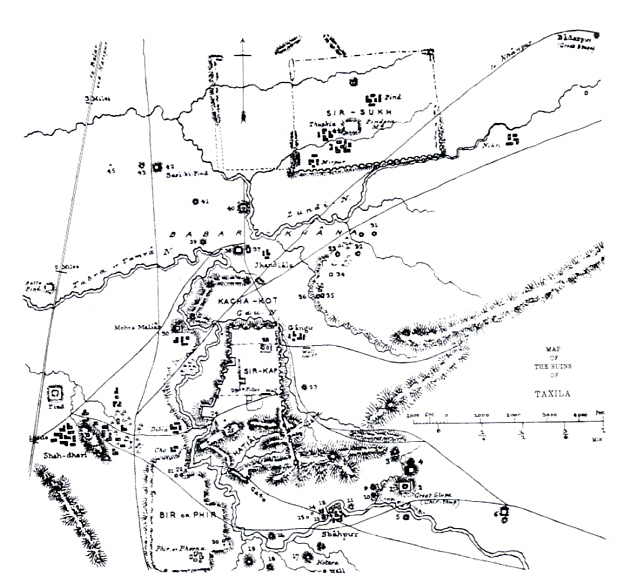
Abb.: Alexander Cunninghams Plan von Taxila in Archaeological survey of India.
Report. -- 2 (1871). -- vor S. 111
Cunningham schreibt über Taxila in seinem epochalen Werk "The ancient Geography of India" (1871):
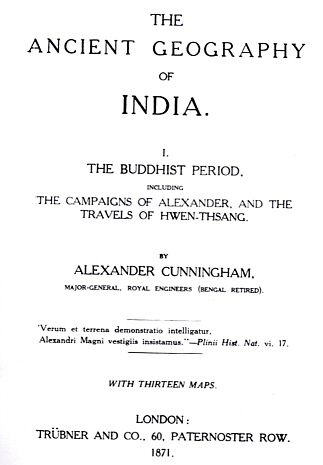
Abb.: Titelblatt
"TAXILA, OR TAKSHASILA.
Map IV.[S. 120] The position of the celebrated city of Taxila has hitherto remained unknown, partly owing to the erroneous distance recorded by Pliny, and partly to the want of information regarding the vast ruins which still exist in the vicinity of Shah-dheri. All the copies of Pliny agree in stating that Taxila was only 60 Roman, or 55 English, miles from Peucolaïtis, or Hashtnagar, which would fix its site somewhere on the Haro river, to the west of Hasan Abdāl, or just two days' march from the Indus. But the itineraries of the Chinese pilgrims agree in placing it at three days' journey to the east of the Indus,1 or in the immediate [S. 121] neighbourhood of Kāla-ka-sarāi, which was the third halting-place of the Mogul emperors, and which is still the third stage from the Indus, both for troops and baggage. Now as Hwen Thsang, on his return to China, was accompanied by laden elephants, his three days' journey from Takhshasila to the Indus at Utakhanda, or Ohind, must necessarily have been of the same length as those of modern days, and, consequently, the site of the city must be looked for somewhere in the neighbourhood of Kāla-ka-sarāi. This site is found near Shah-dheri, just one mile to the north-east of Kāla-ka-sarāi, in the extensive ruins of a fortified city, around which I was able to trace no less than 55 stūpas, of which two are as large as the great Mānikyāla tope, twenty eight monasteries, and nine temples. Now the distance from Shah-dheri to Ohind is 36 miles, and from Ohind to Hashtnagar is 38 more, or altogether 74 miles, which is 19 in excess of the distance recorded by Pliny between Taxila and Peukelaotis. To reconcile these discrepant numbers I would suggest that Pliny's 60 miles, or LX., should be read as 80 miles, or LXXX., which are equivalent to 73½ English miles, or within half a mile of the actual distance between the two places.
1 'Fa-Hian,' c. xi., Beal's translation, makes it seven days' journey from Peshawar, that is, four days to the Indus plus three days to Taxila. Sun-yun (Beal's translation, p. 200) places it three days to the east of the Indus. Hiouen Thsang makes it three days' journey to the southeast of the Indus (Julien's translation, i. 263). See Maps Nos. IV., V., and VI. for the position of Shah-dheri or Taxila.
The classical writers are unanimous in their accounts of the size and wealth of Taxila. Arrian describes it as "a large and wealthy city, and the most [S. 122] populous between the Indus and Hydaspes."1 Strabo also declares it to be a large city, and adds, that the neighbouring country was "crowded with inhabitants, and very fertile, "2 Pliny calls it "a famous city, situated on a low but level plain, in a district called Amanda."3 These accounts agree exactly with the position and size of the ancient city near Shah-dheri, the ruins of which are spread over several square miles.
1 'Anabasis,' v. 8: πολιν μεγαλην και ευδαιμονα
2 Geogr. xv. i. 17 ; xv. i. 28.
3 Hist. Nat., vi. 23. "Taxillae, cum urbe celebri, jam in plana demisso tractu, cui universo nomen Anandae."About fifty years after Alexander's visit, the people of Taxila rebelled against Bindusāra, king of Magadha, who sent his eldest son Susima to besiege the place. On his failure, the siege was entrusted to his younger son, the celebrated Aśoka ; but the people came out 2½ yojanas, or miles, to meet the young prince and offer their submission.4 At the time of Aśoka's accession the wealth of Taxila is said to have amounted to 36 kotis, or 360 millions of some unnamed coin, which, even if it was the silver tangka, or sixpence, would have amounted to nine karors of rupees, or £9,000,000. It is probable, however, that the coin intended by the Indian writer was a gold one, in which case the wealth of this city would have amounted to about 90 or 100 millions of pounds. I quote this statement as a [S. 123] proof of the great reputed wealth of Taxila within fifty years after Alexander's expedition. It was here that Aśoka himself had resided as Viceroy of the Panjāb during his father's lifetime; and here also resided his own son Kunāla, or the "fine-eyed," who is the hero of a very curious Buddhist legend, which will be described hereafter.
4 Burnouf, 'Introduction à l'Histoire du Buddhisme Indien,' p. 361.
Just before the end of the third century B.C. the descendants of the Maurya kings must have come in contact with the Bactrian Greeks under Demetrius, the son of Enthydemus, and in the early part of the following century Taxila must have formed part of the Indian dominions of Eukratides. In 126 B.C. it was wrested from the Greeks by the Indo-Scythian Sus or Abars, with whom it remained for about three-quarters of a century, when it was conquered by the later Indo-Scythians of the Kushān tribe, under the great Kanishka. During this period Parshāwar would appear to have been the capital of the Indo-Scythian dominions, while Taxila was governed by satraps. Several coins and inscriptions of these local governors have been found at Shah-dheri and Mānikyāla. Of these the most interesting is the copper plate obtained by Mr. Roberts, containing the name of Takhasila, the Pali form of Takshaśilā, from which the Greeks obtained their Taxila.1
1 See translation by Professor J. Dowson in Journ. Royal Asiat. Soc, xx. 221 ; see also notes on the same inscription by the author, Journ. Asiat. Soc. Bengal, 1863, P. 139.
[S. 124] During the reign of the Parthian Bardanes, A.D. 42 to 45, Taxila was visited by Apollonius of Tyana and his companion, the Assyrian Damis, whose narrative of the journey Philostratus professes to have followed in his life of Apollonius. His account is manifestly exaggerated in many particulars regarding the acts and sayings of the philosopher, but the descriptions of places seem to be generally moderate and truthful. If they were not found in the narrative of Damis, they must have been taken from the journals of some of Alexander's followers: and in either case they are valuable, as they supply many little points of information that are wanting in the regular histories. According to Philostratus, Taxila was "not unlike the ancient Ninus, and was walled in the manner of other Greek towns."1 For Ninus, or Nineveh, we must read Babylon, as we have no description of the great Assyrian city, which was destroyed nearly two centuries before the time of Herodotus. Now we know from Curtius that it was the "symmetry as well as the antiquity" of Babylon that struck Alexander and all who beheld it for the first time.2 I conclude, therefore, that Taxila must have reminded the Greeks of Babylon by its symmetry, as Philostratus goes on to say, that the city was "divided into narrow streets with great regularity." He mentions also a temple of the sun, which stood outside the walls, and a [S. 125] palace in which the usurper was besieged. He speaks also of a garden, one stadium in length, with a tank in the midst, which was filled by "cool and refreshing streams." All these points will be noticed in a separate work when I come to describe the existing ruins of this ancient city.
1 Vita Apollon., ii. 20.
2 Vita Alex., v. 1 : "'Pulchritudo ac vetustas."We now lose sight of Taxila until A.D. 400, when it was visited by the Chinese pilgrim Fa-Hian, who calls it Chu-sha-shi-lo, or the "severed head;" and adds, that "Buddha bestowed his head in alms at this place, and hence they gave this name to the country."1 The translation shows that the original Sanskrit name must have been Chutyasira, or the "fallen head," which is a synonym of Taksha-sīra, or the "severed head," the usual name by which Taxila was known to the Buddhists of India. In A.D. 502, "the place where Buddha made an alms-gift of his head" was visited by Sung-yun, who describes it as being three days' journey to the east of the river Sin-tu, or Indus.2
1 Beal's Translation, c. xi.
2 Beal's Translation, p. 200.We now come to Hwen Thsang, the last and best of the Chinese pilgrims, who first visited Ta-cha-shi-lo, or Takshaśilā, in A.D. 630, and again in A.D. 643, on his return to China. He describes the city as about 10 li, or 1 2/3 mile, in circuit. The royal family was extinct, and the province, which had previously been subject to Kapiśa, was then a dependency of Kashmir. The land, irrigated by [S. 126] numbers of springs and watercourses, was famous for its fertility. The monasteries were numerous, but mostly in ruins; and there were only a few monks who studied the Mahāyāna, or esoteric doctrines of Buddhism. At 12 or 13 li, or 2 miles, to the north of the city there was a stūpa of King Aśoka, built on the spot where Buddha in a former existence had made an alms-gift of his head; or, as some said, of one thousand heads in as many previous existences. This was one of the four great stūpas that were famous all over north-west India ;1 and accordingly on his return journey Hwen Thsang specially notes that he had paid his adorations, for the second time, to the "stūpa of the alms-gift of one thousand heads."2 The present name of the district is Chach-Hazāra, which I take to be a corruption of Sīrsha-sahasra, or the "thousand heads." In the Taxila copper-plate of the Satrap Liako Kujuluka, the name is written Chhahara-Chukhsa, which appears to me to be only another form of the same appellation.
1 'Fah-Hian,' (Beal's translation) c. xi.
2 Julien's 'Hiouen Thsang,' i. 262.From these accounts of the Chinese pilgrims, we see that Taxila was specially interesting to all Buddhists as the legendary scene of one of Buddha's most meritorious acts of alms-giving, when he bestowed his head in charity. The origin of this legend I think may be certainly traced to the name, which as Takshaśilā means simply the "cut rock;" [S. 127] but with a slight alteration, as Taksha-sīra means the "severed head." "Aut ex re nomen, aut ex vocabulo fabula,1 either the name sprang from the legend, or the legend was invented to account for the name." In this case we may be almost certain that the latter was the process, as the Greeks have preserved the spelling of the original name before Buddhism had covered the land with its endless legends of Śākya's meritorious acts in previous births. It is nowhere stated to whom Buddha presented his head, but I believe that it was offered to the hungry tiger whose seven cubs were saved from starvation by a similar offering of his blood.2 I am led to this belief by the fact that the land immediately to the north of the ruined city is still called Babar Khāna, or the "Tiger's House," a name which is as old as the time of Mahmud, as Abu Rihān speaks of Babarkān as being halfway between the Indus and the Jhelam.3 a description which is equally applicable to the Babarkhāna of the ancient Taxila. The name is a Turki one, and is, therefore, probably as old as the time of Kanishka. From the continued existence of this name, I infer that, in the immediate neighbourhood of the great stūpa of the "head-gift," there was most probably a temple enshrining a group in which Buddha was [S. 128] represented offering his head to the tiger. This temple the Turks would naturally have called the Babar-Khāna, or "Tigers'-house;" and as Taxila itself decayed, the name of the temple would gradually have superseded that of the city. The remembrance of this particular act of Buddha's extreme charity is, I believe, preserved in the name of Mārgala, or the "beheaded," which is applied to the range of hills lying only two miles to the south of Shah-dheri. Mārgala means literally "decollated," from gala-mārna, which is the idiomatic expression for "cutting the neck," or beheading.
1 Pomponius Mela, iii. 7.
2 Sun-yun mentions that the head was offered "for the sake of a man ;" that is, Buddha offered his own life to save that of another man. (Beal's translation, p. 200).
3 Reinaud's 'Fragments Arabes, etc.,' p. 116.The ruins of the ancient city near Shah-dheri, which I propose to identify with Taxila, are scattered over a wide space extending about 3 miles from north to south, and 2 miles from east to west. The remains of many stūpas and monasteries extend for several miles further on all sides, but the actual ruins of the city are confined within the limits above-mentioned. These ruins consist of several distinct portions, which are called by separate names even in the present day.1 The general direction of these different works is from south-south-west to north-north-east, in which order I will describe them. Beginning at the south, their names are : —
- Bir or Pher.
- Hatiāl.
- Sir-Kap-ka-kot. [S. 129]
- Kacha-kot.
- Babar Khāna.
- Sir-Suk-ka-kot.
1 See Map No. IV.
The most ancient part of these ruins, according, to the belief of the people, is the great mound on which stands the small village of Bir or Pher. The mound itself is 4000 feet in length from north to south, and 2600 feet in breadth, with a circuit of 10,800 feet, or rather more than two miles. On the west side towards the rock-seated village of Shah-dheri, the Bir mound has an elevation of from 15 to 25 above the fields close by; but as the ground continues to slope towards Shah-dheri, the general elevation is not less than from 25 to 35 feet. On the east side, immediately above the Tabrā, or Tamrā Nala, it rises 40 feet above the fields, and 68 feet above the bed of the stream. The remains of the walls can be traced only in a few places both on the east and west sides; but the whole surface is covered with broken stones and fragments of bricks and pottery. Here the old coins are found in greater numbers than in any other part of the ruins; and here, also, a single man collected for me, in about two hours, a double handful of bits of lapis lazuli, which are not to be seen elsewhere. Judging from the size of the place, I take it to be the site of the inhabited part of the city in the time of Hwen Thsang, who describes it as being only 10 li, or 1 2/3 mile, in circuit. This conclusion is confirmed by the position of the great ruined stūpa in the midst of the Babarkhāna land, which is 8000 feet north-north-east [S. 130] from the near end of the Bir mound, and 10,000 feet, or just 2 miles, from the main entrance to the middle of the old city. As Hwen Thsang describes the position of the stūpa of the "Head Gift" as being 12 or 13 li, or rather more than 2 miles, to the north of the city,1 I think that there can be little doubt that the city of his time was situated on the mound of Bir. I traced the remains of three small topes on the north and east sides of the mound, all of which had been opened previously by the villagers, who, however, stoutly denied the fact, and attributed the explorations to General Abbott and Major Pearse.
1 Julien's 'Hiouen Thsang,' ii. 153.
Hatiāl is a strong fortified position on the west end of a spur of the Mārgala range, and immediately to the north-east of the Bir mound, from which it is separated by the Tabrā Nala. About half a mile from Bir the spur is divided into two nearly parallel ridges, about 1500 feet apart, which run almost due west to the bank of the Tabrā, where they are joined by a high earthen rampart. The clear space thus enclosed is not more than 2000 feet by 1000 feet, but the whole circuit of the defences, along the hill-ridges and the artificial ramparts, is about 8400 feet, or upwards of 1½ mile. At the east end the two parallel ridges are joined by stone walls, 15 feet 4 inches thick, with square towers at intervals, all of which are still in very good order. The crest of the south or main ridge is 291 feet above the general level of the fields, but the north ridge has an elevation of [S. 131] only 163 feet. Between these two there is a small rocky ridge, 206 feet in height, crowned by a large bastion or tower, which the people look upon as a stūpa or tope. There is a similar tower on the crest of the north ridge, which I was induced to excavate by the report of a villager named Nūr, who informed me that he had found a copper coin at each of the four corners of the basement, which he considered as a certain sign that the building was a tope. I knew also that it was the custom in Barma to erect a stūpa in each of the corner bastions of their square fortified cities. But my excavation, which was carried down to the bare rock, a depth of 26 feet, showed only regular courses of large rough blocks, which were extracted with much difficulty. Close to the west of this tower I traced the remains of a large enclosure, 163 feet long by 151½ feet broad, divided into rooms on all four sides, from which I at first thought that the building was a monastery. But the subsequent discovery of a large quantity of burnt clay pellets of a size well adapted for slingers led me to the conclusion that the place was most probably only a guard-house for soldiers. The two ridges fall rapidly towards the west for about 1200 feet, till they meet the general slope of the intervening ground, and at these points are the two, gateways of the fort, the one being due north of the other. The north ridge then rises again, and running to the west-south-west for 2000 feet, terminates in a square-topped mound, 130 feet high. This part of the ridge is entirely covered with the remains of buildings, [S. 132] and near its east end the villager Nūr discovered some copper coins in a ruined tope. Of the name of Hatiāl I could obtain no information whatever; but it is probably old, as I think it may possibly be identified with Hattiār-Lank, which Abul Fazl places in the Sindh-Sāgar Doab. The spelling of the name would refer it to Hatti, a shop, and Hatti-āla would then be the market-place or bazaar. But the Hatiāl fort is so evidently the stronghold or citadel of this ancient place that I look upon this derivation as very doubtful.
The fortified city of Sir-kap is situated on a large level mound immediately at the north foot of Hatiāl, of which it really forms a part, as its walls are joined to those of the citadel. It is half a mile in length from north to south, with a breadth of 2000 feet at the south end, but of only 1400 feet at the north end. The circuit of Sirkap is 8300 feet, or upwards of 1½ mile. The walls, which are built entirely of squared stone, are 14 feet 9 inches thick, with square towers of 30 feet face, separated by curtains of 140 feet. The east and north walls are straight, but the line of west wall is broken by a deep recess. There are two large gaps in each of these walls, all of which are said to be the sites of the ancient gates. One of these in the north face is undoubted, as it lies due north of the two gateways of the Hatiāl citadel, and due south of the three ruined mounds in the Babar-khāna. A second in the east face is equally undoubted, as parts of the walls of the gateway still remain, with portions of paved roadway leading directly up to it. A third [S. 133] opening in the west face, immediately opposite the last, is almost equally certain, as all the old foundations inside the city are carefully laid out at right angles due north and south. The position of Sirkap is naturally very strong, as it is well defended on all sides,—by the lofty citadel of Hatiāl on the south, by the Tabrā Nala on the west, and by the Gau Nala on the east and north sides. The entire circuit of the walls of the two places is 14,200 feet, or nearly 2 3/4 miles.
Kacha-kot, or the "mud fort," lies to the north of Sirkap, in a strong isolated position formed by the doubling round of the Tabrā Nala below the junction of the Gau Nala, which together surround the place on all sides except the east. The ramparts of Kacha-kot, as the name imports, are formed entirely of earth, and rise to a height of from 30 to 50 feet above the stream. On the east side there are no traces of any defences, and inside there are no traces of any buildings. It is difficult therefore to say for what purpose it was intended; but as the Gau Nala runs through it, I think it probable that Kacha-kot was meant as a place of safety for elephants and other cattle during a time of siege. It is 6700 feet, or upwards of 1¼ mile in circuit. The people usually called it Kot, and this name is also applied to Sir-kap, but when they wish to distinguish it from the latter they call it Kacha-kot. Now this name is found both in Baber's 'Memoirs,' and in the 'Ayin Akbari.' In the former the Haro river is called the river of Kacha-kot, which therefore must have been [S. 134] some large place near the banks of that stream, but I suspect that it ought rather to be looked for near Hasan Abdāl, or even lower down.
Babar Khāna is the name of the tract of land lying between the Lundi Nala on the north and the Tabrā and Gau Nalas on the south. It includes Kacha-kot, and extends about one mile on each side of it to the east and west, embracing the great mound of Seri-ki-Pind on the north-west, and the Gāngu group of topes and other ruins on the east. In the very middle of this tract, where the Lundi and Tabrā Nalas approach one another within one thousand feet, stands a lofty mound, 45 feet in height, called Jhaṇḍīāla Pind, after a small hamlet close by. To the west of the Pind, or mound, there is another mass of ruins of greater breadth, but only 29 feet in height, which is evidently the remains of a large monastery. It is remarkable that the road which runs through the two gateways of the Hatiāl citadel, and through the north gateway of Sirkap, passes in a direct line due north between these two mounds until it meets the ruins of a large stūpa, on the bank of the Lundi river, 1200 feet beyond the Jhaṇḍīāla Pind. This last I believe to be the famous "Headgift Stupa" which was said to have been erected by Aśoka in the third century before Christ. I have already alluded to its position as answering almost exactly to that described by Hwen Thsang; and I may now add as a confirmation of this opinion that the main road of the city of Taxila was laid in a direct line running due north upon the Jhaṇḍīāla [S. 135] stūpa, a fact which proves incontestably the very high estimation in which this particular monument must have been held. This is further confirmed by the vicinity of another mound, 3600 feet to the northwest, called Seri-ki-pind, or Siri-ki-pind, which would appear to refer directly to the "Head Gift," as the Sīrshā-dānam, or Sir-dān of Buddha. Taking all these points into consideration, I think that there are very strong grounds for identifying the great ruined tope of Babar-khāna with the famous stūpa of the "Head Gift" of Buddha.
The large fortified enclosure called Sir-Suk is situated at the north-east corner of the Babar-khāna. beyond the Lundi Nala. In shape it is very nearly square, the north and south sides being each 4500 feet in length, the west side 3300 feet, and the east side 3000 feet. The whole circuit, therefore, is 15,300 feet, or nearly 3 miles. The south face, which is protected by the Lundi Nala, is similar in its construction to the defences of Sir-kap. The walls are built of spared stones, smoothed on the outer face only, and are 18 feet thick, with square towers at intervals of 120 feet. The towers of this face have been very carefully built with splayed foundations, all the stones being nicely bevelled to form, a smooth slope. The tower at the south-east corner, which is the highest part now standing, is 10 feet above the interior ground, and 25 feet above the low ground on the bank of the stream. Towards the west end, where the stones have been removed, the south wall is not more than 2 or 3 feet in height, about the [S. 136] interior ground. Of the east and west faces, about one-half of the walls can still be traced, but of the north face there is but little left except some mounds at the two corners. Inside there are three villages named Mirpur, Tupkia, and Pind, with a large ruined mound, called Pindora, which is 600 square feet at base. To the south of Pindora, and close to the village of Tupkia, there is a Khāngāh, or shrine of a Muhammadan saint, on a small mound. As this is built of squared stones, I presume that the Khāngāh represents the position of a stūpa or tope which must have given its name to the village of Tupkia, and that the great Pindora mound is the remains of a very large monastery. I found two massive channelled stones, or spouts, which, from their size, could only have been used for conveying the rain-water from a courtyard to the outside of the walls. At half a mile to the west there is an outer line of high earthen mounds running due north and south for upwards of 2000 feet, when it bends to the east-north-east. Beyond this the line is only traceable by a broad belt of broken stones, extending for 3500 feet, when it turns to the south-east for about 1200 feet and joins the north face of Sir-Suk. These external lines would appear to be the remains of a large outwork which once rested its north-west angle on the Lundi Nala. The entire circuit of Sir-Suk and its outwork is about 20,300 feet, or nearly 5 miles.
I have now described all the different parts of this great city, the ruins of which, covering an area [S. 137] of six square miles, are more extensive, more interesting, and in much better preservation than those of any other ancient place in the Panjāb. The city of Sirkap, with its citadel of Hatiāl, and its detached works of Bir and Kacha-kot, has a circuit of 4 3/4 miles; and the large fort of Sir-Suk, with its outwork, is of the same size, each of them being nearly as large as Shah Jahan's imperial city of Delhi. But the number and size of the stūpas, monasteries, and other religious buildings are even more wonderful than the great extent of the city. Here both coins and antiquities are found in far greater numbers than in any other place between the Indus and Jhelam. This then must be the site of Taxila, which, according to the unanimous testimony of ancient writers, was the largest city between the Indus and Hydaspes. Strabo and Hwen Thsang both speak of the fertility of its lands, and the latter specially notices the numbers of its springs and water-courses. As this description is applicable only to the rich lands lying to the north of the Tabrā Nala, which are amply irrigated by numerous channels drawn from the Haro river, the proof of my identification is complete. Burnes crossed this tract in 1832, when he encamped at Usmān Khatar, 3 miles to the north of Shah-dheri, and about 1 mile to the south of the Haro river. He describes the village as standing "on a plain at the mouth of a valley close to the base of the outlying hills."1 This agrees most exactly with the accounts [S. 138] of Strabo and Pliny, who describe Taxila as situated in a level country where the hills unite with the plains. Of Usmān, Burnes goes on to say that "its meadows are watered by the most beautiful and crystal rivulets that flow from the mountains." In the first part of this statement he is quite correct; but in the latter part he is undoubtedly wrong, as every rill of water that passes through Usmān is drawn by artificial means from the Haro river. Two miles to the south, towards the ruins of the old city, the irrigation is carried on by cuts from the Lundi Nala, but as the main body of water in this stream is artificially obtained from the Haro, the whole of the irrigation may be truly said to be derived from that river.
1 Travels," ii, 61.
The district of Taxila is described by Hwen Thsang as being 2000 li, or 333 miles, in circuit. It was bounded by the Indus on the west, by the district of Urasa on the north, by the Jhelam or Behat river on the east, and by the district of Sinhapura on the south. As the capital of the last was in the Salt range of mountains, either at or near Ketās, the boundary of Taxila on that side was most probably defined by the Suhān river to the south-west, and by the Bakrāla range of hills to the south-east. Accepting these limits as nearly correct, the frontier lines of the Indus and Jhelam will be respectively 80 miles and 50 miles in length, and those of the northern and southern boundaries 60 and 120 miles, or, all together, 310 miles, which accords very nearly with the measurement given by Hwen Thsang. [S. 139]
Mānikyāla
The great stūpa or Buddhist monument of Mānikyāla, was first made known by the journey of Elphinstone,1 and has since been explored by Generals Ventura and Court. The name is said to have been derived from Raja Mān, or Mānik.2 who erected the great stūpa. This tradition is probably correct, as I discovered a coin and relic deposit of the Satrap Jihoniya, or Zeionises, the son of Manigal, in a small tope to the east of the village. The old town, which is usually called Mānikpur, or Māniknagar, is the scene of the curious legend of Rāsālu, who expelled the Rākshasas, or Demons, and delivered the people from the tyranny of Sir-kap, the "decapitator," and his brothers.
1 'Cabul,' i. 106. Stūpa is the Sanskrit term for a mound or barrow, either of masonry or of earth ; see Colebroke, 'Amara Kosha,' in voce. The Pāli form is Thūpo ; see Turnour 'Mahāwanso,' and also Thūpa, or Thūva, in the early Arian inscriptions from the Punjāb.' The term now used is Thūp for a tolerably perfect building, and Thūpi for a ruined mound. It is, therefore, very much to be regretted that we should have adopted the word Tope, which preserves neither the spelling nor the pronunciation of the native word.
2 Moorcroft, 'Travels.' ii. 311.The name of Mānikyāla is not mentioned by any of the Chinese pilgrims, although every one of them has described the situation of the place. Fa-Hian merely states that at two days' journey to the east of Taxila is the spot where Buddha "gave his [S. 140] body to feed a starving tiger."1 But Sung-yun fixes the scene of this exploit at eight days* journey to the south-east of the capital of Gāndhāra,2 which is a very exact description of the bearing and distance of Mānikyāla, either from Peshāwar or from Hashtnagar. Lastly, Hwen Thsang places the site of the "Body-offering" at 200 li, or nearly 34 miles, to the south-east of Taxila.3 which are the exact bearing and distance of Mānikyāla from Shah-dheri; but his statement that he crossed the Sin-tu, or Indus, is a simple mistake for the Suhān or Süān river, which flows between the two places.4
1 Beal's translation of 'Fa-Hian,' c. xi. p. 32.
2 Beal's translation of 'Sung-yun,' p. 193.
3 Julien's 'Hiouen Thsang,' ii. 164.
4 See Maps Nos. V. and VI.
Map VI.The great stūpa of the "Body-offering" I have identified with the monument that was opened by General Court,5 which, according to the inscription found inside, was built in the year 20, during the reign of the great Indo-Scythian prince Kanishka, shortly before the beginning of the Christian era. Mānikyāla was, therefore, one of the most famous places in the Panjāb at a very early period; but I think that it must have been the site of a number of large religious establishments rather than that of a great city. General Abbott, when he examined the ruins around the Mānikyāla tope in 1853, could "not see any evidence of the existence of a city. The area occupied by submerged ruins would not [S. 141] have comprised a very considerable village, while the comparatively large number of wrought stones denotes some costly structure which might have occupied the entire site."1 In 1834, General Court described "the ruins of the town itself as of very considerable extent, massive walls of stone and lime being met with everywhere, besides a great number of wells." After a careful examination of the site, I have come to the same conclusion as General Abbott, that there are no traces of a large city; and I am quite satisfied that all the massive walls of cut stone, which General Court truly describes as being met with everywhere, must have belonged to costly monasteries and other large religious edifices. Doubtless, a few private houses might be built of squared stones even in a village, but these massive edifices, with their thickly gilded roofs, which still repay the labour of disinterment, arc, I think, too numerous, too large, and too scattered to be the remains of private buildings even of a great city. The people point to the high ground immediately to the west of the great tope, as the site of the Raja Mān's palace, because pieces of plaster are found there only, and not in other parts of the ruins. Here it is probable that the satraps of Taxila may have taken up their residence when they came to pay their respects at the famous shrine of the "Body-gift of Buddha. Here, also, there may have been a small town of about 1500 or 2000 houses, which [S. 142] extended to the northward, and occupied the whole of the rising ground on which the village of Mānikyāla now stands. I estimate the entire circuit of the space that may have been occupied by the town as about one mile and a half, which, at 500 square feet per man, would give a population of 12,500 persons, or just six persons to each house.
5 Journ. Asiat. Soc. Bengal, 1834, p. 562.
1 Journ. Asiat. Soc. Bengal, p. 570.The people are unanimous in their statements that the city was destroyed by fire; and this belief, whether based on tradition or conviction, is corroborated by the quantities of charcoal and ashes which are found amongst all the ruined buildings. It was also amply confirmed by the excavations which I made in the great monastery to the north of General Courts Tope. I found the plaster of the walls blackened by fire, and the wrought blocks of kankar limestone turned into quicklime. The pine timbers of the roofs also were easily recognized by their charred fragments and ashes. Unfortunately, I discovered nothing during my researches that offered any clue to the probable period of the destruction of these buildings, but as this part of the country had fallen into the power of the Kashmirian kings, even before the time of Hwen Thsang, I am inclined to attribute their destruction rather to Brahmanical malignity than to Muhammadan intolerance."
[Quelle: Cunningham, Alexander <1814 - 1893>: The ancient geography of India. -- London : Trübner, 1871. -- 770 S. : Ill. -- S. 120 - 142.]
Von 1913 bis 1934 wurde unter der Leitung von John Marshall archäologisch gegraben. John Marshall schreibt darüber im Vorwort zu seiner monumentalen und vorbildlichen Monographie über Taxila:
"PREFACE It is upwards of forty years since I first visited Taxila and I still remember the thrill I got from the sight of its buried cities. At that time I was a young man, fresh from archaeological excavations in Greece and filled with enthusiasm for anything Greek; and in that far-off corner of the Panjāb it seemed as if I had lighted of a sudden on a bit of Greece itself. Doubtless the illusion was prompted in a large measure by Taxila's historic associations with Greece; for it was in Taxila that Alexander the Great halted and refreshed his army before advancing to do battle with Porus; and it was here that Greek kings afterwards ruled for a hundred years and left behind them an enduring legacy of Hellenistic culture. But there was more to it than that. I felt then, as I have never ceased to feel since, that there was something appealingly Greek in the countryside itself: in the groves of wild olive on the rocky slopes, in the distant pine-clad hills below Murree, and in the chill, invigorating air that blows from the snow-fields beyond the Indus. No wonder that I was all eagerness to get to work on such an alluring site and uncover with pick and spade whatever might be left of its ancient secrets. But there were difficulties in the way I could not then foresee.
When I submitted my proposals to the Government, the Commissioner of the Rāwalpindi Division, in which part of the site is located, represented that Taxila was uncomfortably near the frontier, that there were many criminal elements in the local population, and that any disturbance of the ancient mounds might easily lead to trouble. And as the Local Government endorsed his views, there was nothing I could do but wait patiently for a more favourable opportunity. So for ten long years I waited; then Sir Louis Dane became Lieutenant-Governor of the Panjāb and less timid counsels prevailed. Today, with more than twenty years' intimate knowledge of the neighbourhood, I cannot but marvel that the people of Taxila should have been so little understood by our own officials. Of course there are unruly characters among them. Where on the North-West Frontier are there not? But for my own part I always found them sober, industrious and very genial folk, who were ever ready to greet one with a smile; nor do I remember having experienced, during all the years I was among them, any trouble worth the mention. Certainly I could not have wished for a steadier or more pleasant crowd of diggers than those who toiled with me at Taxila; and let us not forget that it is to the toil and sweat of the diggers that, first and foremost, we owe the vast majority of our archaeological treasures.
There can be few archaeologists now living who have devoted as many years to the excavation of a single site as I have devoted to Taxila. I started work there in the spring of 1913 and continued it almost every autumn and spring (the only seasons when digging is feasible) until 1934. The manifold discoveries made in the [S. xvi] course of those twenty-two years have thrown a flood of new light on the political and religious history of the North-West and in many respects revolutionised our knowledge of its material culture, during lengthy periods between 500 b.c. and a.d. 500. They have shown us, often with tragic clearness, how during those centuries Taxila was time and again destroyed and then rebuilt by invaders from the East and West who successively made themselves masters of the Panjāb, notably by the Mauryas, the Bactrian Greeks, the Śakas, the Parthians and the Kushāns; and how it was left to the White Huns at the close of the fifth century to destroy the city finally and never attempt to rebuild it.
Not all these cities (there were not less than twelve of them) occupied the same site. The first four, including that of the Mauryas and its immediate predecessor, in which Alexander the Great took up his quarters, were located on the Bhiṛ Mound. Then, at the beginning of the second century b.c., the city was shifted from the Bhiṛ Mound to Sirkap and laid out on the typical 'chess-board' pattern then in fashion in the Hellenistic world and in striking contrast with the crooked streets and haphazard planning of the earlier cities of the Bhiṛ Mound. And this chess-board pattern was afterwards preserved in the later cities on the Sirkap site which the Śakas and Parthians erected on the ruins of the Greek. Finally, towards the close of the first century a.d., the city was again shifted by the conquering Kushāns from Sirkap to Sirsukh and laid out and fortified in conformity with their own traditional ideas, which differed materially from the Greek.
For the exploration of these various cities much remains to be done. It is a work, indeed, that may well go on for a century or more. My own efforts have been mainly concentrated on the remains near the surface, viz. on the Parthian city in Sirkap and on the Maurya city on the Bhiṛ Mound, but chiefly on the former. Wherever I could do so without sacrificing anything of value in the upper strata, I opened up small sections of the earlier settlements and so obtained a slight idea of their character and age, and of the structural remains and minor antiquities likely to be found in them. But the only city that I was able to excavate on a really extensive scale and on systematic lines was the Parthian, and it is from this city that the bulk of the antiquities described in the second volume of this work have come. Naturally it was a disappointment to me to find the Greek city buried so deep as to preclude for the present its more thorough exploration. But from an archaeological point of view the Parthian city is perhaps more valuable than the Greek will prove to be; for we know far more about the Hellenistic way of life than about the Parthian, and among the few Parthian cities that have been excavated in the Near or Middle East the one at Taxila takes the foremost place. This at any rate is the opinion expressed by that eminent authority on Parthian antiquities, Professor M. Rostoftzeff. Its value, too, is greatly enhanced by the remarkably rich collection of implements, tools, weapons, domestic utensils, ornaments, toilet articles, silverware, gold and silver jewellery, toys and other small objects which their owners had buried or abandoned in haste when the city was sacked by the Kushāns. For India, this collection of objects illustrative of the daily life of the [S. xvii] people is more than usually valuable, since it is the only really representative collection of such objects belonging to the historic period that exists, an observation which is true not only of the North-West but of the whole Indian peninsula.
Apart from all these excavations inside the cities' walls, much labour was also expended on exploring among the multitude of religious monuments in the suburbs or in the neighbouring hills and valleys, where their ruins occupy almost every available site. Prominent among these monuments and one of the earliest is the fine Ionic temple at Jaṇḍiāl, which may have been built (though this is by no means certain) for Fire worship. But, with this single exception, all the religious foundations which have so far been excavated outside the cities belong to the Buddhist faith and present us with a graphic picture, or perhaps I should rather say film, of the development of Buddhism during a most critical period of its history, from the first century b.c. to the fifth century a.d. Incidentally, also, they reveal for the first time the story of the two great schools of art in the North-West —the Gandhāra and the Indo-Afghān—and show how both flourished under Kushān patronage, the Gandhāra under that of the early Kushāns from V'ima Kadphises to Vāsudeva I, and the Indo-Afghān under that of the Kidāra Kushāns.
Much that is contained in these volumes has already seen the light of day in my Annual Reports published between 1913 and 1934, and is therefore more or less familiar to students. But I am sure that students will share my view that in a prolonged campaign of work such as I have carried through at Taxila Annual Reports, however diligently they may have been prepared, are not enough. In such an excavation there comes a time when the entire body of data has to be re-examined and coordinated, and a comprehensive account of the whole put at the service of archaeologists and historians. Unless this is done, the labour of years will inevitably lose much of its value and scientific interest. And this is a task which only the excavator himself can adequately perform; for he alone possesses the requisite knowledge of the site and of the circumstances attending each individual find; and by virtue of his long familiarity with the subject he is in the best position to appreciate its problems and its pitfalls. I am not of course suggesting that an excavator can claim any more finality for his conclusions than others, or that he should be in any way more exempt from criticism. On the contrary, I hold that an excavator's first duty, after finishing his excavation, is to present fellow-students with the facts in such detail that they are left in no doubt as to the precise find-spot and character of each and every object, and are thus able to form their own judgement on them. And I am equally strong in holding that he should endeavour, wherever possible, to preserve the structural remains he has uncovered until such time at least as they can be examined by other archaeologists with all the relevant facts in their possession. It is for these reasons that I have been at pains to save and conserve virtually all that could be saved of the Parthian city in Sirkap, though many of the buildings in it may seem to possess little intrinsic value; and that I now offer to fellow-students this final account of my discoveries, in the hope that they will find in it all that they want to know, or perhaps I should say all that I can tell them, about these [S. xviii] monuments and antiquities. Possibly some readers may think that the minutiae I have given, particularly in regard to the smaller objects, are in many cases superfluous. It may be that in nine out of ten cases they will prove to be so, but it is the tenth case for which one has to allow, and unfortunately one does not know which the tenth case is going to be.
The writing of this book has not been easy. Even in normal times and in the most favourable conditions the task of handling so large a mass of material, and particularly the many thousands of minor antiquities, would have been burdensome enough. It was made doubly so under the stress of failing health and the inevitable wear and tear of the Second World War, which, besides many other penalties, cost me the loss by 'enemy action' of more than four hundred pages of my records and notes. Some of these I was able to replace with the help of duplicates kept for safety's sake at Taxila; others I could not replace, and have had to fall back occasionally on my memory. For any shortcomings due to this loss, which affects in particular the latter part of chapter 4 and chapters 11, 13, 15, 16 and 38, my readers will, I am sure, be indulgent. I earnestly hope that they will also be indulgent in regard to the many other defects in this work, which are less excusable.
In bringing to a close an enterprise to which I have devoted some of the best years of my life, my thoughts go back to the many colleagues and friends who have helped and encouraged me during its long progress. To Mr Harold Hargreaves I owe a debt of gratitude which dates back to our early days together at Taxila, where he organised the first season's excavation and himself opened up the initial trial trenches in Sirkap. Since those far-off days in 1913, Mr Hargreaves has never ceased to take a warm interest in every fresh discovery, and has now put me under further obligations by contributing to these volumes the detailed description of the Gandhāra sculptures in chapter 36. I recall, too, with gratitude the willing and zealous service rendered over a long stretch of years by my excavation assistant, Khan Sahib A. D. Siddiqi, and by others who are no longer among us: by Mr Natesa Aiyar, who superintended much of the digging among the Jaulian group of monuments; by Mr Ghulam Qadir, an officer of untiring energy, who was particularly identified with the excavation of the Jaṇḍiāl temple and of the Giri and Dharmarājikā Stūpas; by Mr M. Gupta, until recently Curator of the Taxila Museum, where he was responsible for setting up, with endless patience and dexterity, the splendid array of stucco reliefs displayed on its walls; and lastly by my two talented draftsmen Messrs Sohan Lall and Gh. Sufi, who executed most of the drawings reproduced in this book.
Other scholars and scientists to whom I am much indebted for contributions to these volumes are: Professor F. W. Thomas and Dr L. Barnett, who kindly furnished the two notes on ancient Indian Universities in Appendix B to chapter 2; Dr B. S. Guha of the Ethnographic Survey and his colleagues, Messrs S. Sarkar and H. K. Bose, whose report on the skeletal remains from the Dharmarājikā monastery appears in chapter 12; the late Sir Robert Hadfield, who arranged for the analyses [S. xix] of the specimens of iron and steel described in the Introduction to chapter 27; Mr Sana Ullah, the archaeological chemist, who supplied the analyses and notes on copper and bronze objects in chapter 28; Monsieur A. Foucher, who contributed the valuable observations on the Gandhāra sculptures to the Introduction to chapter 36; Dr R. B. Whitehead, who besides revising my catalogue of Rare and Unique Coins in chapter 39 has added a critical commentary on the most important among them; Mr E. H. C. Walsh, who has discussed in chapter 40 the two large hoards of punch-marked coins from the Bhiṛ Mound; and Dr John Allan of the British Museum, whose illuminating remarks on the earlier coins down to the close of the Greek period form the subject of the concluding chapter. To Col. R. B. Sewell and Dr F. N. Pryce I am also under no small obligation: to the former for revising the catalogue of shell objects in chapter 33, to the latter for many helpful notes on the Hellenistic and Roman antiquities.
The many debts I owe to the published works of others are duly acknowledged in the text and notes, but there are two books to which I am in a special measure beholden. One is the first volume of the Cambridge History of India, in which the late Professor E. J. Rapson laid down a solid groundwork for the history of the Greeks, Śakas and Parthians in India; the other is Dr W. W. Tarn's brilliant and inspiring work, The Greeks in Bactria and India, which presents us for the first time with a really coherent and reasoned account of the same obscure period—an account for which I cannot sufficiently express my admiration, notwithstanding that in a few minor particulars I have ventured to question the author's conclusions.
Lastly, I wish to pay a tribute of lasting gratitude to my wife, who took part with me in all my excavations at Taxila and to whom the consummation of this work owes more than I can say.
JOHN MARSHALL
Guildford 25 November 1945"
[Quelle: Marshall, John <1876 - 1958>: Taxila : an illustrated account of archaeological excavations carried out at Taxila under the orders of the Government of India between the years 1913 and 1934. -- Cambridge : Univ. Pr., 1951. -- 3 vols. -- Vol. 1: Structural remains. -- 1951. -- XIX, 397 S. -- 29 cm. -- S. xv - xix.]
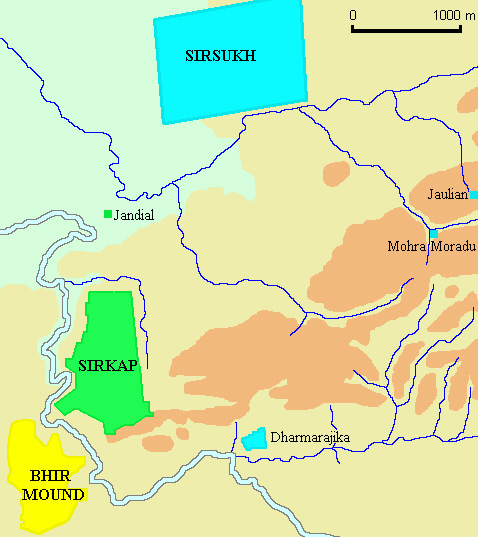
Abb.: Lage der wichtigsten Grabungsstätten in Taxila
[Bildquelle: Livius. --
http://www.livius.org/a/pakistan/taxila/bhir.html. -- Zugriff am 2008-04-05.
-- "© Marco Prins and Jona Lendering. Photos can be downloaded and used for
non-commercial purposes, but you have to acknowledge Livius."]
Sir Mortimer Wheeler, der Nachfolger von John Marshall im Archaeological Survey of India, schreibt zu der Bildung von Ablagerungsschichten (Strata) in Taxila:
"Wenn wir die geologischen Ablagerungen verlassen und uns den Schichten zuwenden, die hauptsächlich der menschlichen Besiedlung ihre Entstehung verdanken, sind die Schlussfolgerungen weniger sicher. Es ist unmöglich, irgendeine Gesetzmäßigkeit aufzustellen, die die Angleichung der durch den Menschen entstandenen Ablagerungen an eine absolute Zeitskala erlaubt. Dazu ein Beispiel: In einem Ort (Chandravalli), den ich in Indien ausgrub, verteilten sich Münzen, die offensichtlich keiner früheren Zeit als 50 v. Chr. entstammen und auch nicht viel jünger als 200 n. Chr. sein konnten, über eine Schichtdecke von 1,50 m Tiefe; diese umfasste also wahrscheinlich nicht mehr als zwei Jahrhunderte. Bei Grabungen im heutigen Pakistan im Jahr 1944 — 1945 an dem berühmten Orte Taxila (Sirkap) ergab sich, dass in zwei Jahrhunderten einer dichten Besiedlung eine Boden- und Scherbenschicht von 1,80 m bis 2,70 m Dicke abgelagert worden war. In einem früheren Besiedlungsabschnitt Taxilas (am Bhir Mound), an einem allerdings unübersichtlichen Ort, wurden etwa 4,50 m dem Zeitraum von drei Jahrhunderten zugewiesen; aber die Mauern und Baumethoden waren hier so kurzlebiger Art, dass die Ablagerungen auch gut besonders schnell erfolgt sein konnten. Jedenfalls ist immer eine Unzahl von unbekannten und wechselnden Faktoren mit eingeschlossen, die eine sachliche Berechnung auf Grund der Schichtdicke praktisch ausschließen. Trotzdem hat Petrie es gewagt, gestützt auf die jahreszeitlichen Regelmäßigkeiten im Niltal. Er behauptete: <Es ist im allgemeinen möglich, das letzte Datum einer Stadt nach den obenaufliegenden Scherben anzugeben; man kann eine Wachstumsrate von 50 cm pro Jahrhundert annehmen, bis zum erkennbaren Grundhorizont hinab; wenn wir damit einen sehr langen Zeitraum erhalten, können wir weiterhin den mit Sicherheit künstlichen [S. 37] Horizont um 10 cm im Jahrhundert erhöhen wegen der Nilablagerungen über dem bebauten Land> — usw. Solche Berechnungen sind, wenn überhaupt, nur von rein akademischem oder abstraktem Interesse. Sie lassen keinen Spielraum für die nicht fassbaren Gegebenheiten und Unsicherheiten, die, in der menschlichen wie in der geologischen Geschichte, den starren Grenzen mathematischer Formeln trotzen." [Quelle: Wheeler, Robert Eric Mortimer <1890 - 1976>: Moderne Archäologie : Methoden u. Technik d. Ausgrabung / Sir Mortimer Wheeler. -- Reinbek b. Hamburg : Rowohlt, 1960. -- 244 S. : Ill. ; 19 cm. -- (rowohlts deutsche enzyklopädie ; 111/112). -- Originaltitel: Archaeology from the earth (1954). -- S. 36f.]
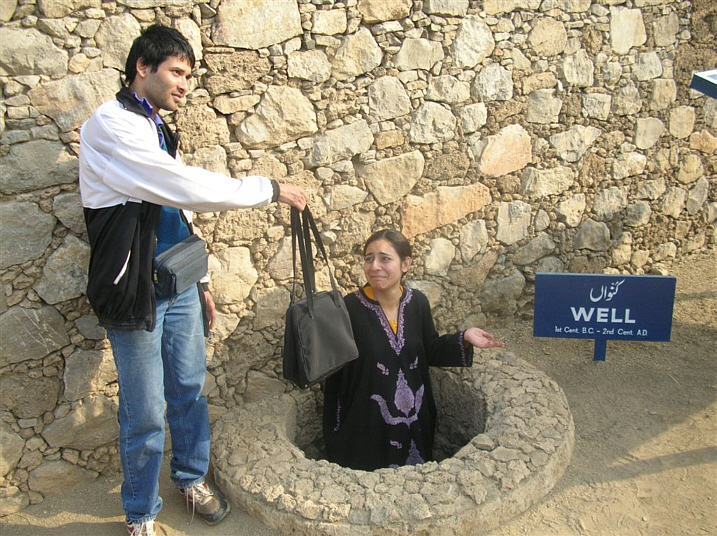
Abb.: Brunnen, Taxila
[Bildquelle: Hemanshu Kumar. --
http://www.flickr.com/photos/hemanshu/86181516/. -- Zugriff am 2008-03-20.
--
![]()
![]()
![]() Creative
Commons Lizenz (Namensnennung, keine kommerzielle Nutzung, keine Bearbeitung)]
Creative
Commons Lizenz (Namensnennung, keine kommerzielle Nutzung, keine Bearbeitung)]
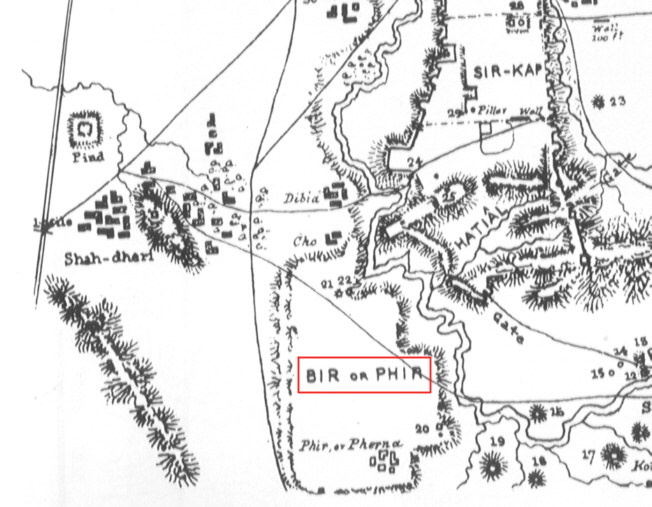
Abb.: Lage des Bhiṛ Mound
[Bildquelle: Alexander Cunninghams Plan von Taxila <Ausschnitt> in Archaeological survey of India.
Report. -- 2 (1871). -- vor S. 111.]
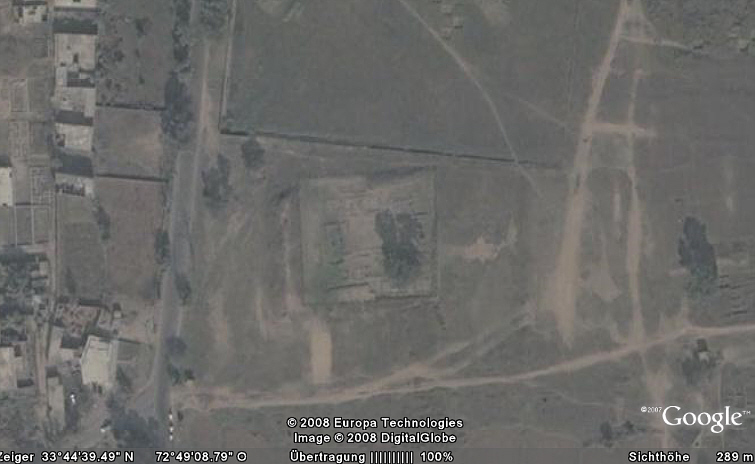
Abb.: Bhiṛ Mound
[Bildquelle: ©Google Earth. -- Zugriff am 2008-04-05]
John Marshall, der Ausgrabungsleiter, unterscheidet vier Schichten (strata):
Stratum I: oberste Schicht: 2. Jhdt v. Chr. oder später
Stratum II: ca. 3. Jhdt v. Chr. (Maurya-Zeit)
Stratum III: Ca. 4. Jhdt v. Chr., als Alexander der Große Taxila besuchte.
Stratum IV: 6. - 5. Jhdt v. Chr. Achaemeniden-Zeit
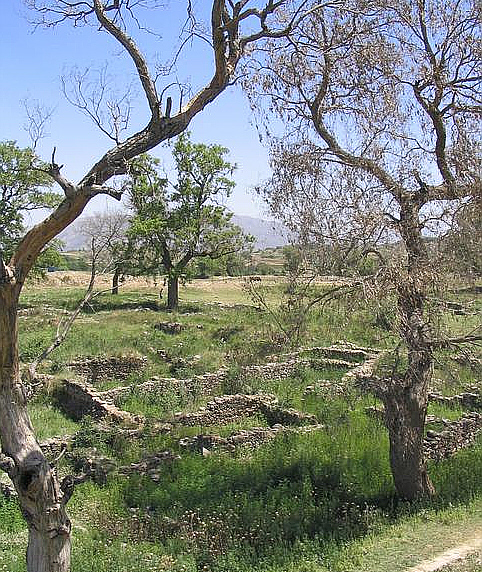
[Bildquelle: Livius. --
http://www.livius.org/a/pakistan/taxila/bhir.html. -- Zugriff am 2008-04-05.
-- "© Marco Prins and Jona Lendering. Photos can be downloaded and used for
non-commercial purposes, but you have to acknowledge Livius."]
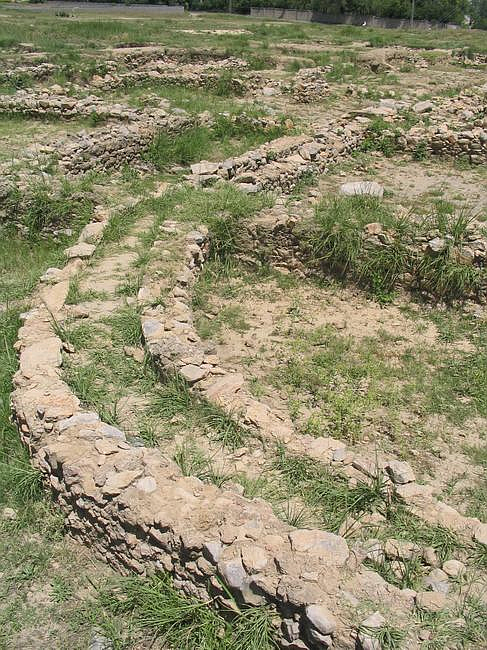
Abb.: Bhiṛ Mound
[Bildquelle: Livius. --
http://www.livius.org/a/pakistan/taxila/bhir.html. -- Zugriff am 2008-04-05.
-- "© Marco Prins and Jona Lendering. Photos can be downloaded and used for
non-commercial purposes, but you have to acknowledge Livius."]
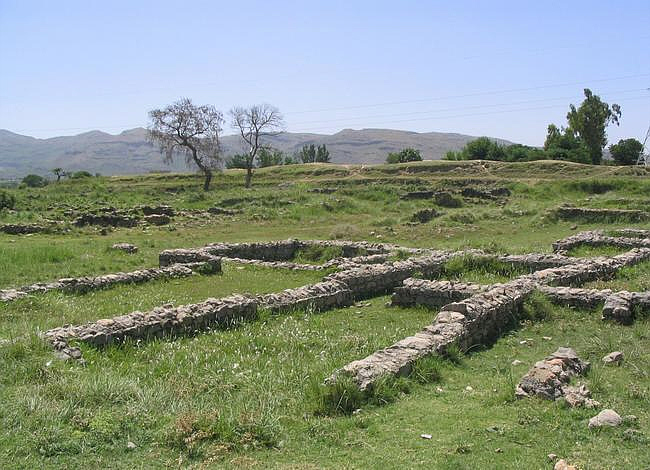
Abb.: Bhiṛ Mound
[Bildquelle: Livius. --
http://www.livius.org/a/pakistan/taxila/bhir.html. -- Zugriff am 2008-04-05.
-- "© Marco Prins and Jona Lendering. Photos can be downloaded and used for
non-commercial purposes, but you have to acknowledge Livius."]
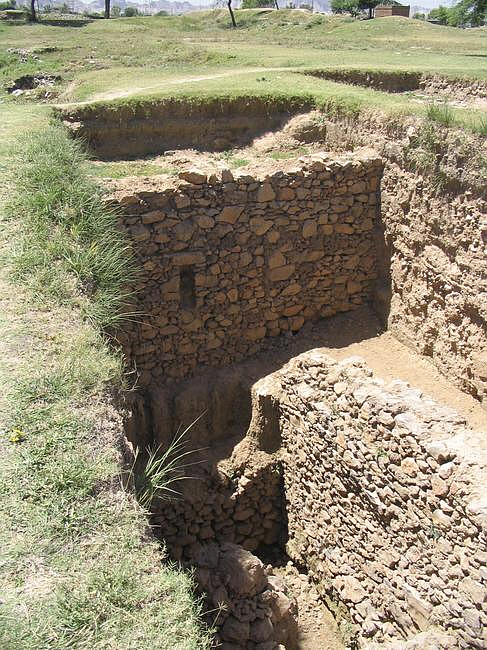
Abb.: Bhiṛ Mound
[Bildquelle: Livius. --
http://www.livius.org/a/pakistan/taxila/bhir.html. -- Zugriff am 2008-04-05.
-- "© Marco Prins and Jona Lendering. Photos can be downloaded and used for
non-commercial purposes, but you have to acknowledge Livius."]
Als Beispiel eines Ausgrabungsbefundes John Marshalls Befund von Stratum III:
"STRATUM III: c. FOURTH CENTURY B.C. During this century Alexander the Great invaded the North-West, and evidence of Greek influence is to be seen in some of the ceramic wares, coins, and other small antiquities.
Copper and bronze are very scarce, the only articles made of them being two or three antimony-rods, an ear-cleaner and toothpick combined ('Copper and Bronze', ch. 28, no. 217) and two finger-rings ('Finger-rings', ch. 31, nos. 25, 26). The copper used for these articles is unusually pure. ('Analysis Tables', p. 567, no. 2); the bronze, which is leadless and contains [S. 104] between 8 and 9 % only of tin, is of high quality, having the strength and elasticity of modern gunmetal (ibid. no. 9). As most of the bronze found in later strata at Taxila contains well over 20 % tin, it seems likely that this particular specimen from the third stratum may have been the result of Greek influence—an inference which receives corroboration from the fact that the only other object which shows a low percentage of tin (ibid. no. 16) is unquestionably Graeco-Roman.
Of gold and silver ornaments there is one small group, which was found along with the large hoard of coins described below and dates in all probability from the close of the fourth century b.c., when Maurya rule was already well established. The group comprises: an earring of gold resembling the Etruscan á baule type ('Jewellery', ch. 30, no. 52); a necklace of gadrooned and collared spherical beads with spacer circlets—the latter of pure, the former of impure gold (ibid. no. 54); a silver necklace of hemispherical drop pattern (ibid. no. 55); two bowl-shaped buttons or phulas of gold (ibid. nos. 199-200). To the same period also belongs a small triangular pendant made of double sheet gold (ibid. no. 87).
Iron objects include two adze heads, one of ordinary type, the other, which is somewhat later, with sharply tapering blade ('Iron', ch. 27, no. 112); a knife or chopper with slightly convex back (ibid. no. 123); and a scraper or chisel with traces of a wooden handle.
Among ceramic wares the most noteworthy are a few pieces of Hellenistic 'black' and 'embossed' wares, which made their appearance after the invasion of Alexander the Great. A specimen or two of the 'black' ware, which were no doubt strays, were found in the lowest settlement, others in the second settlement, and others in the Greek city in Sirkap ('Pottery', ch. 23, Class XXXII). The embossed ware from this stratum is represented by three fragmentary vessels only (ibid. nos. 234-6) with characteristically Hellenistic designs of vine and floral scrolls, running spirals, and the like. It seems probable that the local red-and-black ware should also be dated to this period, though a specimen of it was found, as already mentioned, at a lower depth (ibid. Class XXX). Some specimens of local plain grey ware, which is not uncommon at Taxila, were also found in this stratum (ibid. Class XXXIV), among them being a bowl and a cooking pot (haṇḍī), both with carinated sides. Objects of ordinary red ware included a small loṭā (ibid. no. 30), haṇḍī (ibid. no. 49), drinking-cup (ibid. no. 84), bowls (ibid. nos. 92, 96, 97), basin (ibid. no. 114), flesh-rubber (ibid. no. 166), miniature jar (ibid. no. 176), anthropoid vase (ibid. no. 184), stoppers surmounted by animals (ibid. nos. 200, 201), ring stand (ibid. no. 202), fragmentary sprinkler with four spouts, and a mould of a nine-petalled flower for embossing on clay.
Terra-cotta figurines, toys, etc., which were entirely absent from the fourth settlement, now make their appearance for the first time, but they are still very rare and for the most part seem to be strays from the second settlement. They comprise:
- A primitive-looking idol of the 'Nude Mother' or 'Earth goddess' type, which almost certainly came from a ritual tank and might date from any time up to the first century a.d. ('Terra-cottas', ch. 24, no. 1).
- The fragment of a votive plaque, showing a male and female deity side by side (ibid. no. 37). As votive plaques of this kind have been found in large numbers in the succeeding strata, there can be little doubt that this fragment is a stray,
- Two toy elephants (ibid. nos. 77, 80), of which the former is evidently of Maurya technique,
- A small number of ornamental medallions or bullae adorned with geometric devices, human masks or animals in the Hellenistic [S. 105] style (ibid. nos. 128, 131-3, 135, 137)
- A group of decorative beads of various shapes, the findspot of which, like that of the preceding group, suggests that they date from the close of this period (ibid. nos. 138, 140, 142-5 and 'Beads', ch. 37, pp. 742-3).
Stone is represented by:
- a stool-quern of plain Mathurā sandstone ('Stone Objects', ch. 25, no. 13);
- four mullers (ibid. nos. 20-3); a cup-shaped mortar (ibid. no. 32);
- the fragment of a carved 'ring-stone' amulet (ibid. no. 131);
- a scraper of grey slate such as leather-workers used;
- and the fragment of a slate mould for making beads.
The stool-quern from Mathurā and the carved ring-stone are not likely to have found their way to Taxila until after the Maurya conquest. One of the mullers, which is made of Chunar sandstone, probably dates from the autonomous period after the break-up of the Maurya empire; it is doubtless a stray from the top stratum (cf. 'Stone Objects', ch. 25, Class IV).
Bone and ivory objects from this stratum comprise:
- two dagger-shaped amulets ('Bone and Ivory Objects', ch. 32, nos. 13, 14), the former of bone, the latter of ivory;
- a hair-pin and antimony-rod of ivory (ibid. nos. 25, 35);
- a bone stilus (ibid. no. 69);
- a spindle-whorl (ibid. no. 82);
- three draughtsmen or counters, two of ivory (ibid. nos. 87, 90) and one of bone (ibid. no. 91)—the last with nandipada and swastika symbols incised upon it, perhaps for luck;
- and a bone arrow-head (ibid. no. 108).
Of seals there are four, namely:
- a scaraboid of indurated clay engraved with the clumsy figure of a winged stag ('Seals', ch. 34, no. 8);
- two pyramidal seals of slate (ibid. nos. 2, 3), the former engraved with three swords set up in front of a standing figure, the latter with the figure of a man;
- and a pyramidal seal of beryl-like glass bearing on its base six nandipada symbols (ibid. no. 4).
Scaraboid and pyramidal seals are found exclusively in the second and third strata of the Bhir Mound. I suspect that the pyramidal seals, like the plain pyramidal pendants, are all of Maurya date.
Ornamental beads have become more fashionable. Of 587 specimens,
- 232 are made of semi-precious and
- five of common stones,
- 217 of glass,
- fifty-one of shell,
- forty-nine of terracotta,
- twenty-five of bone,
- seven of copper
- and one of iron.
The favourite stones, as in all other periods, are carnelian with 143 specimens (four of which are etched) and agate with sixty-three. The specimens of other kinds of stone can be counted on one hand. Amethyst, beryl, garnet, malachite and onyx all make their first appearance during this period, but are very rare; and so, too, is glazed quartz, which is represented by one specimen only—doubtless an import from abroad. Glass beads come much more into vogue, the commonest colours being blue with 135 specimens and green with thirteen. New but rare colours are cobalt, opaque orange and yellow, red and turquoise. On the other hand, no example of amber, grey or opal white, which occurred in the previous stratum, has been found in the third.
In the shapes of the beads there is little difference, the favourites being still the spherical (229) and barrel (79), followed by the bicone, disk, oblate and cylinder. It is noticeable, however, that angular and faceted beads are now becoming more popular, and that there are many more pendent amulets of various designs, namely: dagger, axe, double-axe, nandipada and crescent-edged wheel. The beads from this stratum also include 132 minute specimens.
There remain the coins, which include one of the most valuable hoards of silver punch-marked and other coins that have come to light anywhere in India. This hoard was found in square 32.26', near the eastern limit of the main excavated area. It was hidden in a small earthenware ghaṛā, which contained 1,167 silver coins besides the several pieces of gold and silver jewellery described above. The coins—all silver—are mainly punch-marked kārshāpaṇas. They comprise thirty-three of the long-bar variety, seventy-nine minute circular pieces weighing no more than from 2.3 to 2.86 grains, and 1,051 of the more elaborate type of punch-marked coins illustrated in Pl. 234, nos. 24-48, which appear to have been minted outside the North-Western [S. 106] area. But, in addition to all these punch-marked pieces, the hoard also included a much-worn silver siglos of the Persian Empire and three Greek coins fresh from the mint, viz. two of Alexander the Great and one of Philip Aridaeus, who died in 317 b.c. (R.U.C. ch. 39, nos. 1-4). The presence of these coins and the position of the ghaṛā both point to the close of this period, i.e. round about 300 b.c., as the date when this treasure was buried. A detailed description of this hoard has been published by Mr E. H. C. Walsh in Memoir No. 59 of the Archaeological Department, and a summary of his conclusions is given below in chapter 38, where some further remarks on it are also made by the writer. The gold and silver ornaments which accompanied the coins are described in the chapter on 'Jewellery', (ch. 30, nos. 52, 54. 55, 199-200).
Apart from this hoard, the third stratum yielded nine punch-marked coins of the earliest type, viz. two oblong bars (one silver and one copper) and seven 'round and concave' (four silver and three copper). It also yielded ten Local Taxilan coins of five different types, but there are good reasons, as I explain in chapter 38, for believing that these local Taxilan pieces belong to the second stratum."
[Quelle: Marshall, John <1876 - 1958>: Taxila : an illustrated account of archaeological excavations carried out at Taxila under the orders of the Government of India between the years 1913 and 1934. -- Cambridge : Univ. Pr., 1951. -- 3 vols. -- Vol. 1: Structural remains. -- 1951. -- XIX, 397 S. -- 29 cm. -- S. 103 - 106.]
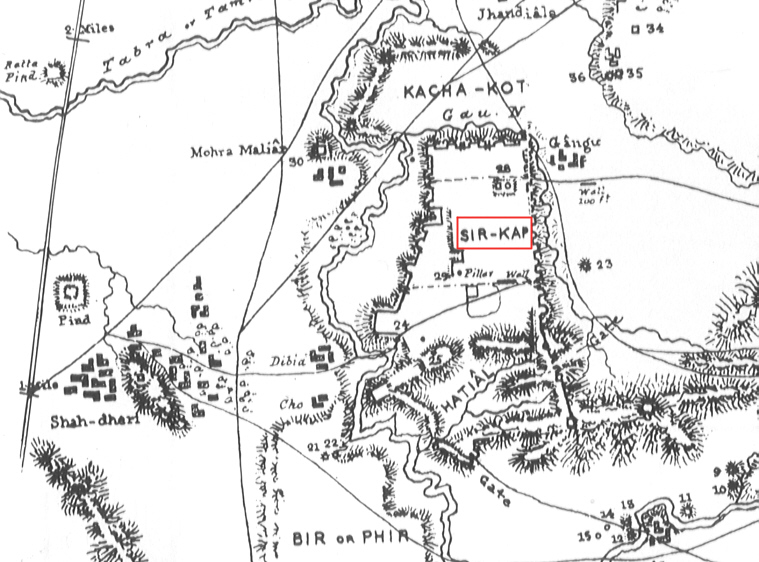
Abb.: Lage von Sirkap
[Bildquelle: Alexander Cunninghams Plan von Taxila <Ausschnitt> in Archaeological survey of India.
Report. -- 2 (1871). -- vor S. 111.]
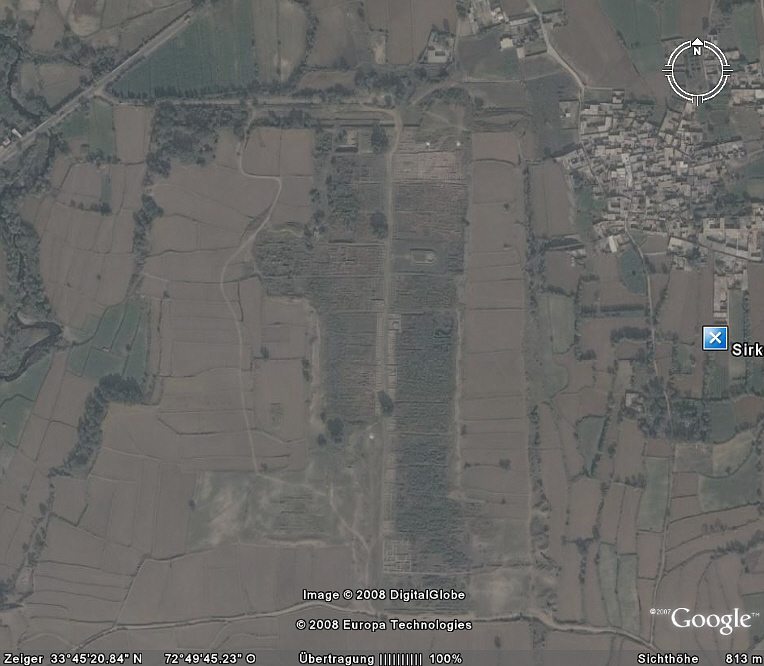
Abb.: Sirkap
[Bildquelle: ©Google Earth. -- Zugriff am 2008-04-04]
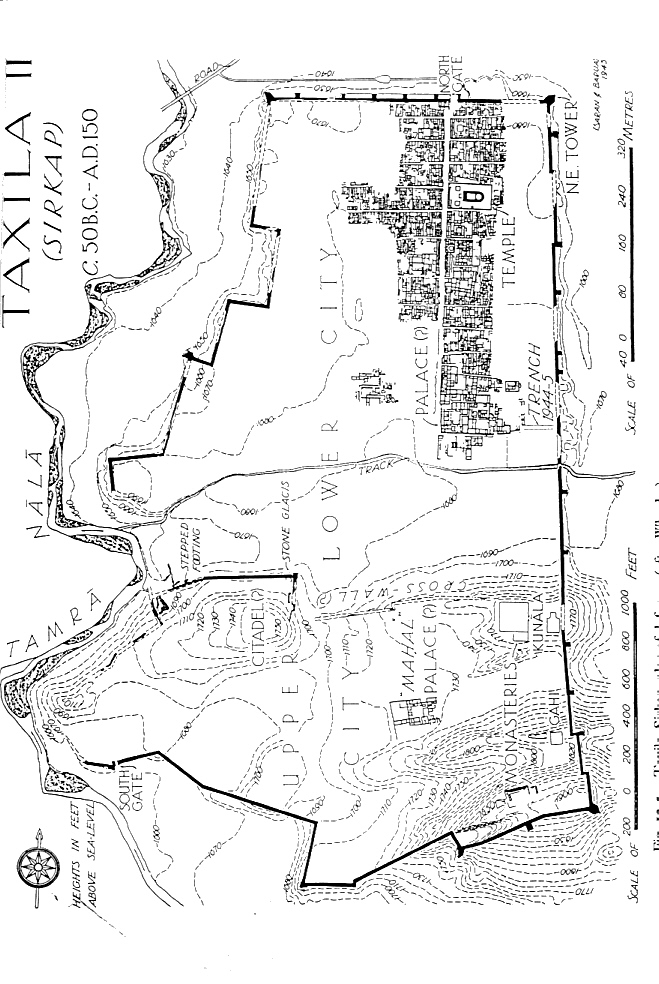
Abb.: Plan von Sirkap nach den Ausgrabungen 1944/45
[Bildquelle: Wheeler, Robert Eric Mortimer <1890 - 1976>. -- In: Ancient India. -- 4 (1947/48). -- vor S. 84. -- Fair use.].
Zu Beginn des 2. Jahrhunderts v. Chr. wurde die Kernstadt von Taxila von Bhiṛ Mound nach Sirkap auf der anderen Seite des Flusses Tamrā-nālā verlegt. Sirkap war Taxila unter Griechen, Śaka, Parthern und Kuṣāṇa bis zur Zeit von V'ima Kadphises (nach 90 n. Chr.). Dann wurde die Kernstadt von Taxila auf die andere Seite des Flusses Luṇḍi-nālā nach Sirsukh verlegt.
Sirkap war mit einem Steinwall (Stadtmauer). Dieser Steinwall war ca. 5,5 km lang, 4,5 bis 6,5 m dick und vermutlich 6 bis 9 m hoch.
Über die Ausgrabungsmethode John Marshalls in Sirkap schreibt sein Nachfolger, Mortimer Wheeler:
"Der Abschluss dieser Arbeiten - die Untersuchung der Verteidigungsbauten und die zentrale Flächenausgrabung - hat uns vermutlich einen guten Überblick über den Ort gegeben. Über Einzelheiten des nächsten Stadiums lässt sich weniger im voraus sagen, wenn auch das allgemeine Ziel klar genug ist: nämlich, einen repräsentativen Teil des Stadtgeländes in verschiedenen Perioden oder wenigstens in der obersten Periode freizulegen und den Charakter und die Einrichtung der verschiedenartigen Bauwerke zuverlässig festzustellen. Der beste Weg wird möglicherweise der sein, die ursprüngliche Flächengrabung auf der Höhe einer bestimmten Schicht auszuweiten, sie mit dem ausgegrabenen Tor zu verbinden und die dazwischenliegenden Gebäude- und Straßenanlagen der ausgewählten Schicht oder Schichten freizulegen. Dabei wird eine geordnete, zusammenhängende Entwicklung der Arbeit gewährleistet, und zukünftige Ausgräber können leicht überschauen, wo sie sich im Verhältnis dazu befinden. Das war ungefähr die Methode, die Sir John Marshall bei Taxila (Sirkap) im Pendschab mit den besten Erfolgen anwandte (Abb. 12a). Wie weit eine solche Arbeit dann in die Tiefe geführt werden kann oder sollte, hängt von den erreichbaren Funden ab und von dem jeweiligen Stand des Wissens. Wenn ich auch Marshalls Methode der Ausgrabung und der Aufnahme nicht übernehmen würde, so bin ich doch der Meinung, dass er völlig recht hatte, als er in der von ihm bearbeiteten Fläche nur die beiden obersten Schichten von Sirkap freilegte und sie so liegen ließ. Er hatte es mit einer Kultur und einem Staatswesen zu tun, die gänzlich unbekannt waren. Bei einem römisch-britischen Ort dagegen würde ich heute die völlige Freilegung des verfügbaren Gebiets in die Tiefe empfehlen, sogar auf Kosten einer ausgedehnten Zerstörung. Wie so oft, kann keine allgemeine Regel aufgestellt werden; jeder Fall muss auf seine Vorzüge hin geprüft werden." [Quelle: Wheeler, Robert Eric Mortimer <1890 - 1976>: Moderne Archäologie : Methoden u. Technik d. Ausgrabung / Sir Mortimer Wheeler. -- Reinbek b. Hamburg : Rowohlt, 1960. -- 244 S. : Ill. ; 19 cm. -- (rowohlts deutsche enzyklopädie ; 111/112). -- Originaltitel: Archaeology from the earth (1954). -- S. 98.]
"Und da wir gerade in Pakistan angelangt sind, wollen wir noch ein bekannteres Beispiel aus diesem Land aufgreifen. Tausend Jahre lang stand die Stadt von Taxila auf in die Höhe wachsendem Grund im nördlichen Pendschab, und eine dieser Siedlungen, aus den ersten Jahrhunderten vor und nach Christi Geburt, wurde weitgehend durch Sir John Marshall freigelegt, so dass zuletzt ein beachtlicher Teil eines bemerkenswerten rechtwinkligen Stadtplanes erschien (Abb. 12a). Die Freilegung stimmte nicht mit den modernen technischen Ansprüchen überein, und tatsächlich zeigt sich in dem veröffentlichten Plan mehr als eine Phase ohne Unterscheidung von der anderen. Dennoch bleibt der außergewöhnliche Reiz des parthischen Taxila, der allgemeine Charakter seiner Bauten und ihre Beziehung zu einem Straßennetz, meines Wissens beispiellos in diesem Teil Asiens. Hätte der Ausgräber sich bei dieser tiefgeschichteten Siedlung auf die vertikale Grabung konzentriert, er hätte uns wertvolle Auskünfte geben können, auf die wir heute noch warten, aber er hätte uns kaum auch das Bild vermitteln können, das wir ihm verdanken, das einer wimmelnden Stadt mit ihren Straßen und Tempeln, ihren Palästen und Geschäften. Er würde uns einen nützlichen Katalog gegeben haben, aber nicht, wie jetzt, ein lebendiges Kapitel Sozialgeschichte. Die vier hier behandelten Beispiele einer horizontalen Grabung — Silchester [S. 140], Glastonbury, Mohendscho-Daro und Taxila (Sirkap) — sind nicht sehr glücklich gewählt insofern, als keine dieser Siedlungen mit angemessener Könnerschaft ausgegraben wurde. Technisch gehören sie alle zur vor-Pitt-Rivers-Ära, obwohl in Wirklichkeit Pitt Rivers seine Methoden erprobt hatte, bevor eine von ihnen begann. Selbstverständlich darf man daraus nun nicht schließen, dass horizontale Grabungen notwendigerweise oberflächlich und unwissenschaftlich sind. Im Idealfall würde die Ausgrabung einer Stadtanlage mit einer vertikalen Grabung beginnen, tief genug, um die Zeit- oder Kulturfolge festzustellen, und würde dann übergehen zu der sorgfältigen horizontalen Ausgrabung der aufeinanderfolgenden Phasen, immer eine zur Zeit. Offensichtlich kann das Verfahren nicht umgedreht werden, und an den drei erwähnten Orten kann nur die sorgfältige vertikale Grabung der noch nicht berührten Gebiete wenigstens zum Teil die verschwendeten Beweismittel ersetzen. Ein besseres Beispiel einer horizontalen Grabung im kleinen Maßstab liefert Little Woodbury bei Salisbury, wo Gerhard Bersu den größeren Teil eines eisenzeitlichen Gehöfts freilegte und in der Lage war, sowohl die Architektur wie auch die Einrichtung zu rekonstruieren. Der Ort lag an der Oberfläche, und das technische Problem war unvergleichbar einfacher als an einem tief abgelagerten Stadtplatz; nichtsdestoweniger ist es lehrreich, darüber nachzudenken, wie wenig von der wirklichen Bedeutung Little Woodburys durch eine rein vertikale Sondage hätte entdeckt werden können."
[Quelle: Wheeler, Robert Eric Mortimer <1890 - 1976>: Moderne Archäologie : Methoden u. Technik d. Ausgrabung / Sir Mortimer Wheeler. -- Reinbek b. Hamburg : Rowohlt, 1960. -- 244 S. : Ill. ; 19 cm. -- (rowohlts deutsche enzyklopädie ; 111/112). -- Originaltitel: Archaeology from the earth (1954). -- S. 139f.]
In Sirkap wurde aus dem genannten Grund vor allem die śaka-parthische Schicht Stratum II horizontal voll freigelegt. Aufgrund von Sondierungsgrabungen unterscheidet John Marshall sieben Schichten (strata):
Stratum I (oberste Schicht): Kuṣāṇa (ab ca. 60 n. Chr.)
Stratum II und III: späte Śaka und Parthisch
Stratum IV: frühe Śaka (um 30 v. Chr. wurden viele Gebäude durch dein Erdbeben zerstört)
Stratum V und VI: Griechisch (ca. 190 - 90 v. Chr.)
Stratum VII: Vorgriechisch
John Marshall versucht, uns die śaka-parthische Stadt (Stratum II) lebendig aufgrund der Ausgrabungsbefunde vor Augen zu bringen:
"general view of Śaka-parthian city At first sight, their plan may appear bewilderingly complex, but it will be simplified if we start by taking a general view of the buildings as they appeared in the first century a.d. Let us imagine, therefore, that we have just entered the city by the North Gate and are looking down the long straight Main Street. The date is a.d. 40 or thereabouts, that is, about the time when Apollonius of Tyana is said to have visited Taxila, and when Gondophares, the Parthian, was ruling there. A decade has gone by since the great earthquake, and in the interval the city has been rebuilt, and its buildings are still looking new and more than usually spick and span. Most of them are plastered and whitewashed, but not a few are colour-washed, or partly colour-washed in yellows, blues, reds and greens, as buildings may still be seen in many a modern city of the Near and Middle East. Down either side of the Main Street runs a row of shops. They are small, single-story structures of one or two rooms, raised on a high plinth above the roadway and often with a shallow veranda or open platform in front. The rows of these shops are not continuous. At short intervals, their shadows are broken by streaks of sunlight from the narrow side-streets which cut from east to west across the city; and here and there, too, between the shops can be seen sacred temples and shrines overlooking [S. 68] the main thoroughfare; for the people of Taxila are a devout people, and the monuments of their faiths are as conspicuous a feature inside the city walls as they are in the country roundabout. One of these sacred memorials is on our immediate left. It is a stūpa of the Jains (?) standing in the middle of a spacious court between Second and Third Streets, but all we see of the stūpa is its dome and crowning spire of umbrellas rising above the surrounding wall. Then, a couple of blocks farther on, but not more than 80 yards [75 m] away, is an imposing temple of the Buddhists—the biggest of its kind at Taxila—set well back from the road in another great court; and in front of it the spires of two more stūpas, which stand in the same court to right and left of its entrance. Opposite to this temple (at the corner of Block C) is still another stūpa, while three others are visible rising above the shops farther up the street, two on the left (in Blocks F and G) and one on the right (in Block E'), their graceful domes and spires making a pleasing contrast with the flat roofs around them. Beyond them, in the distance, the royal palace stands out, white and gleaming, against the rugged hills to the south.
At the back of the shops and shrines, and reached usually through entrances in the narrow side-streets, are the private dwelling-houses of the citizens. A few right under the city wall are poor, mean habitations, occupied probably by the soldiers who manned the ramparts, but most of them are large houses belonging to the well-to-do; for this is the fashionable quarter of the city. The royal palace itself is only 500 yards [450 m] up the street and the people who live between it and the North Gate are of the governing classes, with attendants and slaves for whom accommodation is needed in their houses: people who can afford to wear costly jewellery on their persons and to use diverse articles of luxury imported from the Western world. Their houses are flat-roofed and low, like bungalows ; for since the great earthquake the old tall houses of Taxila have, for safety's sake, been cut down to two stories. They cover, however, a big area of ground—on an average, some 15,000 sq. ft. [1400 m²] —and contain a score or more of rooms on each floor. When we enter them we shall find that the rooms are grouped, as is usual in the east, about several open courts from which they derive their [S. 67] light and air, but the courts are sometimes no bigger than the rooms themselves and sometimes they take the form of mere wells or of passages between the rooms. Windows are provided in the outer walls of rooms overlooking the streets, but they are no more than narrow slits like those in the outer walls of monasteries.
Higher up the Main Street, as one gets near to the royal palace, the houses are rather more carefully planned and furnished with larger courts. Some of these, one may suppose, served as public offices, and in the interests of administrative convenience they would naturally be located in the vicinity of the palace. The royal palace itself (Block K) is like a glorified private house—planned, that is, on the same lines but on a bigger scale, and with more spacious courts and rooms. Its walls, too, are more massive and higher in proportion to their massiveness, so that one can see the palace from any part of the city rising well above the surrounding roofs. Since the royal palace was the most important of the buildings unearthed and stands, moreover, at the centre of the lower city, it will be a convenient starting-point for the visitor to make a closer inspection of the ruins."
[Quelle: Marshall, John <1876 - 1958>: A guide to Taxila / by Sir John Marshall. - 4. ed.. - Karachi : Sani Communications, 1983. - V, 195 S. : Ill. ; 23 cm. -- Cambridge : University Press, for the Dept. of Archaeology in Pakistan, 1960. -- S. 65 - 67.]
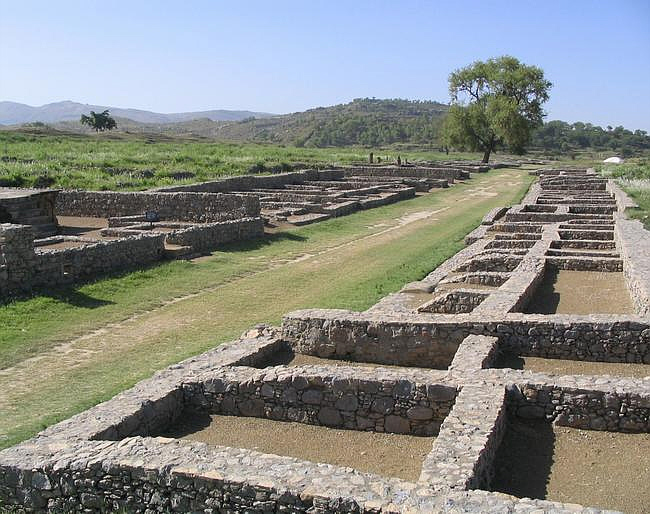
Abb.: Sirkap, Hauptstraße
[Bildquelle: Livius. --
http://www.livius.org/a/pakistan/taxila/sirkap.html. -- Zugriff am
2008-04-05. -- "© Marco Prins and Jona Lendering. Photos can be downloaded and
used for non-commercial purposes, but you have to acknowledge Livius."]
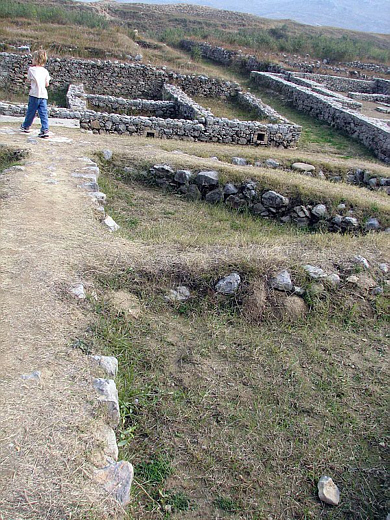
Abb.: Sirkap
[Bildquelle: Scott Christian. --
http://www.flickr.com/photos/askwhat/329012123/. -- Zugriff am 2008-03-20.
--
![]()
![]()
![]() Creative
Commons Lizenz (Namensnennung, keine kommerzielle Nutzung, keine Bearbeitung)]
Creative
Commons Lizenz (Namensnennung, keine kommerzielle Nutzung, keine Bearbeitung)]
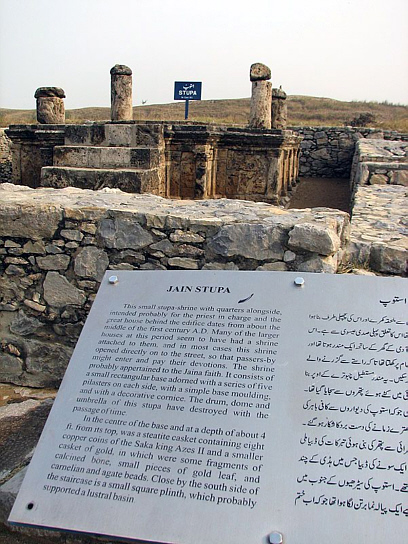
Abb.: Jaina Stūpa, Sirkap
[Bildquelle: Scott Christian. --
http://www.flickr.com/photos/askwhat/329011451/. -- Zugriff am 2008-03-20.
--
![]()
![]()
![]() Creative
Commons Lizenz (Namensnennung, keine kommerzielle Nutzung, keine Bearbeitung)]
Creative
Commons Lizenz (Namensnennung, keine kommerzielle Nutzung, keine Bearbeitung)]
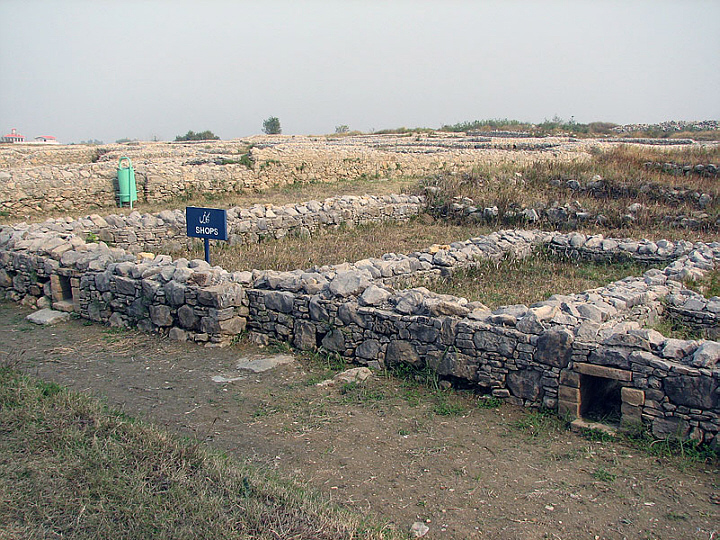
Abb.: Läden und Werkstätten, Sirkap
[Bildquelle: Scott Christian. --
http://www.flickr.com/photos/askwhat/329012282/. -- Zugriff am 2008-03-20.
--
![]()
![]()
![]() Creative
Commons Lizenz (Namensnennung, keine kommerzielle Nutzung, keine Bearbeitung)]
Creative
Commons Lizenz (Namensnennung, keine kommerzielle Nutzung, keine Bearbeitung)]
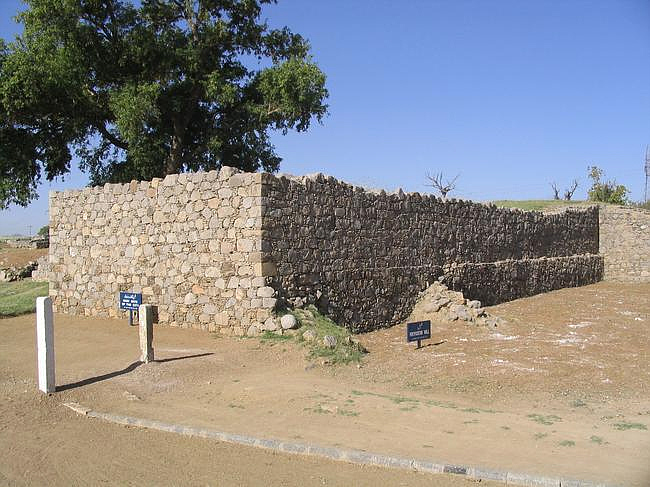
Abb.: Sirkap
[Bildquelle: Livius. --
http://www.livius.org/a/pakistan/taxila/sirkap.html. -- Zugriff am
2008-04-05. -- "© Marco Prins and Jona Lendering. Photos can be downloaded and
used for non-commercial purposes, but you have to acknowledge Livius."]
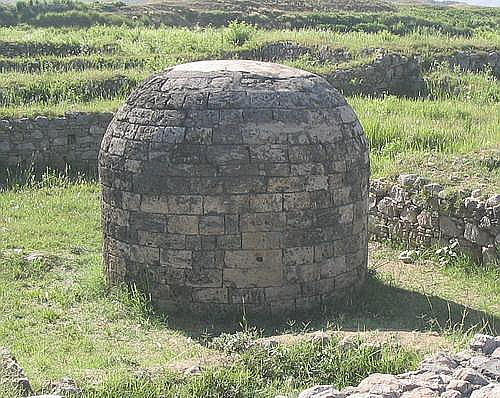
Abb.: Sirkap, Stūpa
[Bildquelle: Livius. --
http://www.livius.org/a/pakistan/taxila/sirkap2.html. -- Zugriff am
2008-04-05. -- "© Marco Prins and Jona Lendering. Photos can be downloaded and
used for non-commercial purposes, but you have to acknowledge Livius."]
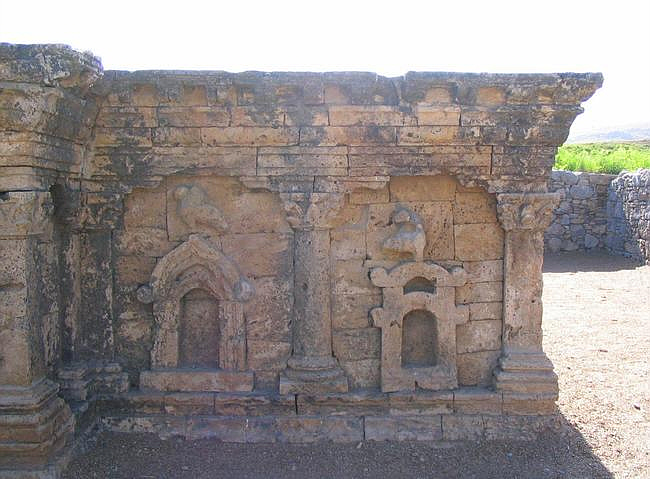
Abb.: Sirkap, Stūpa
[Bildquelle: Livius. --
http://www.livius.org/a/pakistan/taxila/sirkap2.html. -- Zugriff am
2008-04-05. -- "© Marco Prins and Jona Lendering. Photos can be downloaded and
used for non-commercial purposes, but you have to acknowledge Livius."]
Von den Kleinfunden in Sirkap seien genannt:
eine aramäische Inschrift im Shrine of
the Double-Headed Eagle, die angibt, dass die Säule zu Ehren eines hohen
Beamten namens Rōmēdōtē errichtet wurde zur Zeit als Priyadarśī (= Aśoka)
Taxila im Namen seines Vaters Bindusāra verwaltete.
eine Bronze-Statuette des
ägyptischen Gottes Harpocrates (![]() = ḥr.w-p3-ẖrd = Har-pa-khered/Heru-pa-khered)
(Horus, das Kind). Die Statue stammt vermutlich aus dem ägyptischen
Alexandria (Ἀλεξάνδρεια)
= ḥr.w-p3-ẖrd = Har-pa-khered/Heru-pa-khered)
(Horus, das Kind). Die Statue stammt vermutlich aus dem ägyptischen
Alexandria (Ἀλεξάνδρεια)
ein Topf, verschlossen, mit einem Deckel, mit einem Kopf von Dionysos (Διόνυσος) oder Silenos (Σιληνός) und einem Schatz von goldenen Armreifen, Ohrringen, Anhängern, Fingerringen, Perlen, einem Gold-Medaillon und einem Silberlöffel (der Schatz wurde um ca. 60 n. Chr. versteckt)
ein zerbrochener Speicherkrug mit
eine kleinen Goldfigur Aphrodites (Ἀφροδίτη) mit Eros (Ἔρως), einige
rundgeschliffene Hycinthe (Zirkone) und Granate, eine Goldhalskette, 21
einmalige Silbermünzen von Sapedana, Satavastra, Sasan und Kadphises I (Sapedana
und Satavastra waren bis zu diesem Fund nicht bekannt). Dieser Fund
stammt aus der Kuṣāṇa-Zeit.
im buddhistischen Gṛhya-stūpa (D): ein
Schatzversteck unter dem Boden eines kleinen Raumes an der Rückseite des
Komplexes: viele goldene Ohrringe, Ohrhänger, Armringe, Medaillen, ein
Halsreif (Torque) und ein Halsband, Silberfußreifen, Kannen, Kelche, Tassen,
Schüsseln, Platten und Untertassen
Im Stūpa (A): die Reliquien im
Reliquienschrein waren geplündert, enthielt aber noch Bruchstücke eines
Kristallkästchens, das vermutlich einst ein Reliquienbehälter war, zerbrach
und dessen Reste, die wegen der Berührung mir den Reliquien als heilig
galten, im Reliquienschrein aufbewahrt wurden.
Im Mahal: ein Versteck mit mehr als 60 Metallgefässen sowie andere Gegenstände.
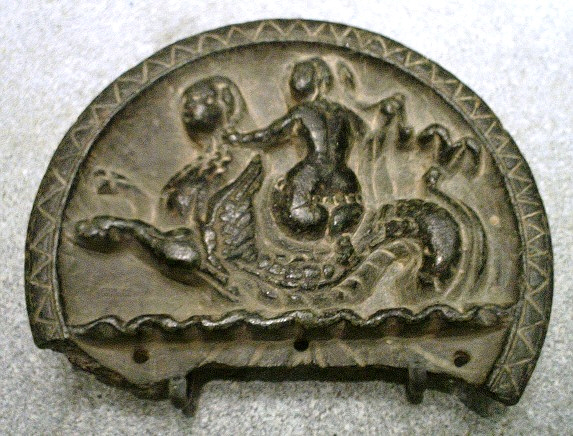
Abb.: Stein-Plakette: Nereide reitet auf Keto, Sirkap, 2. Jhdt. v. Chr.
[Bildquelle. Wikipedia, Public domain]
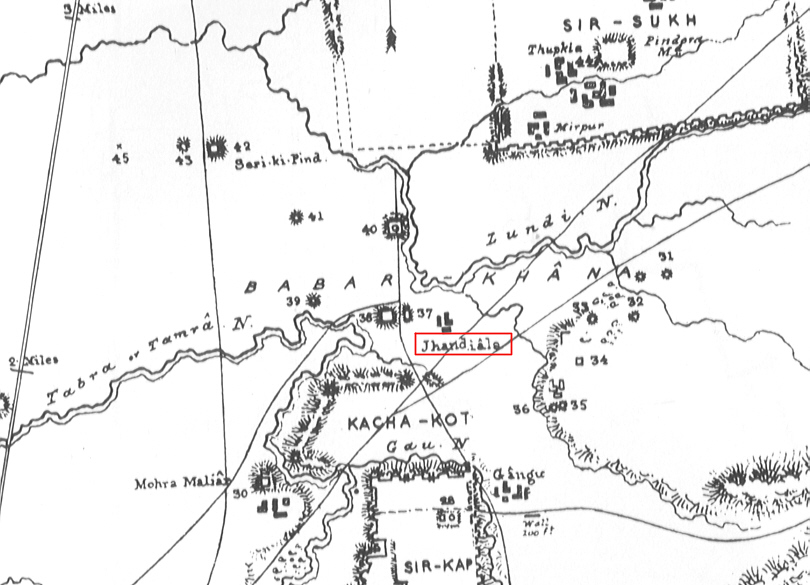
Abb.: Lage von Jaṇḍiāl
[Bildquelle: Alexander Cunninghams Plan von Taxila <Ausschnitt> in Archaeological survey of India.
Report. -- 2 (1871). -- vor S. 111.]
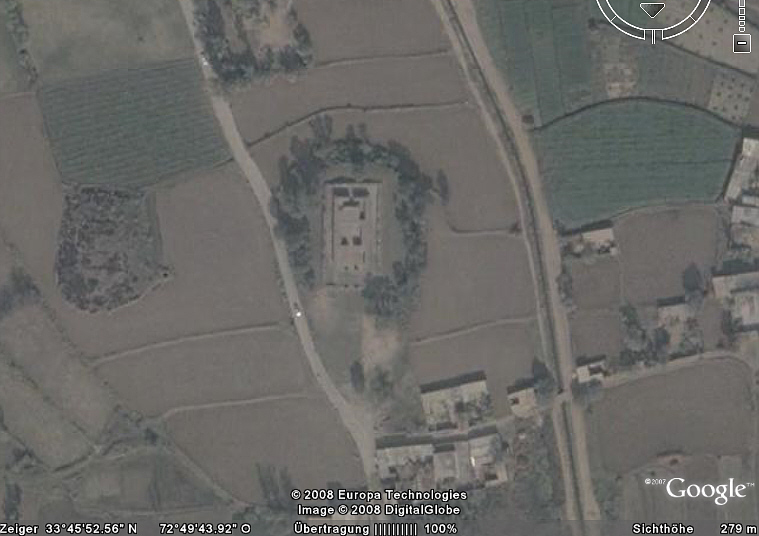
Abb.: Jaṇḍiāl
[Bildquelle: ©Google Earth. -- Zugriff am 2008-04-05]
Der Tempel von Jaṇḍiāl ist unter allen Tempeln Indiens und Pakistans einmalig, hat aber frappierende Ähnlichkeiten mit griechischen Tempeln. Als religiöse Affiliation wird zoroastrisch/zarathustrisch vorgeschlagen. Über die Religion der baktrischen Griechen ist allerdings wenig bekannt. Die Reliquienkammer soll viele Jahre vor der Ausgrabung durch einen Dorfbewohner namens Nur geöffnet worden sein. Die Reliquien wurden nicht mehr aufgefunden.
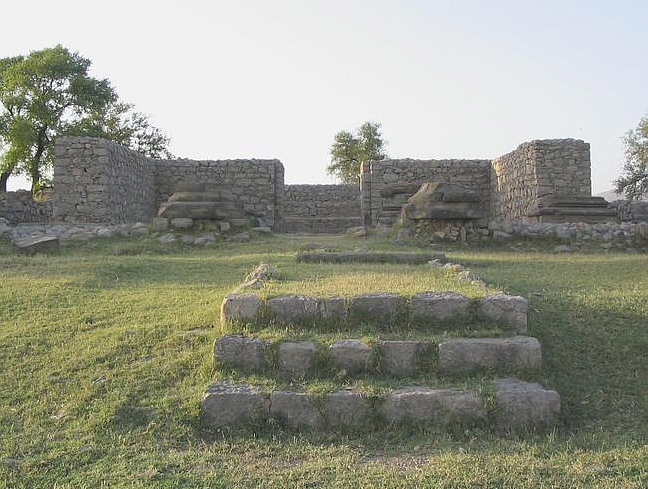
Abb.: Jaṇḍiāl
[Bildquelle: Livius. --
http://www.livius.org/a/pakistan/taxila/jandial.html. -- Zugriff am
2008-04-05. -- "© Marco Prins and Jona Lendering. Photos can be downloaded and
used for non-commercial purposes, but you have to acknowledge Livius."]
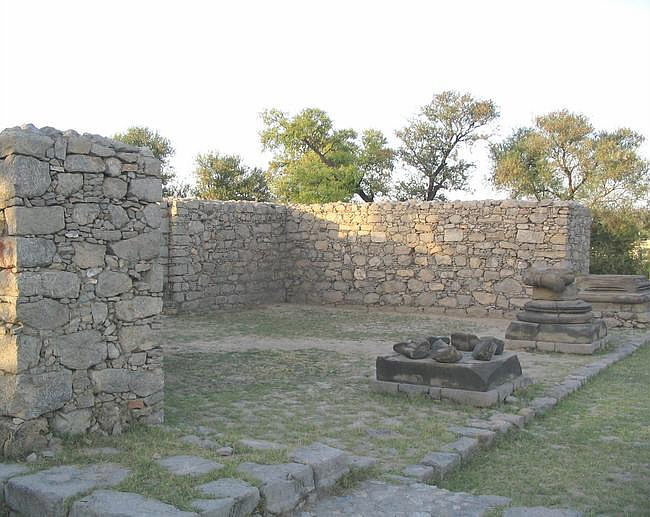
Abb.: Jaṇḍiāl
[Bildquelle: Livius. --
http://www.livius.org/a/pakistan/taxila/jandial.html. -- Zugriff am
2008-04-05. -- "© Marco Prins and Jona Lendering. Photos can be downloaded and
used for non-commercial purposes, but you have to acknowledge Livius."]
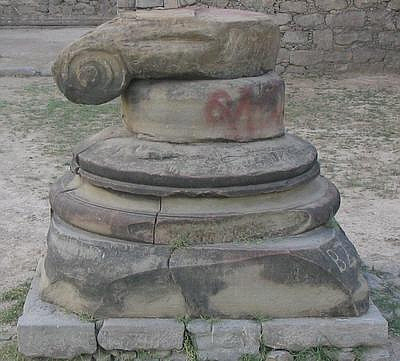
Abb.: Jaṇḍiāl
[Bildquelle: Livius. --
http://www.livius.org/a/pakistan/taxila/jandial.html. -- Zugriff am
2008-04-05. -- "© Marco Prins and Jona Lendering. Photos can be downloaded and
used for non-commercial purposes, but you have to acknowledge Livius."]
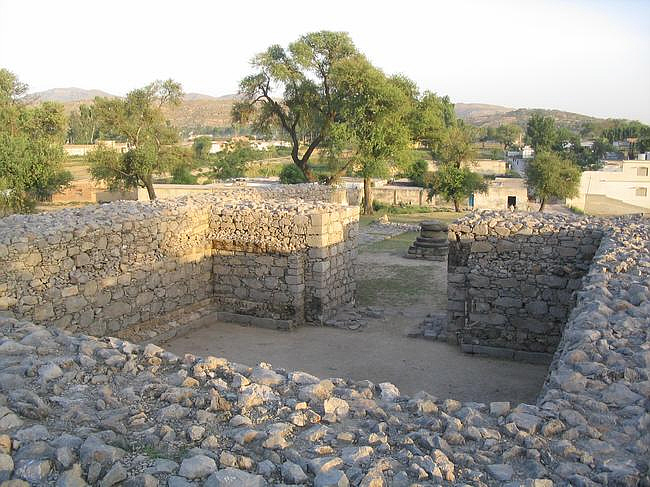
Abb.: Jaṇḍiāl
[Bildquelle: Livius. --
http://www.livius.org/a/pakistan/taxila/jandial.html. -- Zugriff am
2008-04-05. -- "© Marco Prins and Jona Lendering. Photos can be downloaded and
used for non-commercial purposes, but you have to acknowledge Livius."]
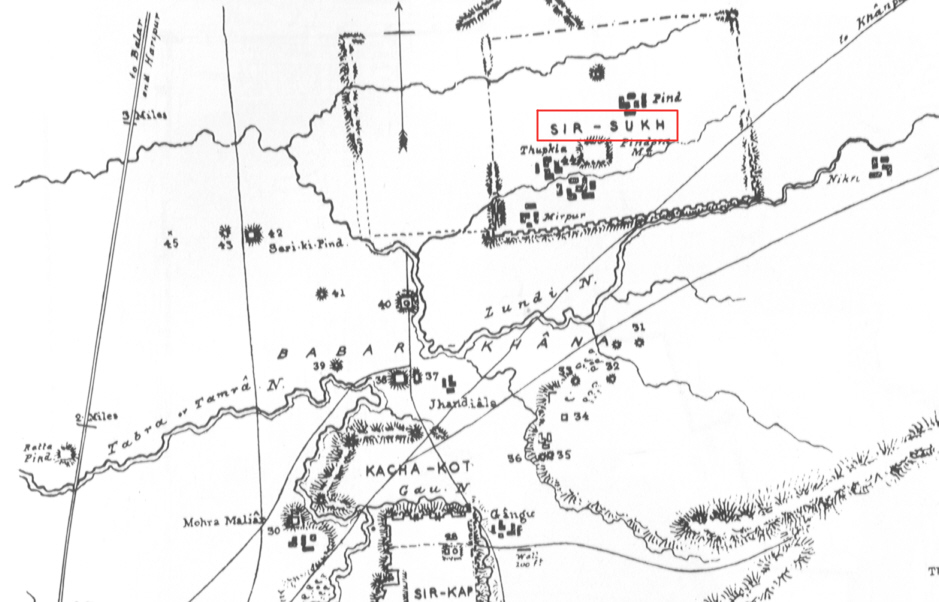
Abb.: Lage von Sirsukh
[Bildquelle: Alexander Cunninghams Plan von Taxila <Ausschnitt> in Archaeological survey of India.
Report. -- 2 (1871). -- vor S. 111.]
Zur Zeit von V'ima Kadphises (ca. 80/90 n. Chr.) wurde die Kernstadt von Taxila von Sirkap nach Sirsukh verlegt. Sirsukh bildet ein leicht unregelmäßiges Rechteck von ca. 1,4 x 1 km. Sirsukh kann nur unvollkommen und unter Schwierigkeiten ausgegraben werden, da
das meiste Gebiet tief liegt und sehr gut bewässert ist, sodass die Überreste von tiefen Ablagerungen bedeckt ist
da sich auf den wenigen Hügel muslimische Grabschreine (ziārat) oder Dörfer befinden. Muslimische Grabschreine sind für Grabungen absolut tabu, Dörfler wollen wegen der Suche nach altem Gerümpel verständlicherweise nicht gerne ihre Heimat verlassen. Außerdem wären solche Umsiedlungen sehr kostspielig
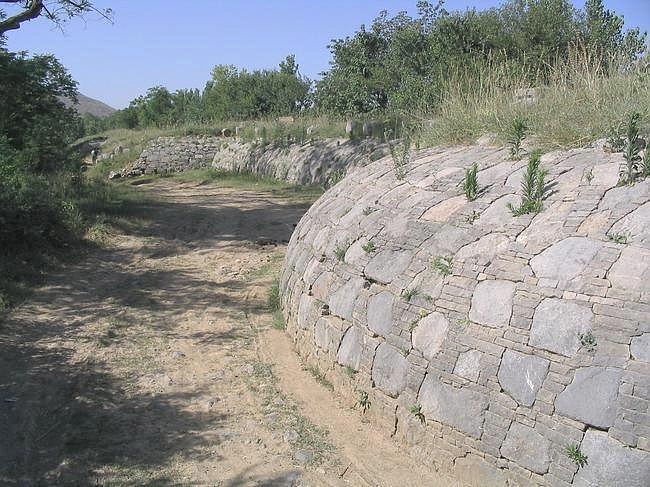
Abb.: Sirsukh
[Bildquelle: Livius. --
http://www.livius.org/a/pakistan/taxila/sirsukh.html. -- Zugriff am
2008-04-05. -- "© Marco Prins and Jona Lendering. Photos can be downloaded and
used for non-commercial purposes, but you have to acknowledge Livius."]
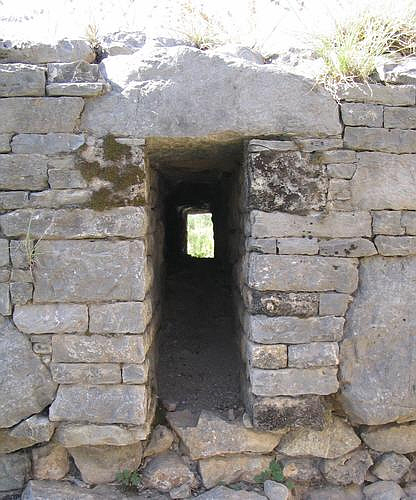
Abb.: Sirsukh
[Bildquelle: Livius. --
http://www.livius.org/a/pakistan/taxila/sirsukh.html. -- Zugriff am
2008-04-05. -- "© Marco Prins and Jona Lendering. Photos can be downloaded and
used for non-commercial purposes, but you have to acknowledge Livius."]
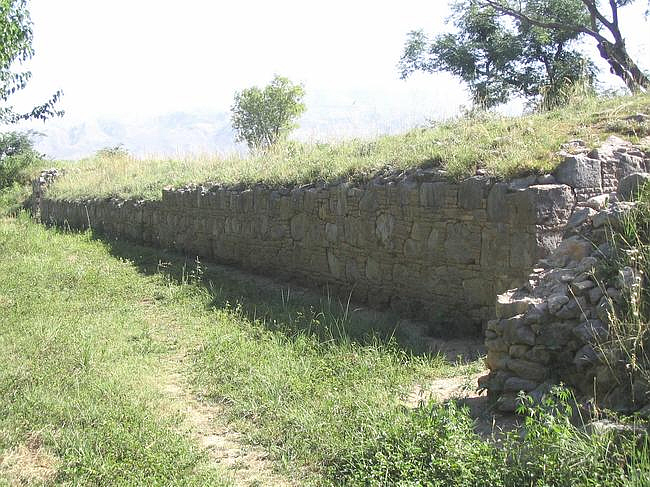
Abb.: Sirsukh, Wall
[Bildquelle: Livius. --
http://www.livius.org/a/pakistan/taxila/sirsukh.html. -- Zugriff am
2008-04-05. -- "© Marco Prins and Jona Lendering. Photos can be downloaded and
used for non-commercial purposes, but you have to acknowledge Livius."]
Sir John Marshall beschreibt sehr anschaulich die große Zahl der buddhistischen Klöster und Stūpas in der Umgebung von Taxila:
"LOCATION OF MONASTERIES Of monasteries located outside the city walls there were literally scores upon scores. Their remains may be traced on every hand, as one traverses the valleys or scales the hills. Many of them occupy the low flat-topped knolls which flood erosion has left standing in the bed of the valleys north and south of the Hathiāl spur; others [S. 97] are perched on terraces jutting out from the shady hillsides; others, again, can be seen crowning the crests of the hills or nestling in the cool glens between them. Wherever, indeed, a suitable site offers itself—and by 'suitable' is meant one within walking distance of the city and one that is either sheltered from the sun or cooled by the breezes—there, in nine cases out of ten, will be found the remains of a Buddhist monastery."
[Quelle: Marshall, John <1876 - 1958>: A guide to Taxila / by Sir John Marshall. - 4. ed.. - Karachi : Sani Communications, 1983. - V, 195 S. : Ill. ; 23 cm. -- Cambridge : University Press, for the Dept. of Archaeology in Pakistan, 1960. -- S. 96f.]
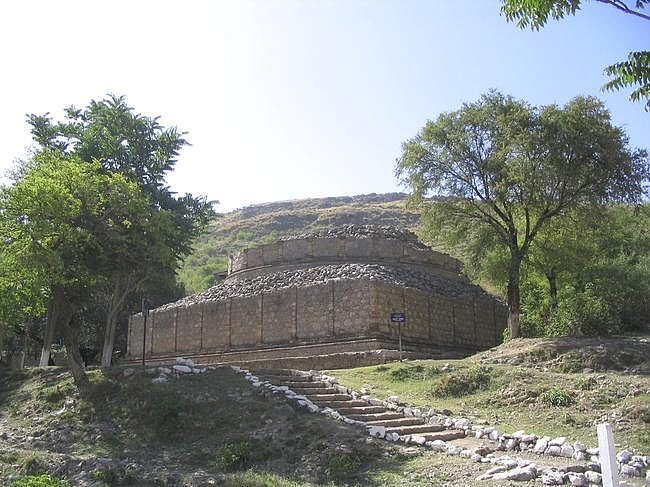
Abb.: Stūpa bei Mohṛa Morādu
[Bildquelle: Livius. --
http://www.livius.org/a/pakistan/taxila/mohra_moradu.html. -- Zugriff am
2008-04-05. -- "© Marco Prins and Jona Lendering. Photos can be downloaded and
used for non-commercial purposes, but you have to acknowledge Livius."]
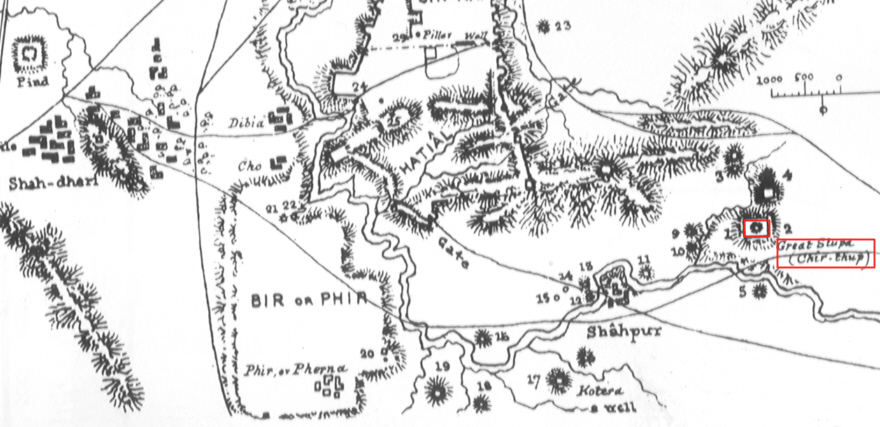
Abb.: Lage des Dharmarājikā-Stūpa
[Bildquelle: Alexander Cunninghams Plan von Taxila <Ausschnitt> in Archaeological survey of India.
Report. -- 2 (1871). -- vor S. 111.]
Der Dharmarājika-Stūpa geht vermutlich auf Aśoka zurück. Er misst ca. 46 x 45 m im Grundriss, die gegenwärtige Höhe der Ruine ist ca. 14 m.
Bemerkenswerte Kleinfunde sind:
Verstecke von 355, 285 bzw. 305 Münzen. Sie geben einen Eindruck vom (persönlichen?) Reichtum der dortigen Mönche.
in der Reliwuienkammer von Stūpa B6: ein Reliquienbehälter mit einigen Knochen und Asche. In diesem Stūpa wurden auch Perlen und Edelsteine folgender Materialien gefunden: Amethyst, Beryll, Karneol, Granat, grüner jaspis, Lapislazuli, Bergkristall, gelber Quarz, glazed quartz, Pyrit, Korallen, Perlen, Schnecken/Muscheln, Glas. Die Perlen haben teilweise die Form von Tieren, dem Viertelmond bzw. Symbolen der drei buddistischen Juwelen (Buddha, dharma, saṅgha).
in Chapel S3 wurde eine große Anzahl von Lehmsiegeln gefunden, in die eingedruckt wurde die buddhistische "Glaubensformel": "Ye dharmā hetuprabhāvā hetuṃ teṣāṃ tathāgataḥ hy avadat teṣāṃ ca yo nirodha evaṃvādī mahāśramaṇaḥ "Von jeglicher Wirklichkeit, die durch eine Ursache entstehen, hat der Wahrheitsfinder (Buddha) die Ursache genannt und der große Asket nennt auch deren Verhinderung (Vergehen).". Die Schriftzeichen entsprechen der Gupta-Zeit
In Chapel G5: ein vasenartiger Behälter aus grauem Glimemrschiefer mit einer Silbervase im darinnen. In der Silbervase war eine Silberrolle mit Inschrift und ein Goldkästchen mit einigen winzigen Knochenreliquien. Die Inschrift ist datiert auf das Jahr 136 des Azes (ca. 78 n. Chr.) und lautet:
| Sa 100.20.10.4.1.1. Ayasa
Aṣaḍasa masasa divase 10.4.1., iśa diva(se pradi)stavita Bhagavato
dhatu(o) Ura(sa)—kena (Iṃ)tavhria-putrana Bahaliena Noachae nagare
vastavena tena ime pradistavita bhagavato dhatuo dhamara—ie
Tachhasie tanuvae Bodhisatvagahami maharajasa rajatirajasa
devaputrasa Khuṣaṇasa arogadachhinae. sarva-budhana puyae
prachega-budhana puyae araha (ta*)na puyae sarvasa(tva*)na puyae
mata-pitu puyae mitra-macha-nati-sa—lohi(ta*)na puyae atmano
arogadachhinae nianae hotu a(ya) desamaparichago. |
In the year 136 of Azes, on the 15th day of the month of Āṣāḍha, on this day relics of the Holy One (Buddha) were enshrined by Urasaka, scion of Iṃtavhria, a Bactrian, resident of the town of Noacha. By him these relics of the Holy One were enshrined in his own Bodhisattva chapel at the Dharmarājikastūpa at Takṣaśilā, for the bestowal of health upon the great king, king of kings, the Son of Heaven, the Kuṣāṇ; in honour of all Buddhas; in honour of the individual Buddhas; in honour of the Arhats; in honour of all sentient beings; in honour of (his) parents; in honour of (his) friends, advisers, kinsmen, and blood-relations; for the bestowal on health upon himself. My this thy right magnificent gift lead to Nirvāna. |
| Text und Übersetzung: Marshall, John <1876 - 1958>: Taxila : an illustrated account of archaeological excavations carried out at Taxila under the orders of the Government of India between the years 1913 and 1934. -- Cambridge : Univ. Pr., 1951. -- 3 vols. -- Vol. 1: Structural remains. -- 1951. -- XIX, 397 S. -- 29 cm. -- S. 256f. | |
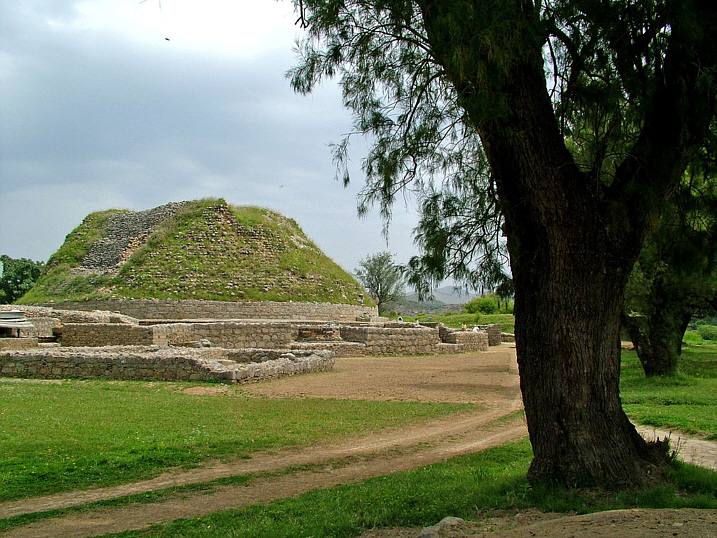
Abb.: Dharmarājika-Stūpa, Taxila
[Bildquelle: *_*. --
http://www.flickr.com/photos/o_0/9872313/. -- Zugriff am 2008-03-20. --
![]()
![]() Creative
Commons Lizenz (Namensnennung, keine kommerzielle Nutzung)]
Creative
Commons Lizenz (Namensnennung, keine kommerzielle Nutzung)]
Nach Dharmarājika der größe buddhistische Komplex. Gemäß der Inschrift auf einem Krug, war der alte Name Chaḍaśilā.
Die Böden in den Mönchsquartieren waren gestampfte Erde, in Höfen und dem Wetter ausgesetzten Plätzen waren die Böden aus Kieselsteinen oder seltener aus Steinplatten.
Von den Funden hier sei nur eine Inschrift in Karoṣṭhī-Schrift auf einer Kupferplatte, genannt die in der Reliquienkammer A1 gefunden wurde. Die Inschrift ist datiert auf das Jahr 134 des Azes (ca. 76 n. Chr.) und lautet::
Saṃvatśaraye 1 100 20 10 4 ajasa śravaṇasa masasa divase treviśe 20 1 1 1 imeṇa kṣuṇeṇa Caṃdrabhi uasia Dhramṃasa grahavatisa dhita Bhadravalasa bhaya Chaḍaśilae śarira praïstaveti gahathu—bami sadha bhraduṇa Ṇaṃdivaḍhaṇeṇa grahavatiṇa sadha putrehi Śameṇa Saïteṇa ca dhituṇa ca Dhramae sadha sṇuṣaehi Rajae Idrae ya sadha Jivaṇaṃdiṇa Śamaputreṇa ayarieṇa ya sarvasti—vaaṇa parigrahe raṭhaṇikamo puyaïta sarvasvatvaṇa puyae ṇivaṇasa pratiae hotu. In the year 134 of Azes, on the twenty-third—23—day of the month Śrāvaṇa, on this date Candrābhī, the female worshipper (upāsikā), daughter of Dharma, the householder (gṛhapati), wife of Bhadrapāla, establishes relics in Chaḍaśilā, in the stūpa shrine, together with her brother Nandivardhana, the householder, together with her sons Śama and Sacitta and her daughter Dharmā, together with her daughters-in-law Rajā and Indrā, together with Jīvanandin, the son of Śama, and her teacher, in acceptance of the Sarvāstivādas, having venerated the country-town; for the veneration of all beings; may it be for the obtainment of Nirvāṇa. [Text und Übersetzung: Sten Konow <1867 - 1948>. -- In: Marshall, John <1876 - 1958>: Taxila : an illustrated account of archaeological excavations carried out at Taxila under the orders of the Government of India between the years 1913 and 1934. -- Cambridge : Univ. Pr., 1951. -- 3 vols. -- Vol. 1: Structural remains. -- 1951. -- XIX, 397 S. -- 29 cm. -- S. 327.]
Hier befinden sich zwei Gruppen von buddhistischen Stūpas und Klöstern sowie eine Befestigung durch einen ca. 3 m dicken Festungswall, von dem noch ca. 500 m erhalten sind. Der Wall scheint aus dem 5. Jhdt n. Chr. zu zu stammen und diente vermutlich als Fluchtburg für Mönche der vielen umliegenden Klöster.
In einem der Klöster wurden 309 Münzen gefunden. Sie stammen aus den verschiedensten Zeiten und sind meist sehr abgenützt, teilweise bis zur völligen Unleserlichkeit. Dies ist wohl ein Zeichen dafür, dass Münzen sehr lange im Umlauf blieben.
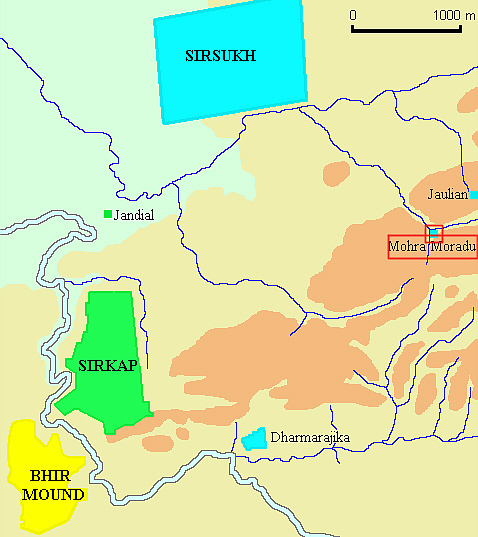
Abb.: Lage von Mohṛa Morādu
[Bildquelle: Livius. --
http://www.livius.org/a/pakistan/taxila/mohra_moradu.html. -- Zugriff am
2008-04-05. -- "© Marco Prins and Jona Lendering. Photos can be downloaded and
used for non-commercial purposes, but you have to acknowledge Livius."]
In Mohṛa Morādu befindet sich ein Stūpa und ein großes Kloster.
Sir John Marshall gibt eine sehr anschauliche Beschreibung des Klosters, die hier stellvertretend für ähnliche Klosteranlagen zitiert sei:
"monastery The monastery connected with these stūpas is as interesting as the stūpas themselves. In addition to the usual open rectangular court it comprises also several spacious chambers on its eastern side. The entrance to the rectangular court is on the north and is approached by a broad flight of steps with a landing at the top leading into a small portico. On the west wall of the portico is an arched niche containing a well preserved group of figures in high relief, namely, the Buddha in the centre and four attendant worshippers on either side.
Passing from the portico into the interior of the monastery we find ourselves in a spacious court with twenty-seven cells ranged on its four sides. In the middle of the court is a depression about 2 ft. [60 cm] deep with steps descending into it on each of its four sides, and at its south-east corner, a square platform which once supported the walls of a chamber. This, no doubt, was a bathroom (jantāghara)—an indispensable adjunct of every Buddhist monastery. Round about the depression, and at intervals of 5 ft. [150 cm] from each other, is a series of stone slabs, the upper surface of which is level with the rest of the court. These slabs acted as bases to the pillars of a broad veranda which was constructed mainly of wood, and which besides shading the fronts of the ground-floor cells served also to provide communication with the cells on the upper story. The eaves of the veranda doubtless projected beyond the pillars which supported it, so as to discharge the rain-water into the depression in the middle of the court, whence it could be carried off by a covered drain. The height of the lower story was about 12 ft. [3,70 m], as is proved by the ledge and row of socket holes, evidently intended for the timbers of the first floor, in the back walls of the cells on the south side. Access to the upper floor was [S. 159] obtained, not as might have been expected, near the entrance portico, but by way of two flights of steps in one of the cells on the south side of the building. In the lower story, the windows are placed at a height of about 8 ft. [2,40 m] from the ground, and are somewhat narrower at the top than at the bottom, contracting also considerably towards the outside. In some of the cells, but not in all, there are small niches for lamps, etc.
The interiors of the cells occupied by the monks were covered, like the rest of the monastery, with a coating of plaster, but were probably destitute of any decoration. In the verandas, on the other hand, the wall appears to have been relieved with colours, and the wood-work was no doubt carved and painted or gilded, while the courtyard was further beautified by effigies of the Buddha of superhuman size set on pedestals in front of the cells, or by groups of sacred figures in little niches in the walls. Of the larger effigies, remains of seven have survived round about the quadrangle, but only three of these are even tolerably well preserved. In each of these cases a particular interest attaches to the smaller reliefs on the front of the pedestals from the fact that they illustrate the dresses worn by lay-worshippers at the time they were set up, namely, in the fifth century a.d. Of the niches, the best preserved is the one in front of cell 4 on the left side of the monastery, the group in which depicts the Buddha seated in the dhyāna-mudrā, with attendant figures to the right and left.
A still more valuable discovery than these statues or reliefs is a stūpa, almost complete in every detail, which was found inside cell no. 9 on the left side of the monastery (Pl. xvii). It is standing to a height of 12 ft. [3,70 m.] and is circular in plan, its plinth being divided into five tiers, with elephants and Atlantes alternating in the lowest tier, and Buddhas seated in niches alternating with pilasters in the tiers above. The core of the stūpa is of kañjūr [weicher Kalkstein], and the mouldings and decorations are of stucco once bedecked with colours, namely, crimson, blue and yellow, traces of which are still visible. A central shaft of iron supported the crowning umbrellas, but in the course of ages this shaft had decayed, and the umbrellas were found lying at the side of the stūpa. The edges of the umbrellas are pierced with holes intended, apparently, for streamers or [S. 160] garlands. This stūpa is, I believe, the most perfect one of its kind yet discovered in the North-West, and as such possesses a very exceptional antiquarian value. As in the case of the stūpas in cells E 1 at the Dharmarājika and F 12 at Kālawn, this stūpa at Mohṛā Morādu was no doubt erected as a memorial to some much revered member of the saṅgha who had occupied cell 9.
Apart from the 'court of cells', where the monks resided, and the bathroom (jantāghara) described above, the essential parts of a Buddhist monastery in the medieval ages were a hall of assembly (upasthāna-śālā), a refectory (upāhāra-śālā), a kitchen (agni-śālā) a store-room (koṣṭhaka) and a latrine (varcaḥ-kuṭī). In the Mohṛā Morādu monastery, these latter apartments are placed on the east side of the court of cells and are reached through a doorway in cell no. 7. Among them the hall of assembly is readily recognisable in the square and spacious apartment at the northern end, the roof of which was once supported by four columns. Of the others the identity is not so easy to determine, particularly as this part of the monastery was largely rebuilt and added to in later days. But comparing the chambers with those in the contemporary monastery at Jauliāñ, which was planned on very similar lines, we may infer that the room next to the hall of assembly was a kitchen, with a small larder and store-room attached, the latter being the small and massive rotunda at the south-east corner, the former the rectangular closet with raised benches on two of its sides. And we may surmise, further, that the two rooms at the south end served originally as a refectory and steward's room, though the latter was subsequently converted into a bathroom by raising its floor some 8 ft. and constructing therein a reservoir, with a water-channel leading down into the middle chamber. When this change took place, the refectory was perhaps combined with the assembly hall.
It remains to add that the original walls of this monastery are in a rather late variety of the large diaper style, and may be assigned on these and other grounds to the second century a.d. The additions and repairs are in the late semi-ashlar style and were executed some two centuries or more later. Many coins of the Kuṣāṇn kings, [S. 161] Huvishka and Vāsudeva, were discovered on the floor of the monastery. Among other minor antiquities found here was one remarkably fine Gandhāra statue of the Bodhisattva Maitreya (Pl. xviii) in almost perfect preservation, several terracotta images of the Buddha which had fallen from the niches in the court, and a massive steatite seal of the Gupta period belonging to one Hariścandra."
[Quelle: Marshall, John <1876 - 1958>: A guide to Taxila / by Sir John Marshall. - 4. ed.. - Karachi : Sani Communications, 1983. - V, 195 S. : Ill. ; 23 cm. -- Cambridge : University Press, for the Dept. of Archaeology in Pakistan, 1960. -- S. 158 - 161.]
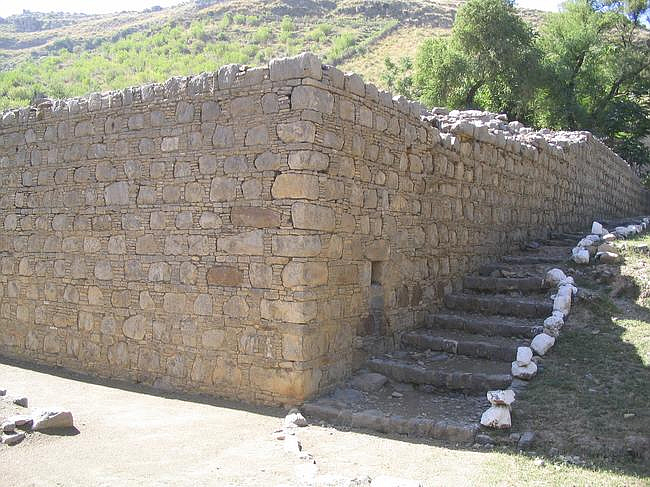
Abb.: Mohṛa Morādu
[Bildquelle: Livius. --
http://www.livius.org/a/pakistan/taxila/mohra_moradu.html. -- Zugriff am
2008-04-05. -- "© Marco Prins and Jona Lendering. Photos can be downloaded and
used for non-commercial purposes, but you have to acknowledge Livius."]
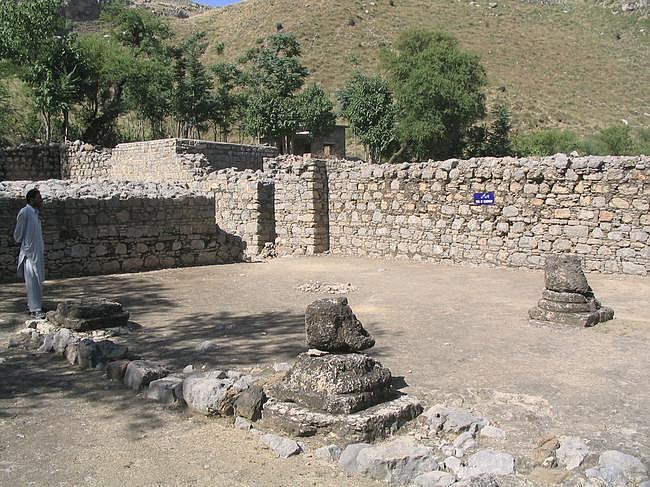
Abb.: Mohṛa Morādu
[Bildquelle: Livius. --
http://www.livius.org/a/pakistan/taxila/mohra_moradu.html. -- Zugriff am
2008-04-05. -- "© Marco Prins and Jona Lendering. Photos can be downloaded and
used for non-commercial purposes, but you have to acknowledge Livius."]
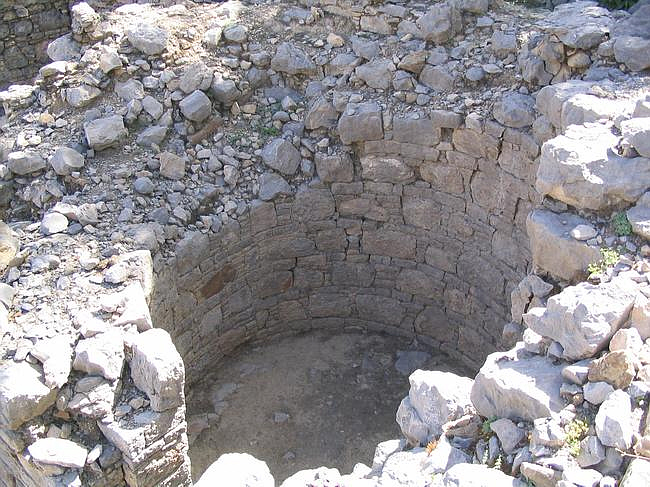
Abb.: Mohṛa Morādu, Speicher
[Bildquelle: Livius. --
http://www.livius.org/a/pakistan/taxila/mohra_moradu.html. -- Zugriff am
2008-04-05. -- "© Marco Prins and Jona Lendering. Photos can be downloaded and
used for non-commercial purposes, but you have to acknowledge Livius."]
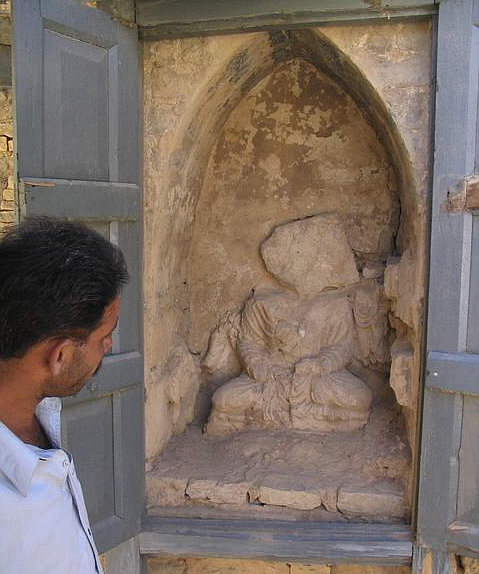
Abb.: Mohṛa Morādu, Schrein
[Bildquelle: Livius. --
http://www.livius.org/a/pakistan/taxila/mohra_moradu.html. -- Zugriff am
2008-04-05. -- "© Marco Prins and Jona Lendering. Photos can be downloaded and
used for non-commercial purposes, but you have to acknowledge Livius."]
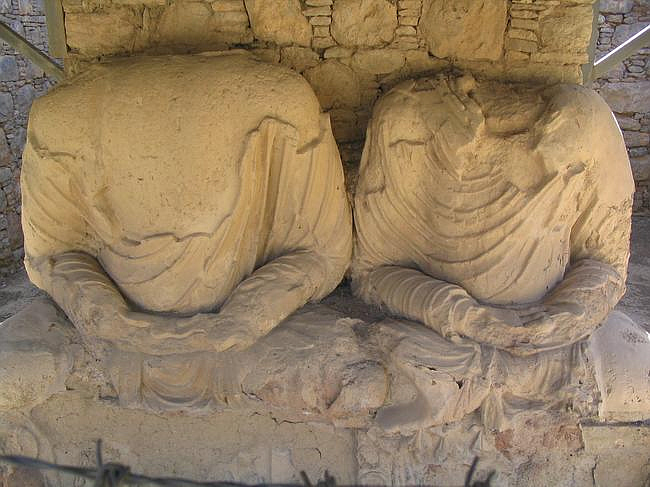
Abb.: Mohṛa Morādu
[Bildquelle: Livius. --
http://www.livius.org/a/pakistan/taxila/mohra_moradu.html. -- Zugriff am
2008-04-05. -- "© Marco Prins and Jona Lendering. Photos can be downloaded and
used for non-commercial purposes, but you have to acknowledge Livius."]
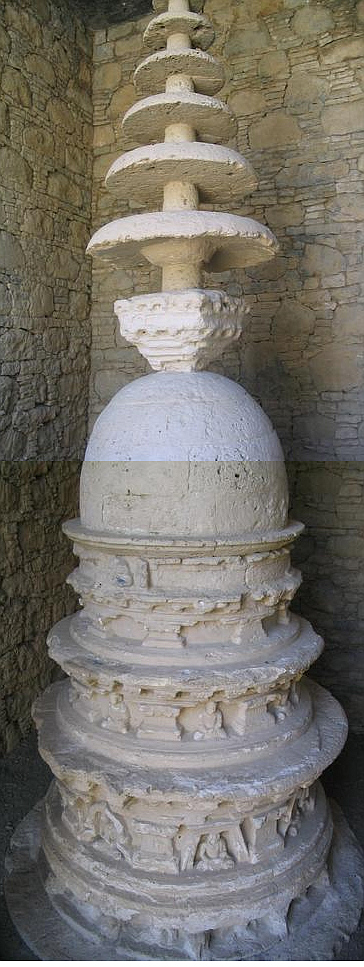
Abb.: Mohṛa Morādu, fast 4 m hoch
[Bildquelle: Livius. --
http://www.livius.org/a/pakistan/taxila/mohra_moradu.html. -- Zugriff am
2008-04-05. -- "© Marco Prins and Jona Lendering. Photos can be downloaded and
used for non-commercial purposes, but you have to acknowledge Livius."]
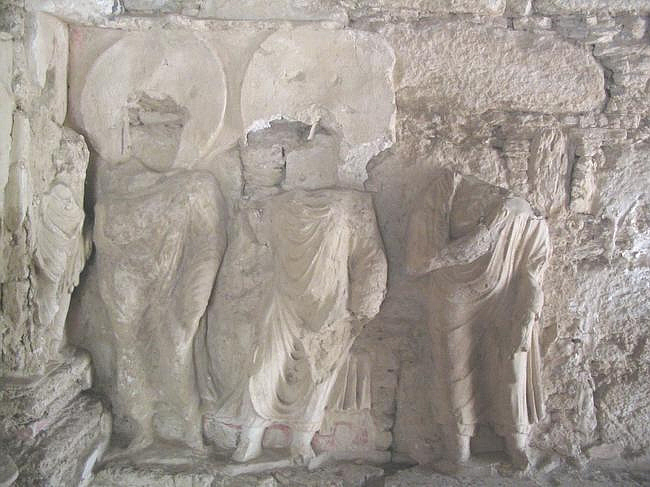
Abb.: Mohṛa Morādu, Stucco
[Bildquelle: Livius. --
http://www.livius.org/a/pakistan/taxila/mohra_moradu.html. -- Zugriff am
2008-04-05. -- "© Marco Prins and Jona Lendering. Photos can be downloaded and
used for non-commercial purposes, but you have to acknowledge Livius."]
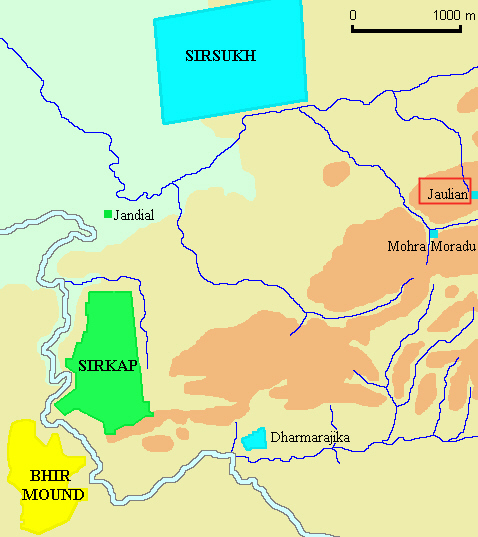
Abb.: Lage von Jaulian
[Bildquelle: Livius. --
http://www.livius.org/a/pakistan/taxila/bhir.html. -- Zugriff am 2008-04-05.
-- "© Marco Prins and Jona Lendering. Photos can be downloaded and used for
non-commercial purposes, but you have to acknowledge Livius."]
Ein mittelgroßer buddhistischer Komplex auf einem ca. 90 m hohen Hügel.
In Zelle 29 wurde eine durch Feuer stark zerstörte Handschrift auf Birkenrinde in Brāhmī-Schrift der Gupta-Zeit gefunden.

Abb.: Panorama Jaulian
[Bildquelle: Waqas Usman. -- Wikipedia. -- Creative Commons Lizenz
![]() (Namensnennung,
Share alike)]
(Namensnennung,
Share alike)]
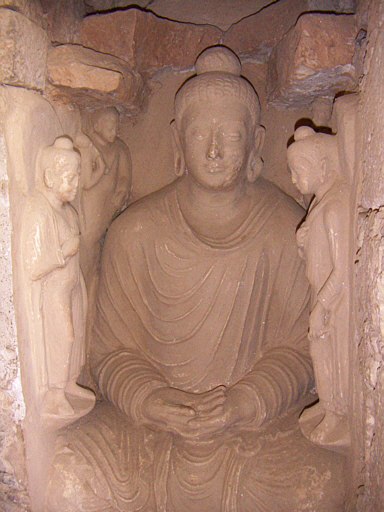
Abb.: Buddha, Jaulian
[Bildquelle: xitus. --
http://www.flickr.com/photos/frozen_impermanence/249971039/. -- Zugriff am
2008-03-20. --
![]()
![]()
![]() Creative
Commons Lizenz (Namensnennung, keine kommerzielle Nutzung, keine Bearbeitung)]
Creative
Commons Lizenz (Namensnennung, keine kommerzielle Nutzung, keine Bearbeitung)]
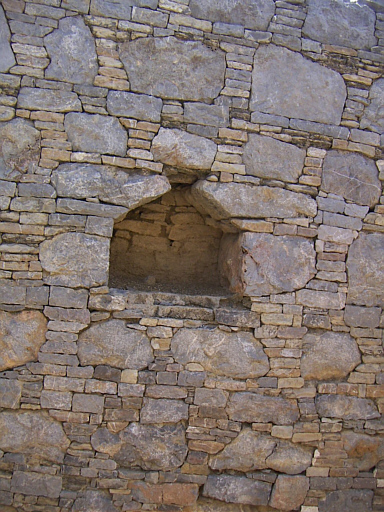
Mauer, Jaulian
[Bildquelle: xitus. --
http://www.flickr.com/photos/frozen_impermanence/249969676/. -- Zugriff am
2008-03-20. --
![]()
![]()
![]() Creative
Commons Lizenz (Namensnennung, keine kommerzielle Nutzung, keine Bearbeitung)]
Creative
Commons Lizenz (Namensnennung, keine kommerzielle Nutzung, keine Bearbeitung)]
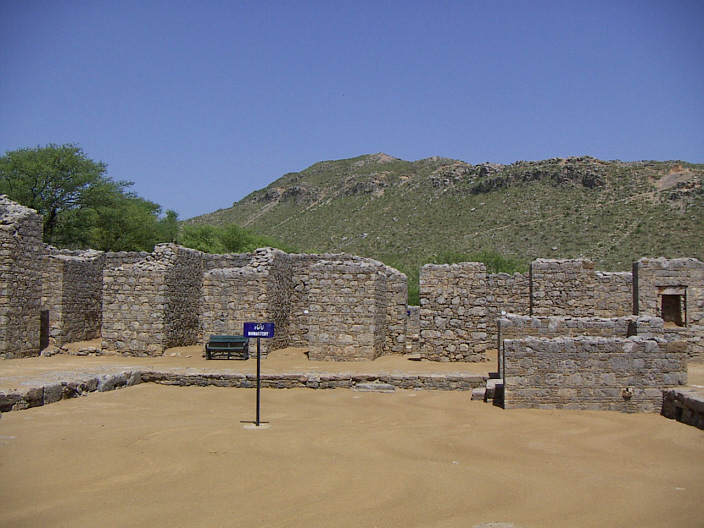
Abb.: Klosterruinen, Jaulian
[Bildquelle: xitus. --
http://www.flickr.com/photos/frozen_impermanence/249969674/. -- Zugriff am
2008-03-20. --
![]()
![]()
![]() Creative
Commons Lizenz (Namensnennung, keine kommerzielle Nutzung, keine Bearbeitung)]
Creative
Commons Lizenz (Namensnennung, keine kommerzielle Nutzung, keine Bearbeitung)]
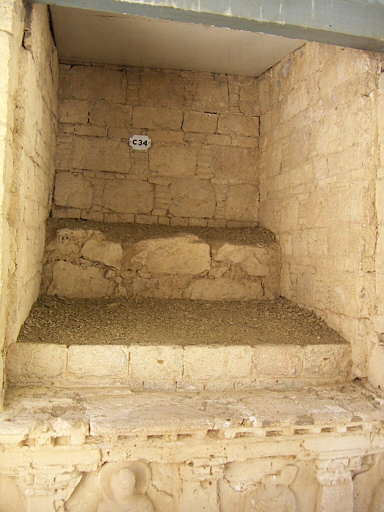
Abb.: Mönchszelle, Jaulian
[Bildquelle: xitus. --
http://www.flickr.com/photos/frozen_impermanence/249971033/. -- Zugriff am
2008-03-20. --
![]()
![]()
![]() Creative
Commons Lizenz (Namensnennung, keine kommerzielle Nutzung, keine Bearbeitung)]
Creative
Commons Lizenz (Namensnennung, keine kommerzielle Nutzung, keine Bearbeitung)]
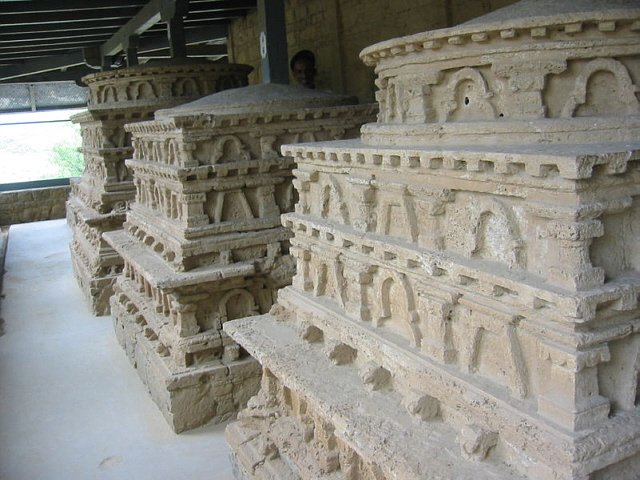
Abb.: Jaulian
[Bildquelle. Wikipedia, GNU FDLicense]
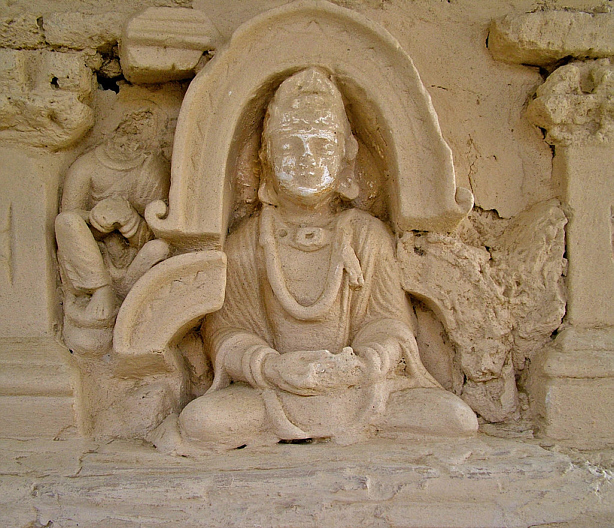
Abb.: Buddha, Jaulian
[Bildquelle: *_*. --
http://www.flickr.com/photos/o_0/9873687/. -- Zugriff am 2008-03-20. --
![]()
![]() Creative
Commons Lizenz (Namensnennung, keine kommerzielle Nutzung)]
Creative
Commons Lizenz (Namensnennung, keine kommerzielle Nutzung)]
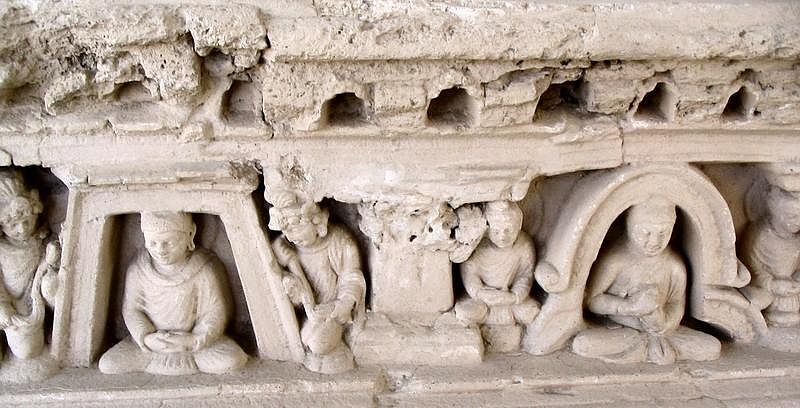
Abb.: Jaulian
[Bildquelle: Livius. --
http://www.livius.org/a/pakistan/taxila/jaulian.html. -- Zugriff am
2008-04-05. -- "© Marco Prins and Jona Lendering. Photos can be downloaded and
used for non-commercial purposes, but you have to acknowledge Livius."]
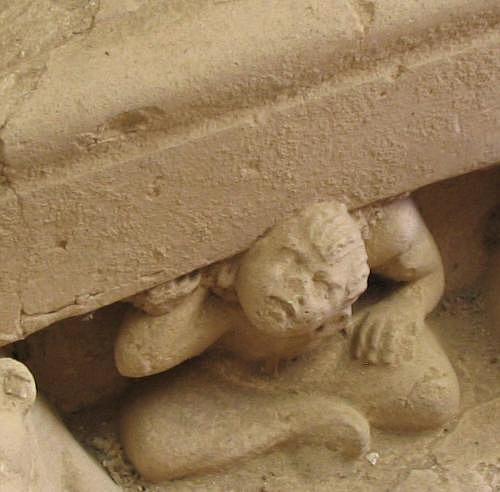
Abb.: Jaulian
[Bildquelle: Livius. --
http://www.livius.org/a/pakistan/taxila/jaulian.html. -- Zugriff am
2008-04-05. -- "© Marco Prins and Jona Lendering. Photos can be downloaded and
used for non-commercial purposes, but you have to acknowledge Livius."]
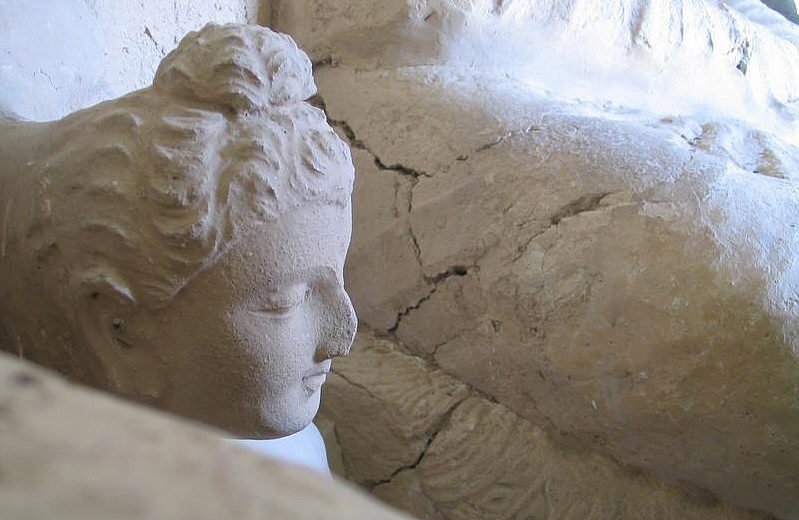
Abb.: Jaulian
[Bildquelle: Livius. --
http://www.livius.org/a/pakistan/taxila/jaulian.html. -- Zugriff am
2008-04-05. -- "© Marco Prins and Jona Lendering. Photos can be downloaded and
used for non-commercial purposes, but you have to acknowledge Livius."]
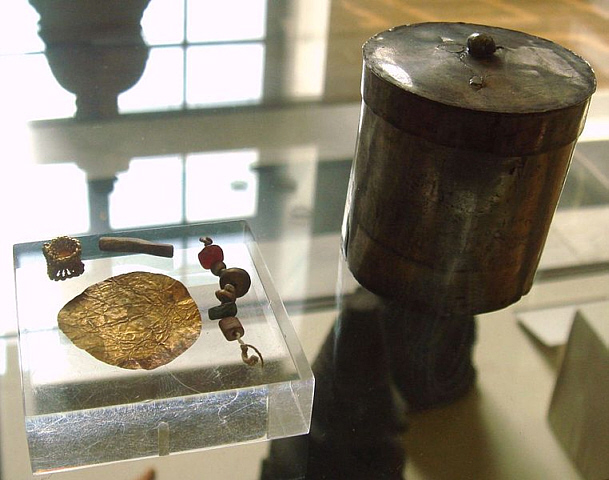
Abb.: Buddhistischer Reliquienbehälter mit Inhalt, Jaulian
[Bildquelle: Wikipedia, GNU FDLicense]
In Bhallaṛ stand nach Xuánzàng (Hsüan-tsan) (玄奘) (603 - 664) ein Stūpa, der auf Aśoka zurückging. Er wurde hier errichtet, da dies angeblich die Stelle ist, an der der zukünftige Buddha Gautama als Bodhisattva Candraprabha dem Brahmaen Rudrāksha seinen eigenen Kopf schenkte. Man hat aber keine Spuren dieses ursprünglichen Stūpa gefunden.
Die Kleinfunde sind vorbildlich dokumentiert im zweiten Band von Marshalls großer Texila-Monographie:
Marshall, John <1876 - 1958>: Taxila : an illustrated account of archaeological excavations carried out at Taxila under the orders of the Government of India between the years 1913 and 1934. -- Cambridge : Univ. Pr., 1951. -- 3 vols. -- Vol. 2: Minor antiquities. -- 1951. - XV, S.399 - 895.
Marshall teilt die Kleinfunde ein in:
Dieser Band ist eine unschätzbare Fundquelle, deren Benutzung ich eindringlich empfehle.
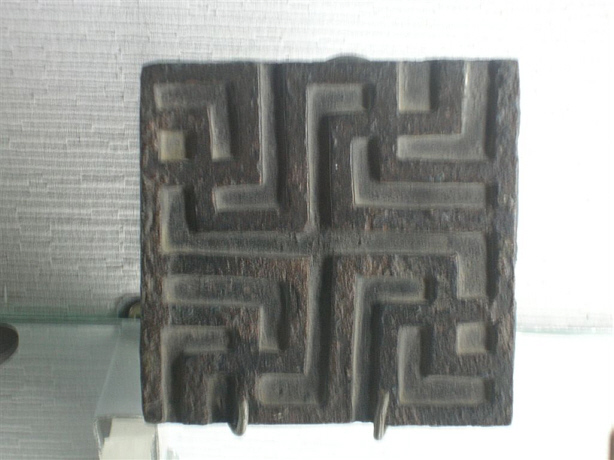
[Bildquelle: Hemanshu Kumar. --
http://www.flickr.com/photos/hemanshu/86180313/in/set-72057594047840814/. --
Zugriff am 2008-04-08. --
![]()
![]()
![]() Creative
Commons Lizenz (Namensnennung, keine kommerzielle Nutzung, keine Bearbeitung)]
Creative
Commons Lizenz (Namensnennung, keine kommerzielle Nutzung, keine Bearbeitung)]
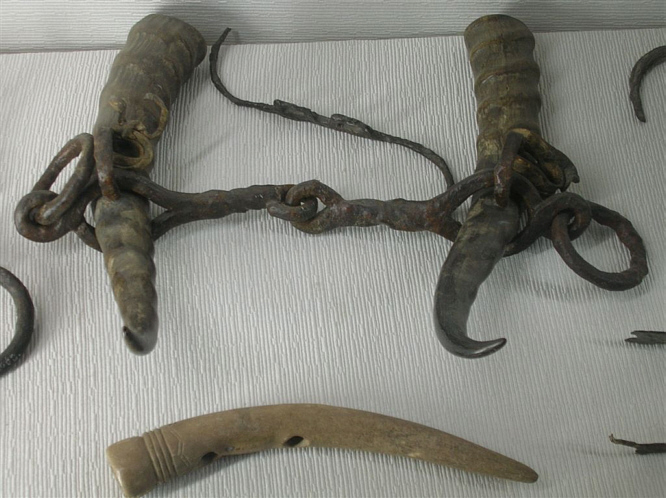
[Bildquelle: Hemanshu Kumar. --
http://www.flickr.com/photos/hemanshu/86180197/in/set-72057594047840814/. --
Zugriff am 2008-04-08. --
![]()
![]()
![]() Creative
Commons Lizenz (Namensnennung, keine kommerzielle Nutzung, keine Bearbeitung)]
Creative
Commons Lizenz (Namensnennung, keine kommerzielle Nutzung, keine Bearbeitung)]
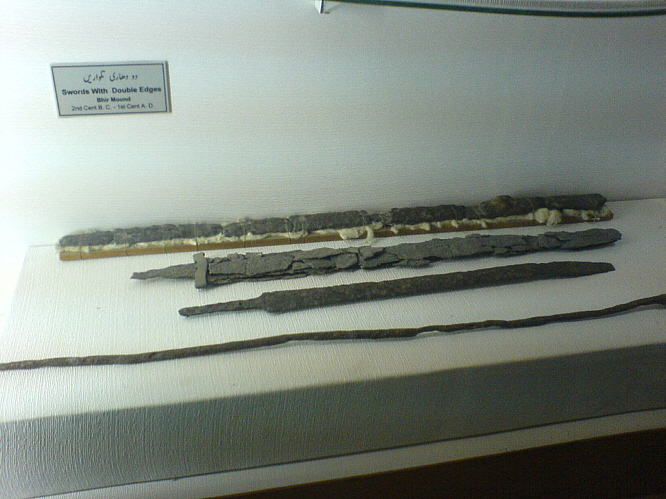
Abb.: doppelschneidige Schwerter, Bhiṛ Mound
[Bildquelle: Saadia Malik. --
http://www.flickr.com/photos/saadiamalik/222009608/. -- Zugriff am
2008-04-08. --
![]() Creative
Commons Lizenz (Namensnennung)]
Creative
Commons Lizenz (Namensnennung)]
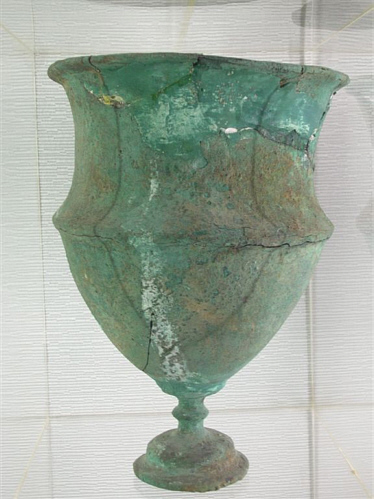
[Bildquelle: Hemanshu Kumar. --
http://www.flickr.com/photos/hemanshu/86179901/in/set-72057594047840814/. --
Zugriff am 2008-04-08. --
![]()
![]()
![]() Creative
Commons Lizenz (Namensnennung, keine kommerzielle Nutzung, keine Bearbeitung)]
Creative
Commons Lizenz (Namensnennung, keine kommerzielle Nutzung, keine Bearbeitung)]
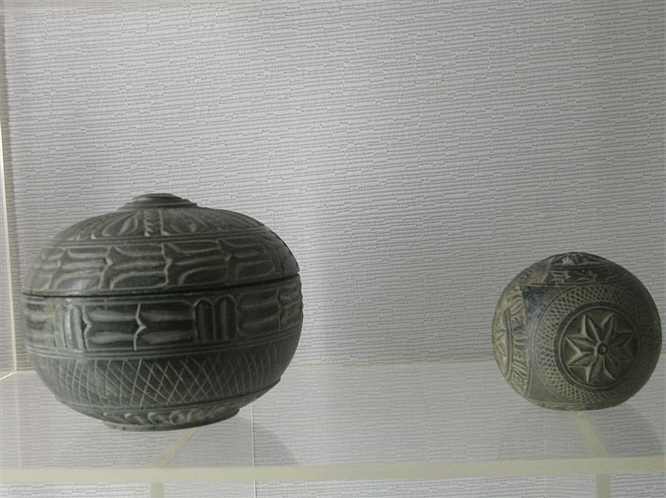
[Bildquelle: Hemanshu Kumar. --
http://www.flickr.com/photos/hemanshu/86179008/in/set-72057594047840814/. --
Zugriff am 2008-04-08. --
![]()
![]()
![]() Creative
Commons Lizenz (Namensnennung, keine kommerzielle Nutzung, keine Bearbeitung)]
Creative
Commons Lizenz (Namensnennung, keine kommerzielle Nutzung, keine Bearbeitung)]
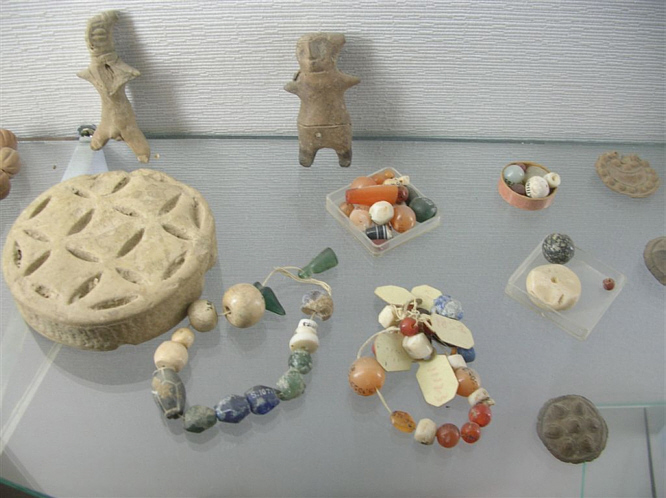
[Bildquelle: Hemanshu Kumar. --
http://www.flickr.com/photos/hemanshu/86179713/in/set-72057594047840814/. --
Zugriff am 2008-04-08. --
![]()
![]()
![]() Creative
Commons Lizenz (Namensnennung, keine kommerzielle Nutzung, keine Bearbeitung)]
Creative
Commons Lizenz (Namensnennung, keine kommerzielle Nutzung, keine Bearbeitung)]
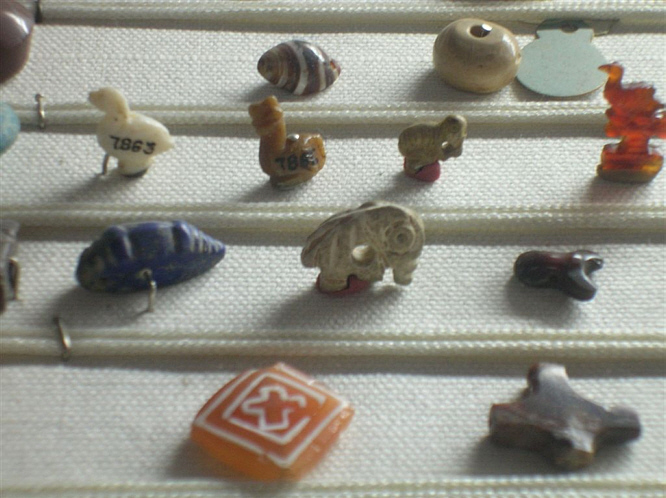
[Bildquelle: Hemanshu Kumar. --
http://www.flickr.com/photos/hemanshu/86179227/in/set-72057594047840814/. --
Zugriff am 2008-04-08. --
![]()
![]()
![]() Creative
Commons Lizenz (Namensnennung, keine kommerzielle Nutzung, keine Bearbeitung)]
Creative
Commons Lizenz (Namensnennung, keine kommerzielle Nutzung, keine Bearbeitung)]

[Bildquelle: Hemanshu Kumar. --
http://www.flickr.com/photos/hemanshu/86180118/in/set-72057594047840814/. --
Zugriff am 2008-04-08. --
![]()
![]()
![]() Creative
Commons Lizenz (Namensnennung, keine kommerzielle Nutzung, keine Bearbeitung)]
Creative
Commons Lizenz (Namensnennung, keine kommerzielle Nutzung, keine Bearbeitung)]
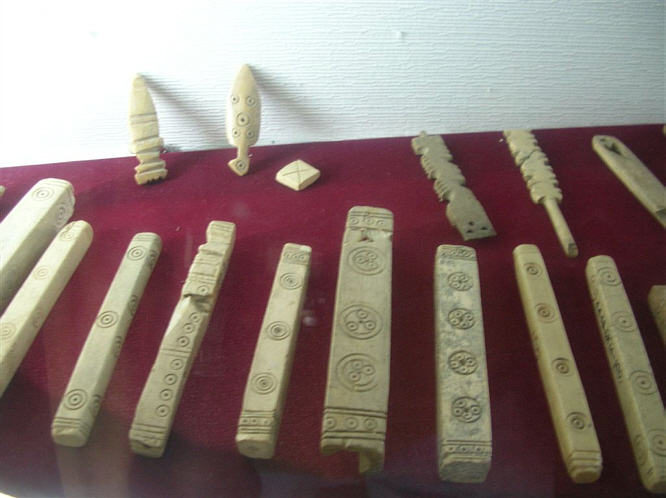
[Bildquelle: Hemanshu Kumar. --
http://www.flickr.com/photos/hemanshu/86179968/in/set-72057594047840814/. --
Zugriff am 2008-04-08. --
![]()
![]()
![]() Creative
Commons Lizenz (Namensnennung, keine kommerzielle Nutzung, keine Bearbeitung)]
Creative
Commons Lizenz (Namensnennung, keine kommerzielle Nutzung, keine Bearbeitung)]
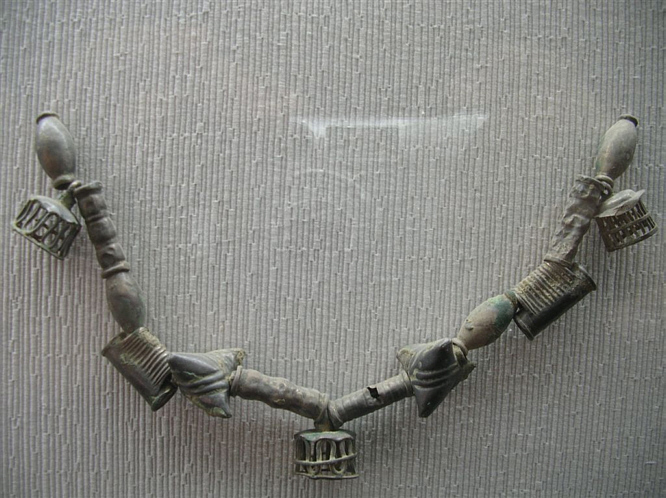
[Bildquelle: Hemanshu Kumar. --
http://www.flickr.com/photos/hemanshu/86179375/in/set-72057594047840814/. --
Zugriff am 2008-04-08. --
![]()
![]()
![]() Creative
Commons Lizenz (Namensnennung, keine kommerzielle Nutzung, keine Bearbeitung)]
Creative
Commons Lizenz (Namensnennung, keine kommerzielle Nutzung, keine Bearbeitung)]
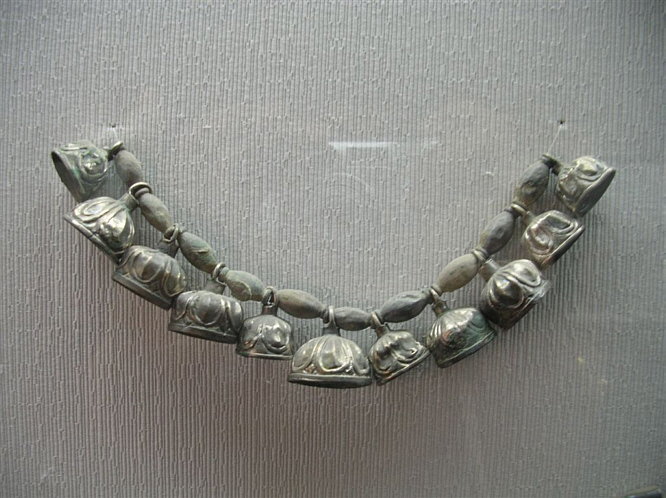
[Bildquelle: Hemanshu Kumar. --
http://www.flickr.com/photos/hemanshu/86179324/in/set-72057594047840814/. --
Zugriff am 2008-04-08. --
![]()
![]()
![]() Creative
Commons Lizenz (Namensnennung, keine kommerzielle Nutzung, keine Bearbeitung)]
Creative
Commons Lizenz (Namensnennung, keine kommerzielle Nutzung, keine Bearbeitung)]
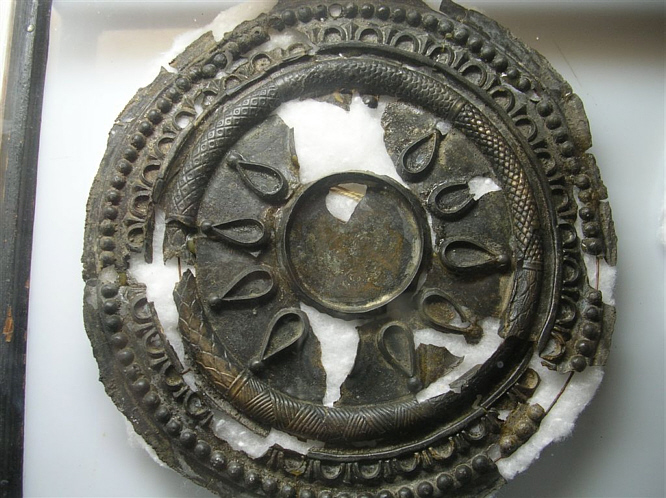
[Bildquelle: Hemanshu Kumar. --
http://www.flickr.com/photos/hemanshu/86178934/in/set-72057594047840814/. --
Zugriff am 2008-04-08. --
![]()
![]()
![]() Creative
Commons Lizenz (Namensnennung, keine kommerzielle Nutzung, keine Bearbeitung)]
Creative
Commons Lizenz (Namensnennung, keine kommerzielle Nutzung, keine Bearbeitung)]
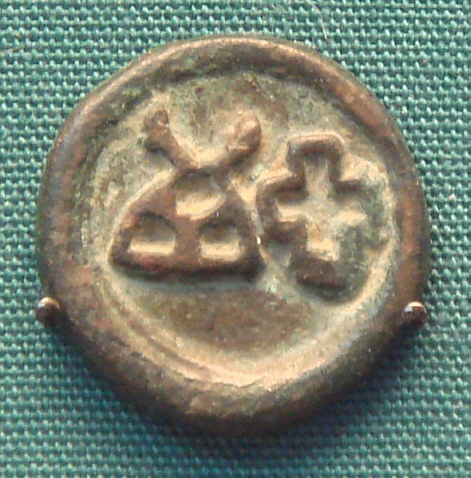
Abb.: Münze, Taxila
[Bildquelle: Wikipedia, GNU FDLicense]
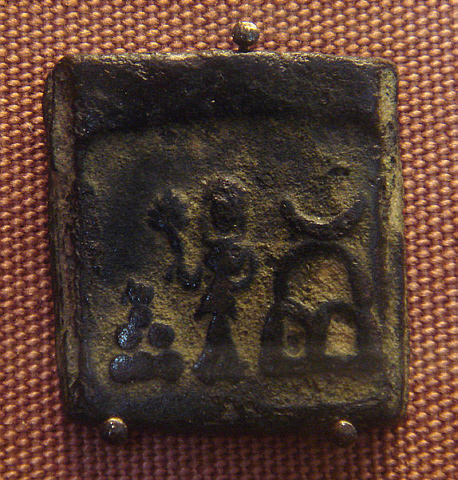
Abb.: Münze, Taxila
[Bildquelle: Wikipedia, GNU FDLicense]
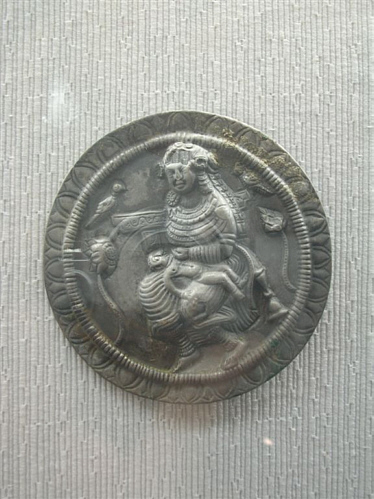
[Bildquelle: Hemanshu Kumar. --
http://www.flickr.com/photos/hemanshu/86179713/in/set-72057594047840814/. --
Zugriff am 2008-04-08. --
![]()
![]()
![]() Creative
Commons Lizenz (Namensnennung, keine kommerzielle Nutzung, keine Bearbeitung)]
Creative
Commons Lizenz (Namensnennung, keine kommerzielle Nutzung, keine Bearbeitung)]
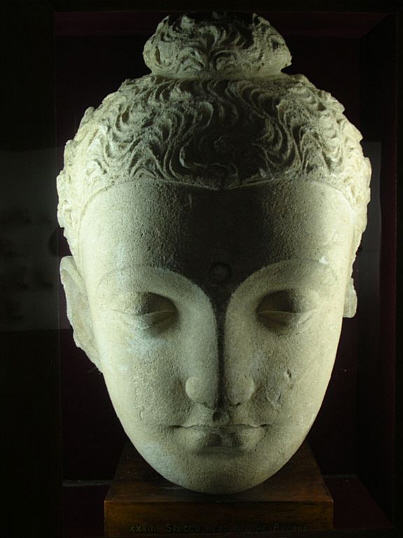
Abb.: Buddha, Taxila
[Bildquelle: Hemanshu Kumar. --
http://www.flickr.com/photos/hemanshu/86179047/. -- Zugriff am 2008-04-08.
--
![]()
![]()
![]() Creative
Commons Lizenz (Namensnennung, keine kommerzielle Nutzung, keine Bearbeitung)]
Creative
Commons Lizenz (Namensnennung, keine kommerzielle Nutzung, keine Bearbeitung)]
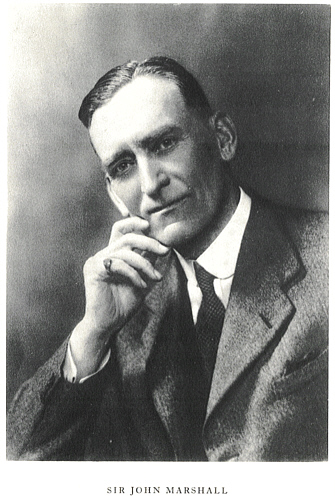
Abb.: Vortitelblatt
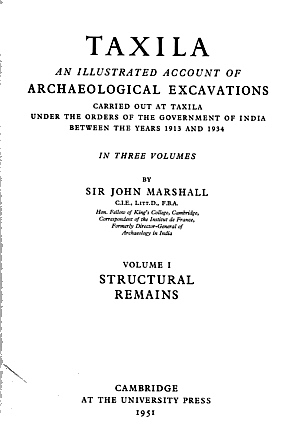
Abb.: Titelblatt
Marshall, John <1876 - 1958>: Taxila : an illustrated account of archaeological excavations carried out at Taxila under the orders of the Government of India between the years 1913 and 1934. -- Cambridge : Univ. Pr., 1951. -- 3 vols.
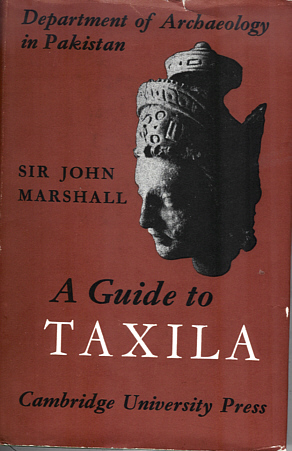
Abb.: Umschlagtitel
Marshall, John <1876 - 1958>: A guide to Taxila / by Sir John Marshall. - 4. ed.. - Karachi : Sani Communications, 1983. - V, 195 S. : Ill. ; 23 cm. -- Cambridge : University Press, for the Dept. of Archaeology in Pakistan, 1960
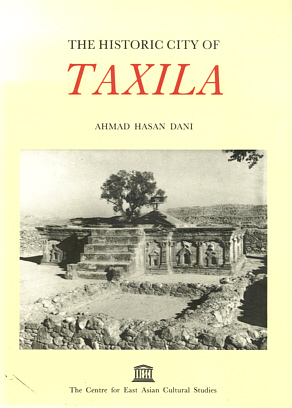
Abb.: Einbandtitel
Dani, Ahmad Hasan <1920 - >: The historic city of Taxila / Ahmad Hasan Dani. -- Tokyo : Centre for East Asian Cultural Studies [u.a.], 1986. -- XV, 190 S. : Ill. -- ISBN 92-3-102361-6
Zu: 5.2. Indian Architecture / by James Burgess (1910)